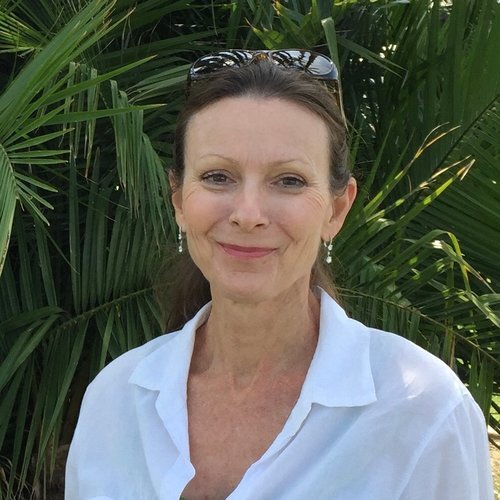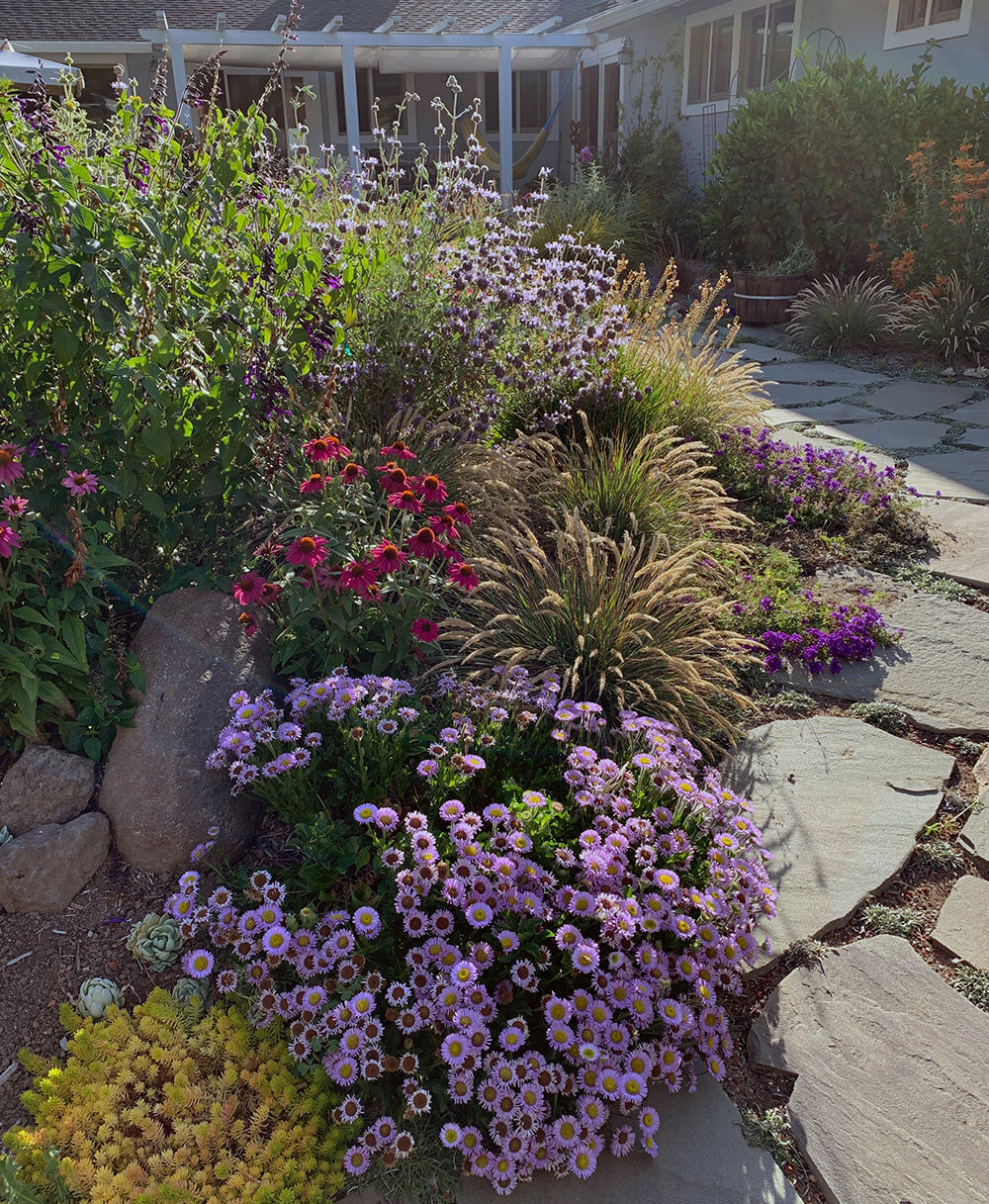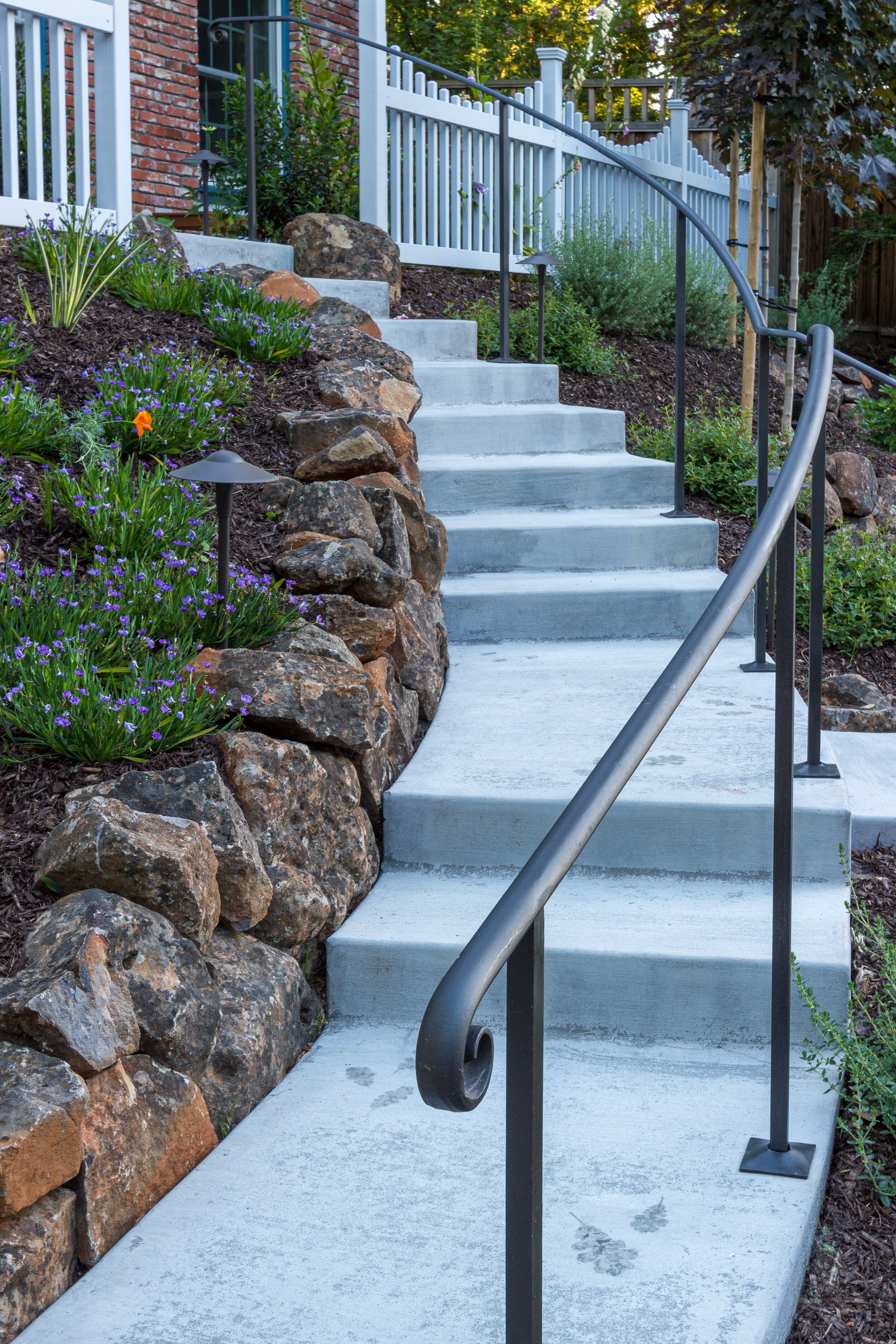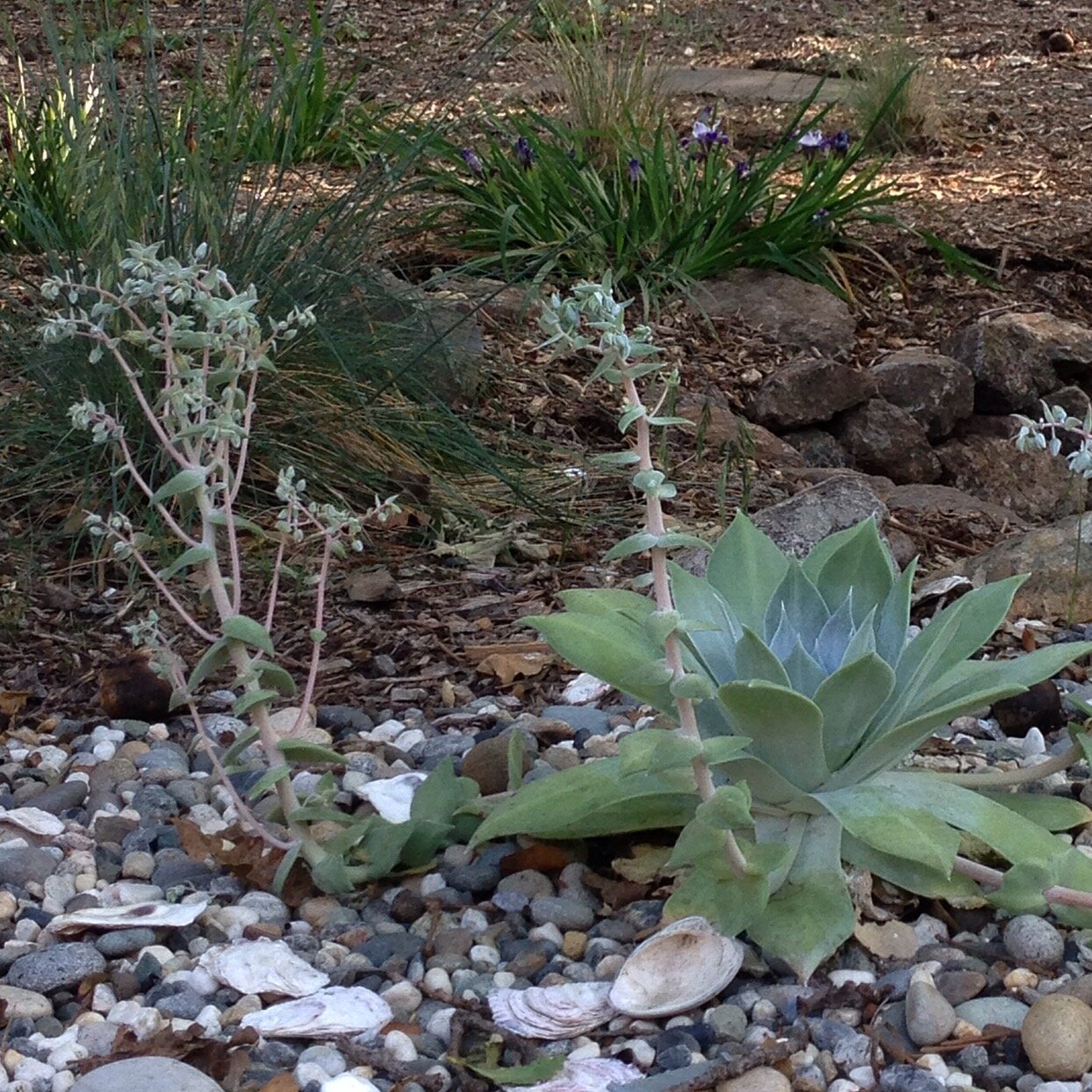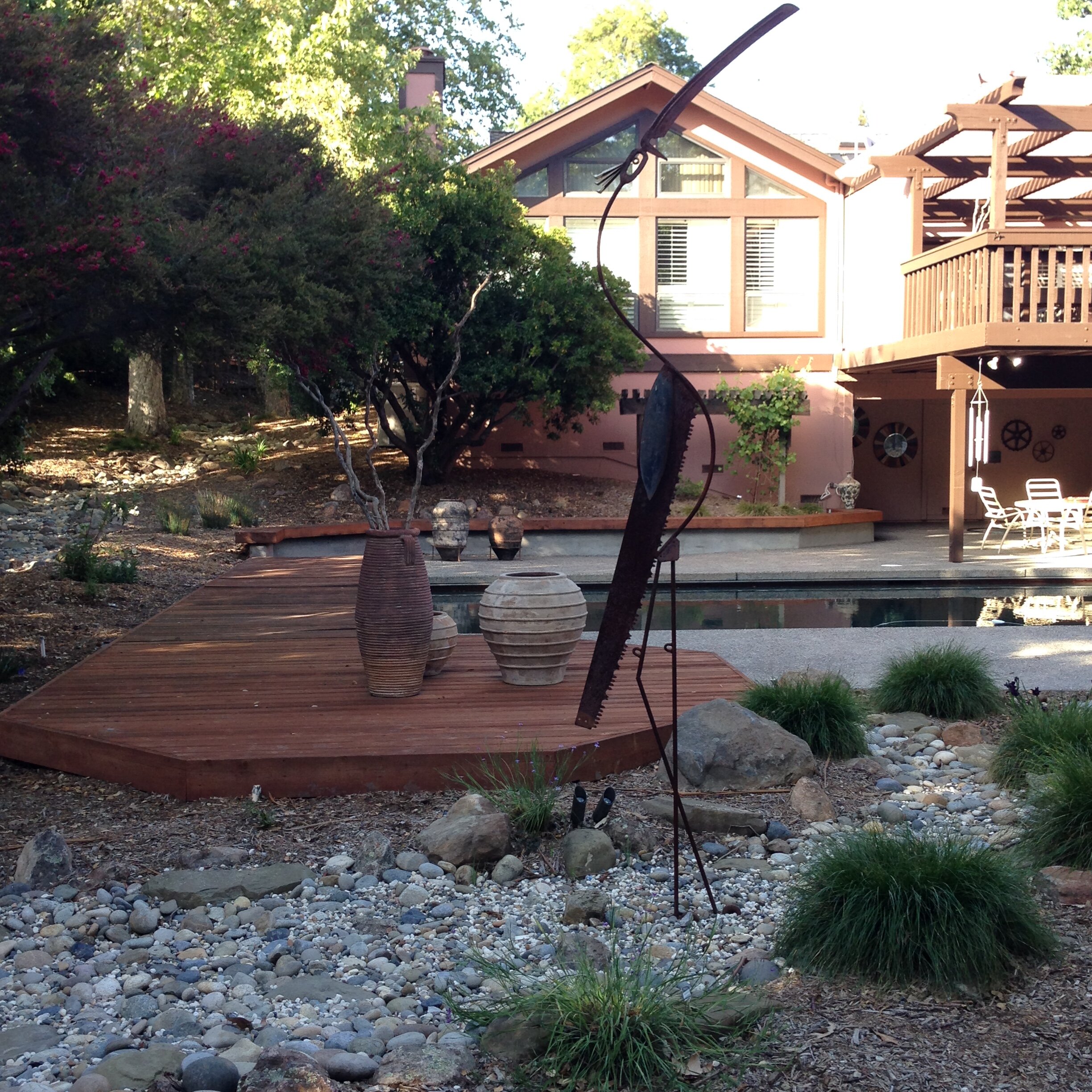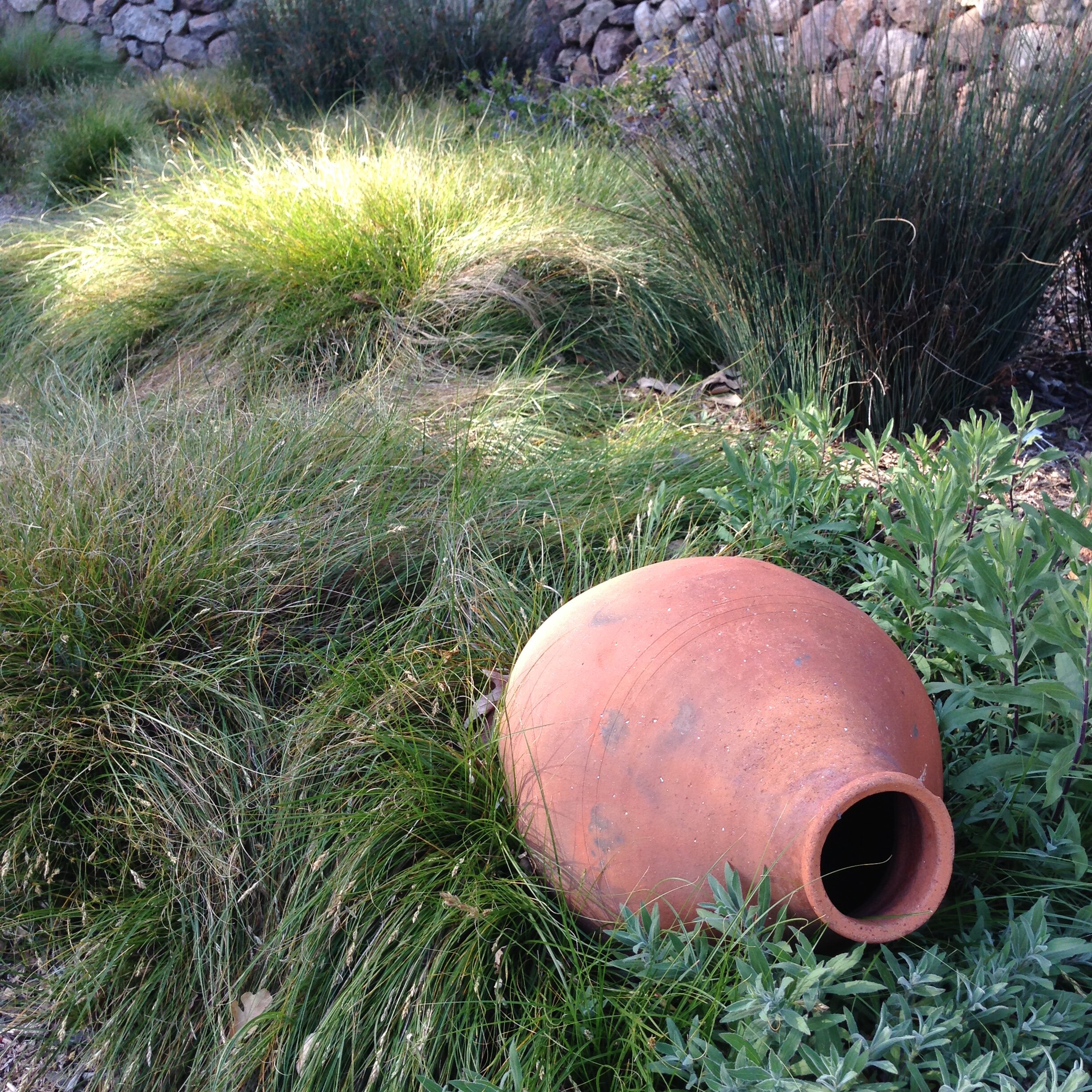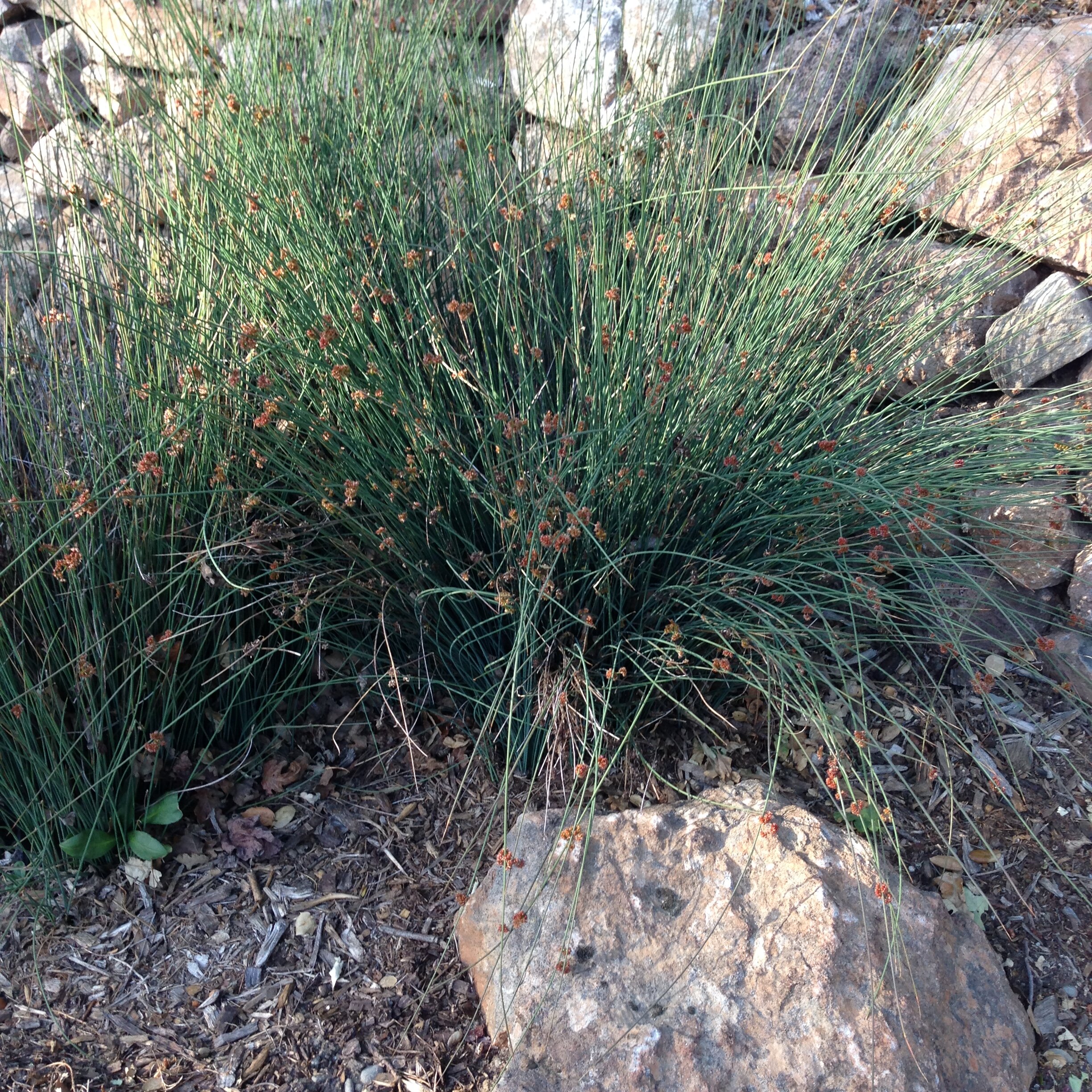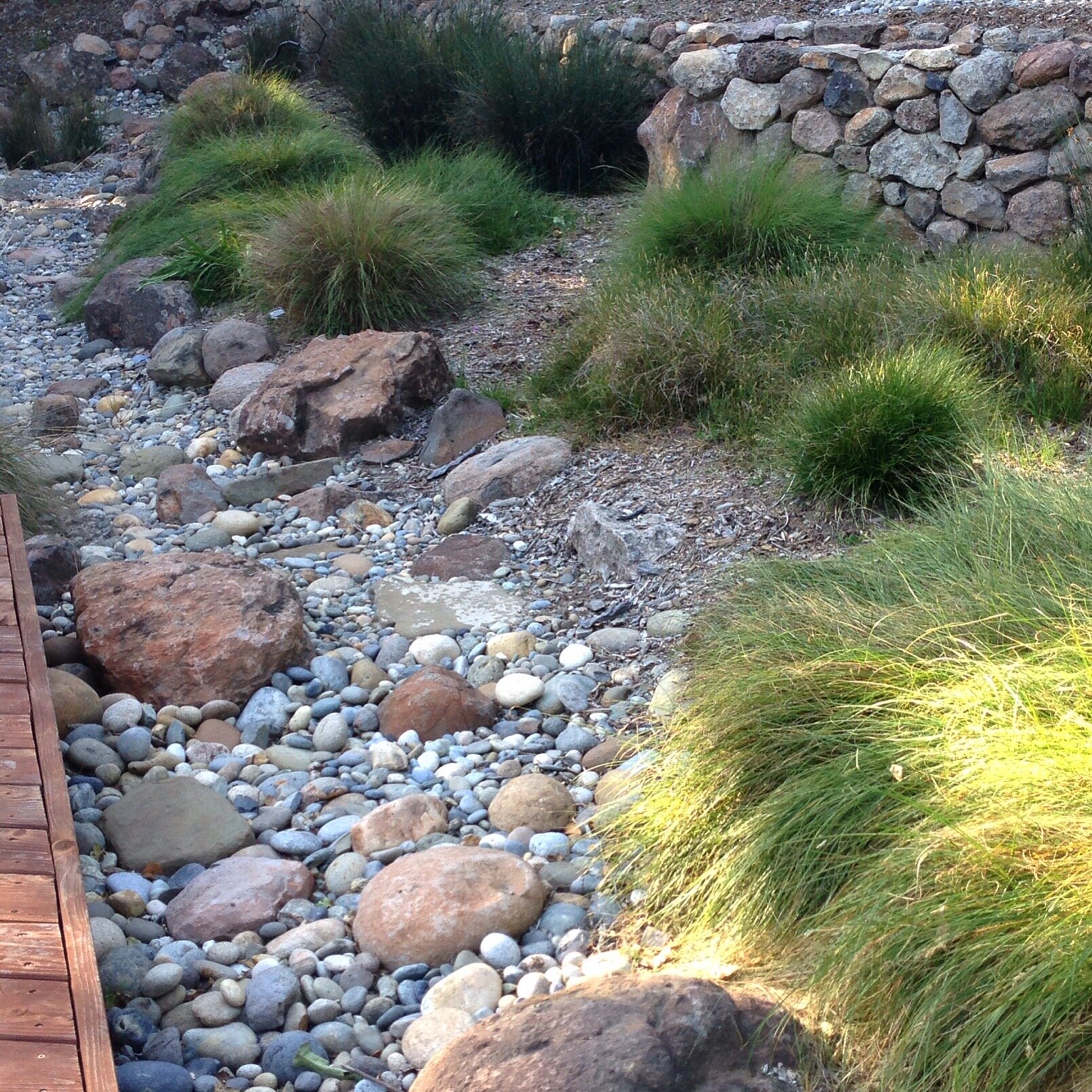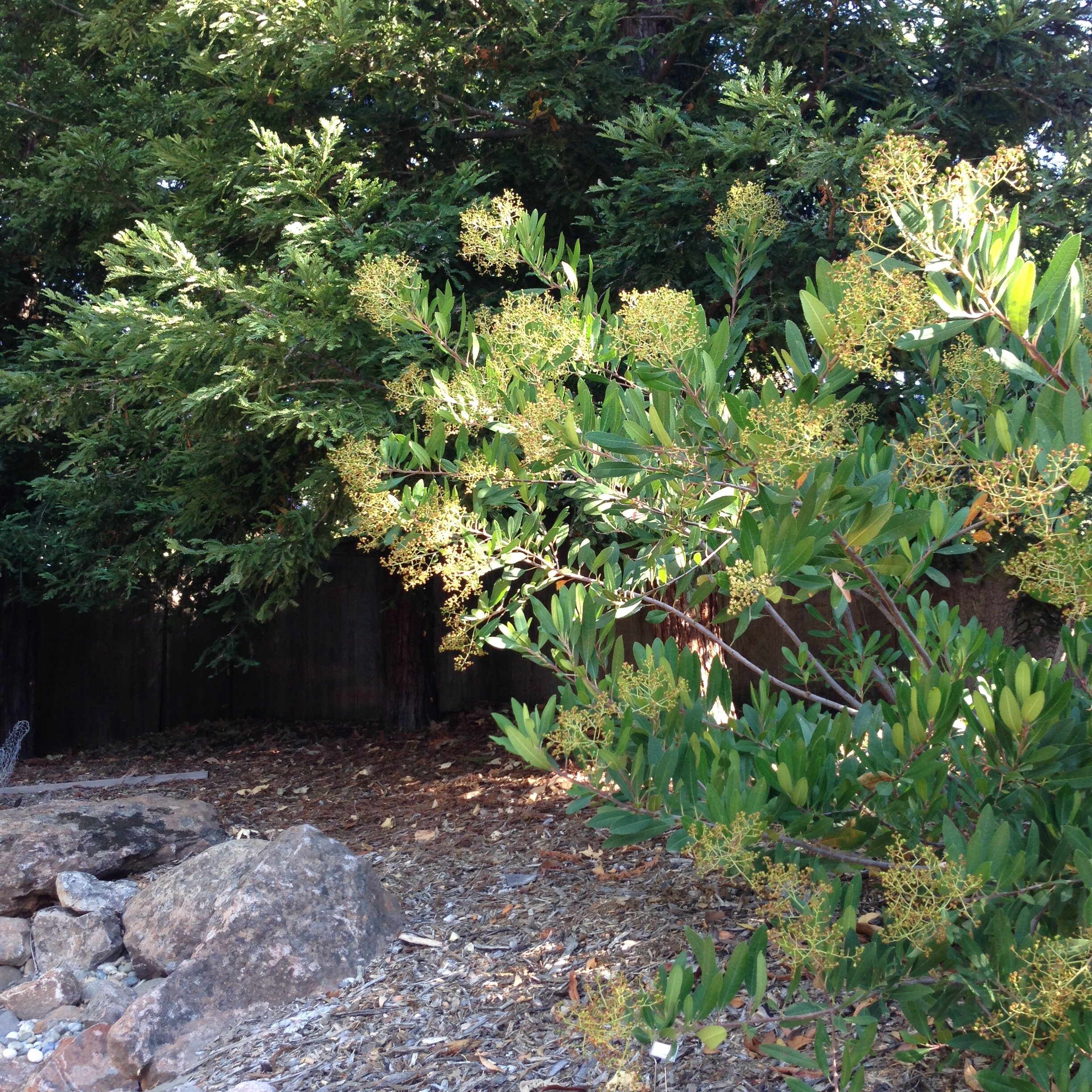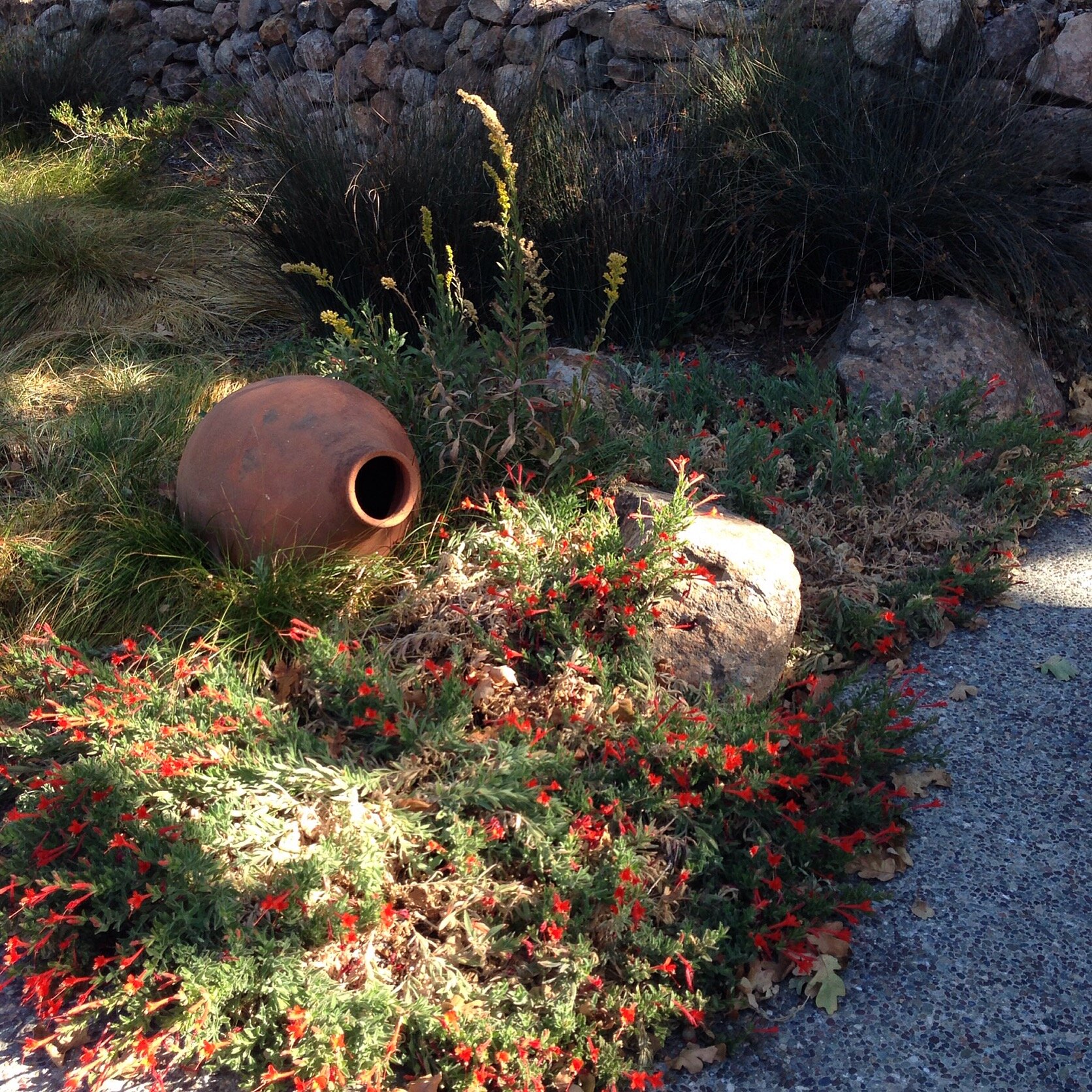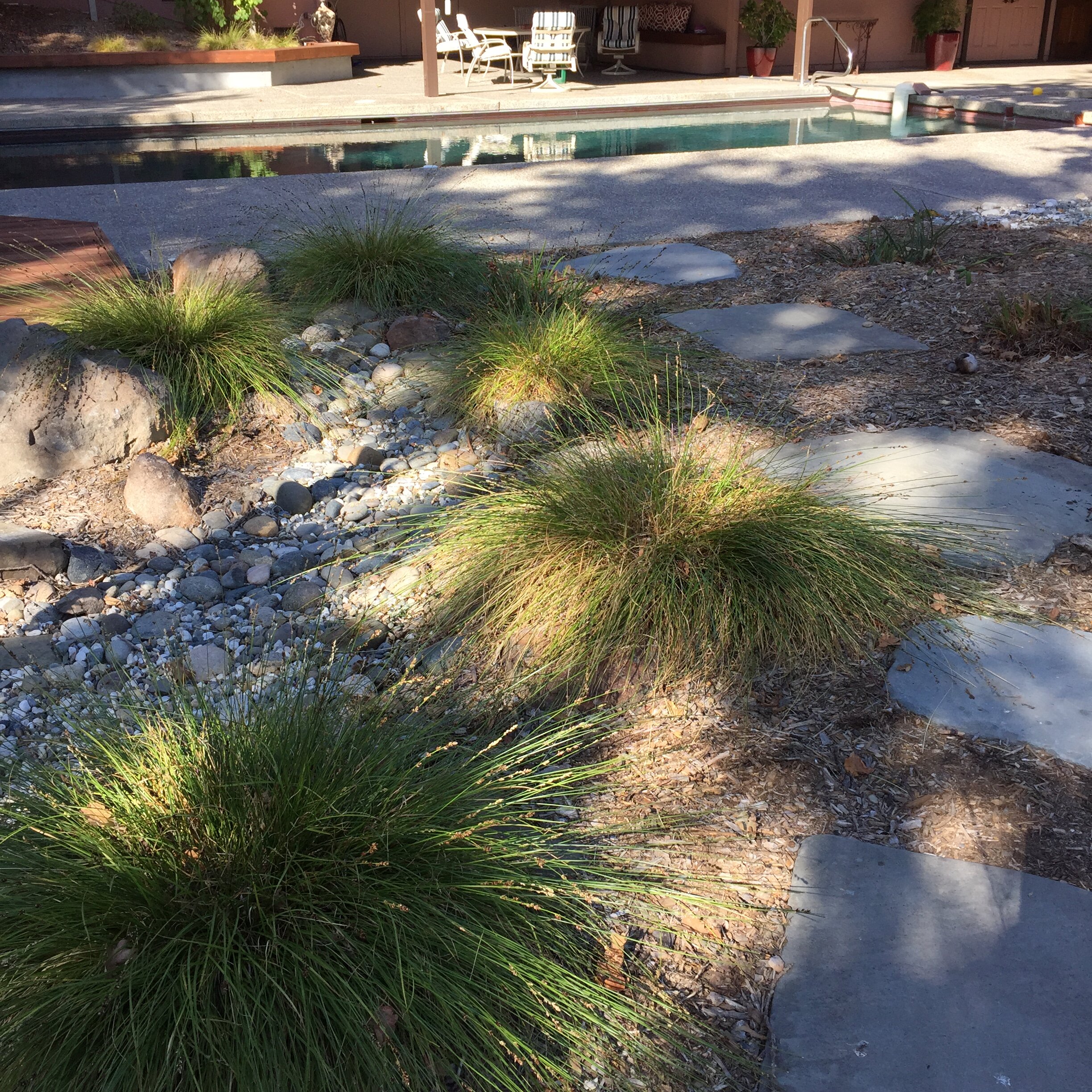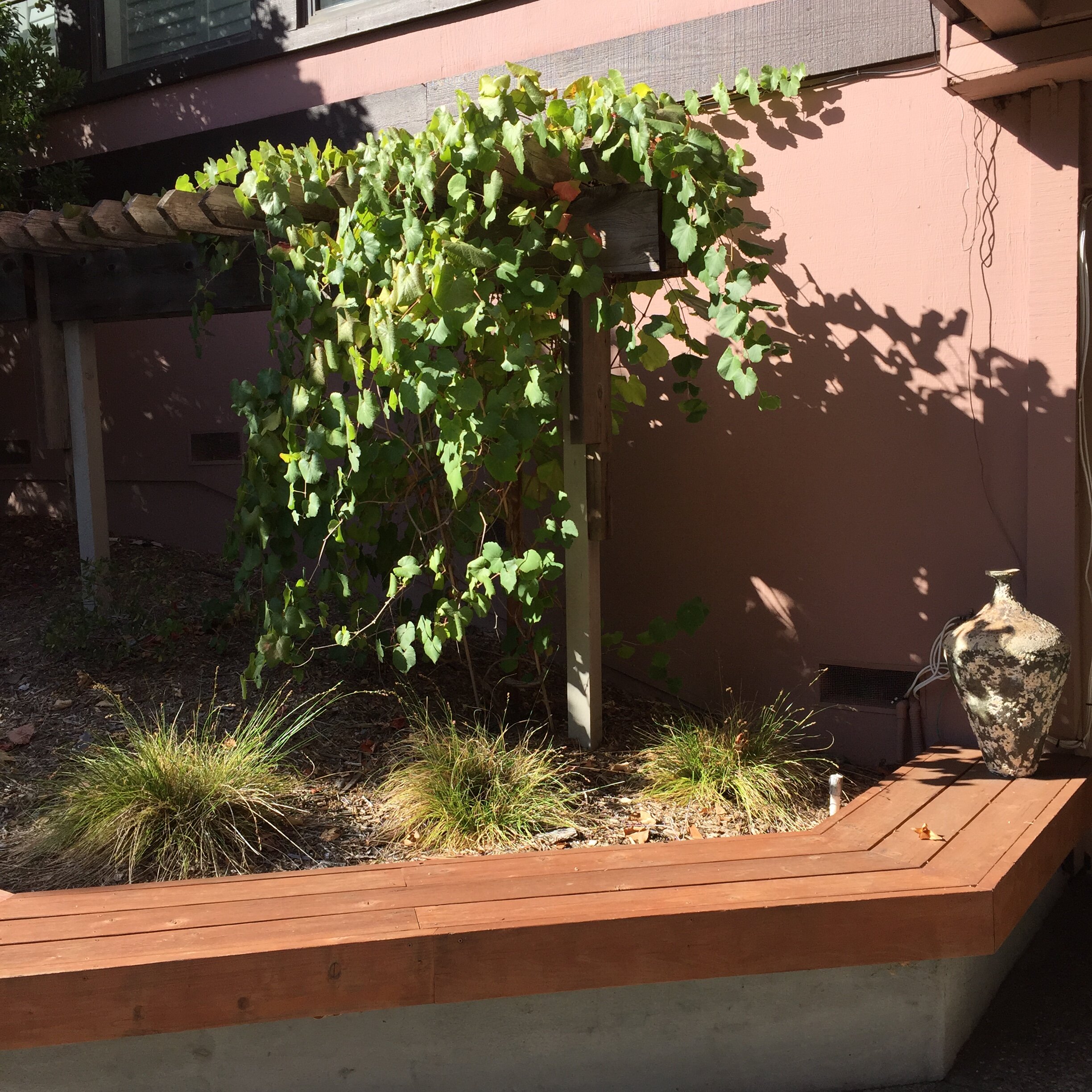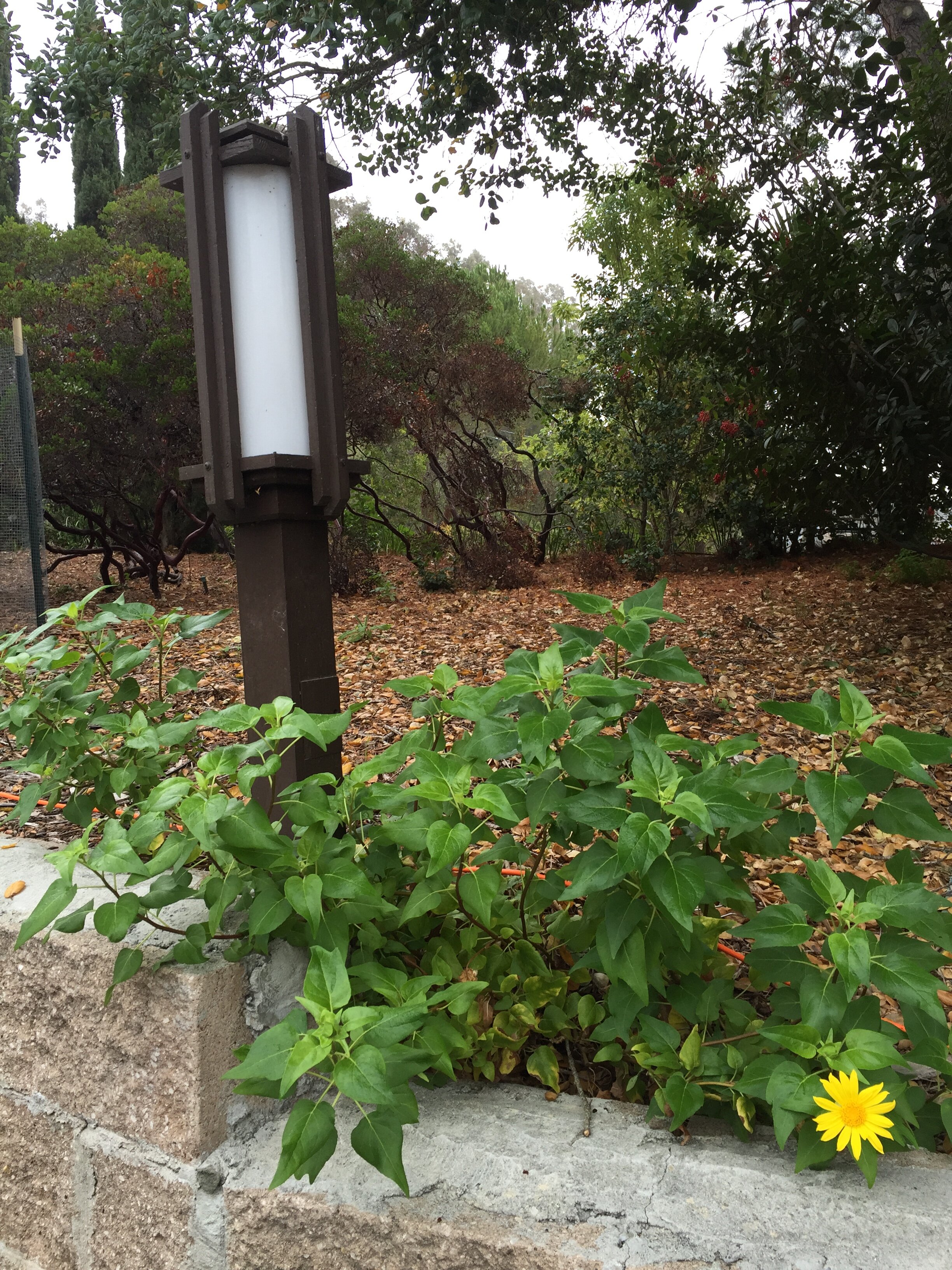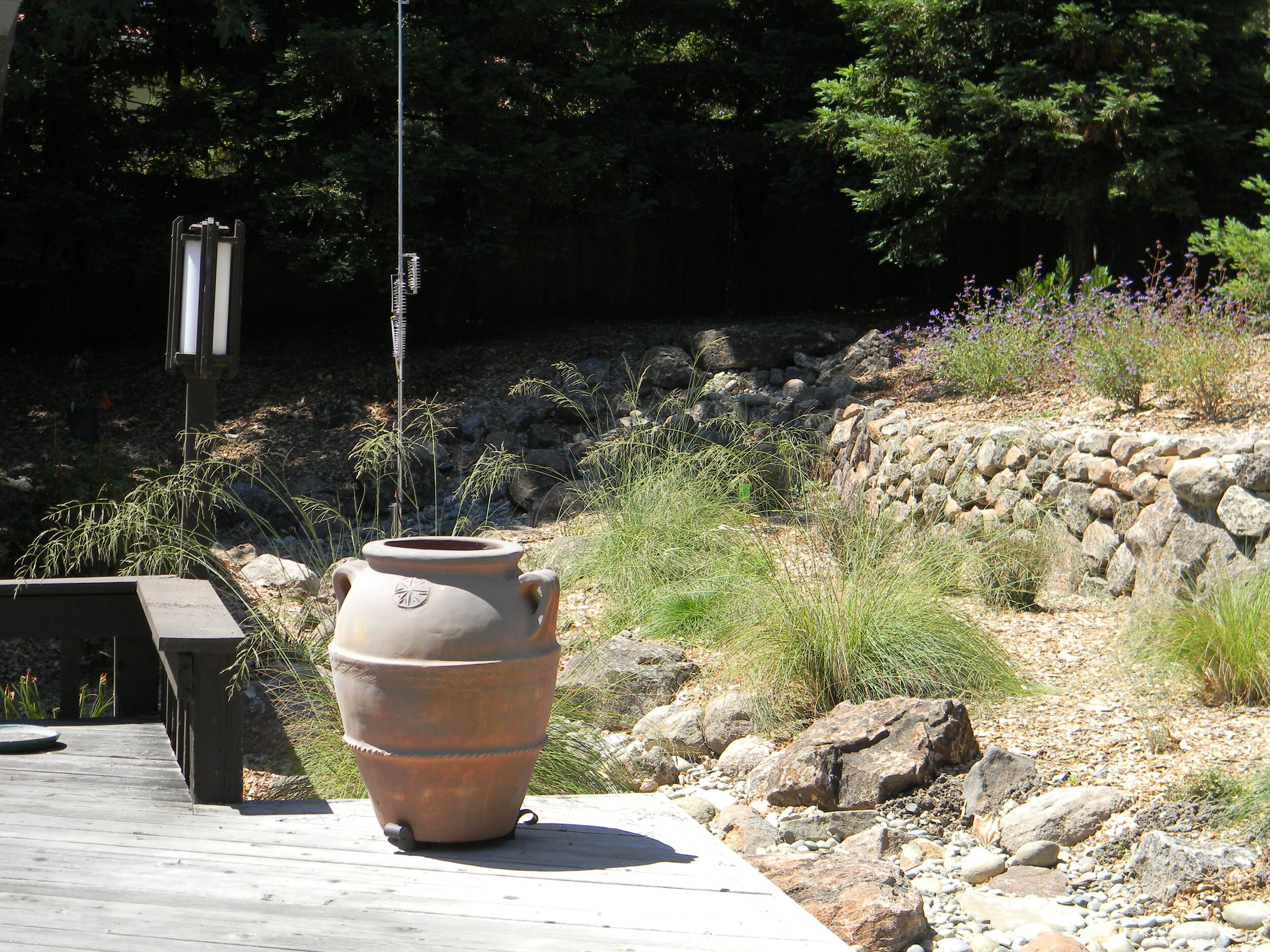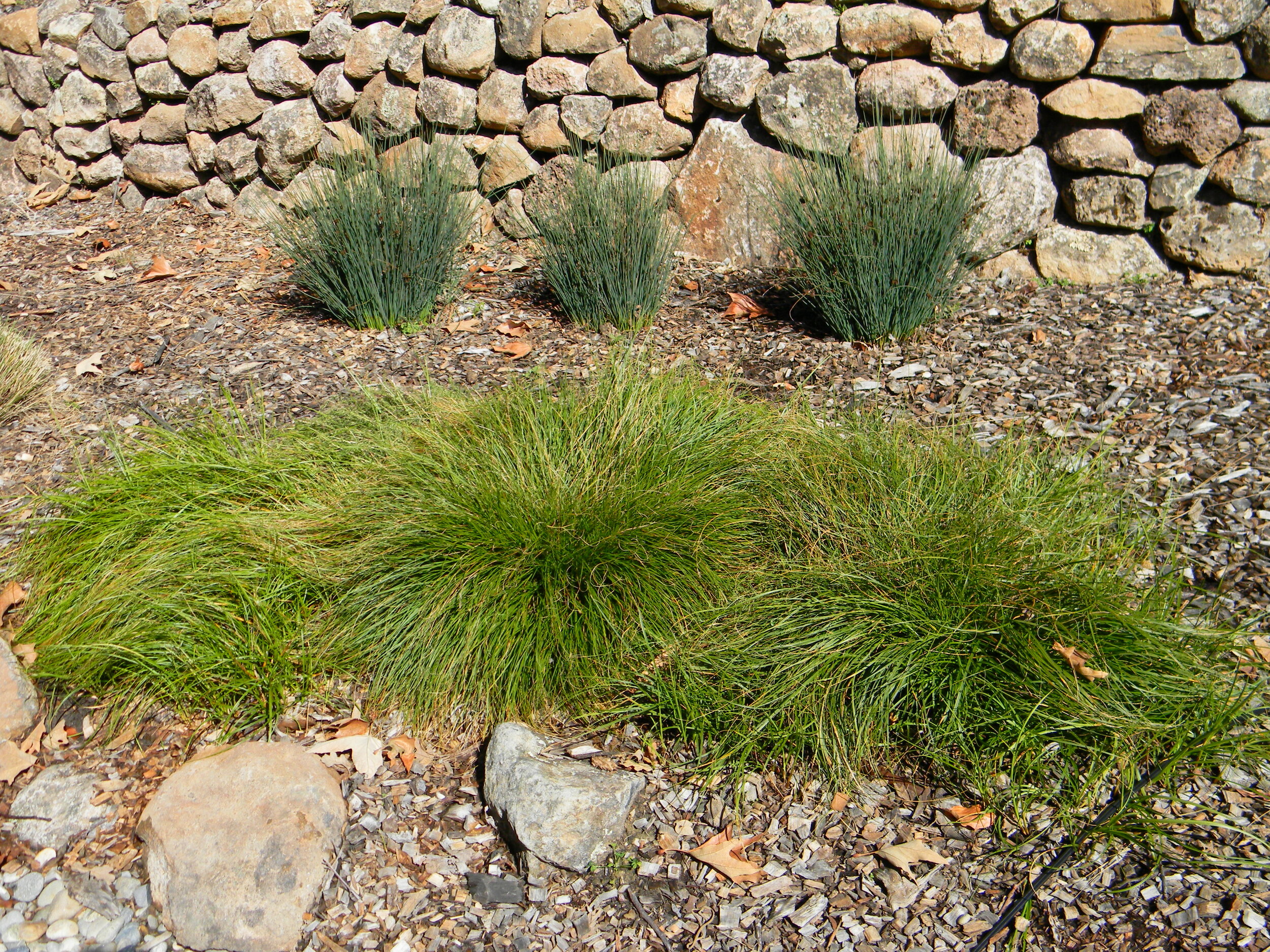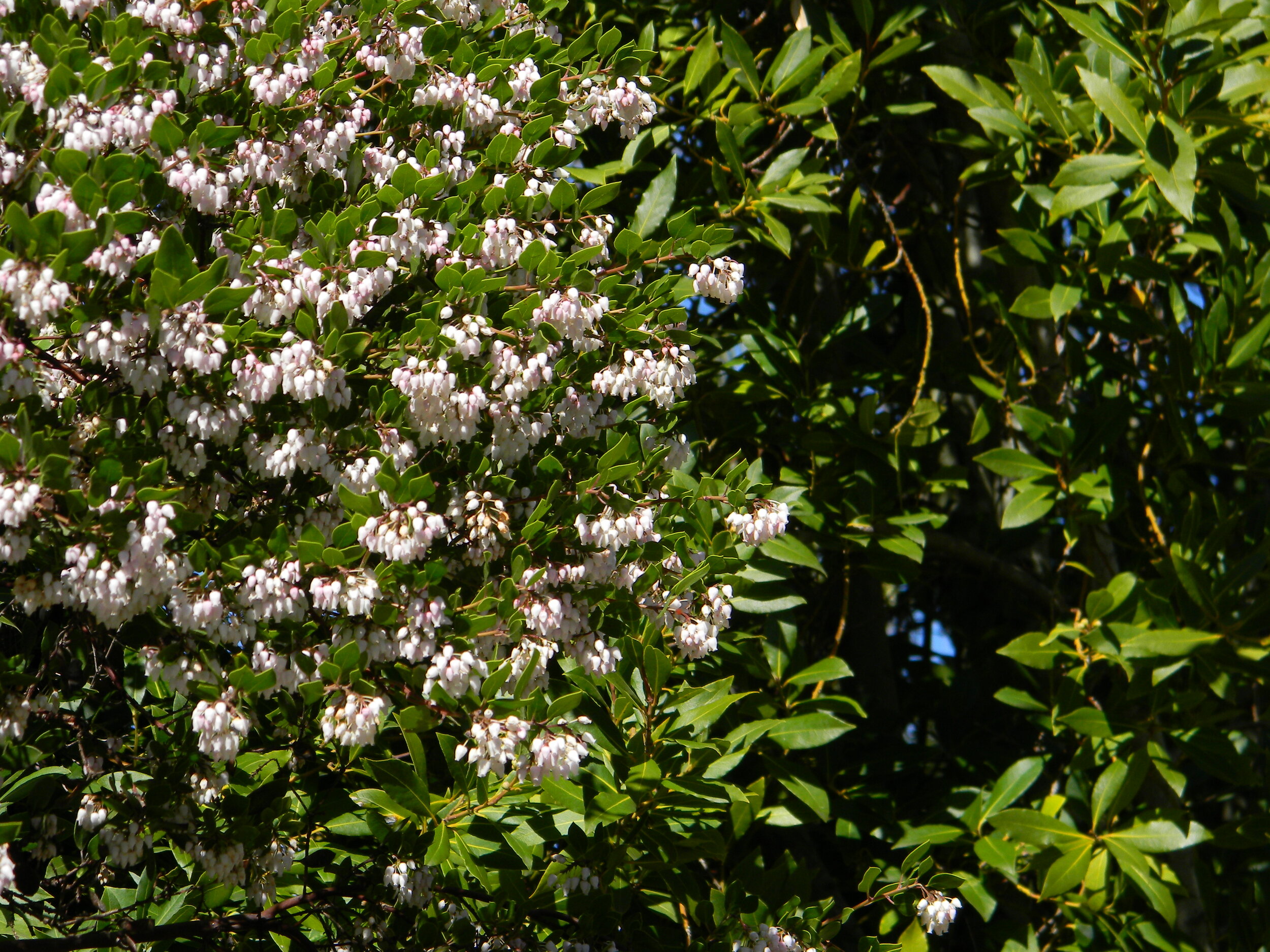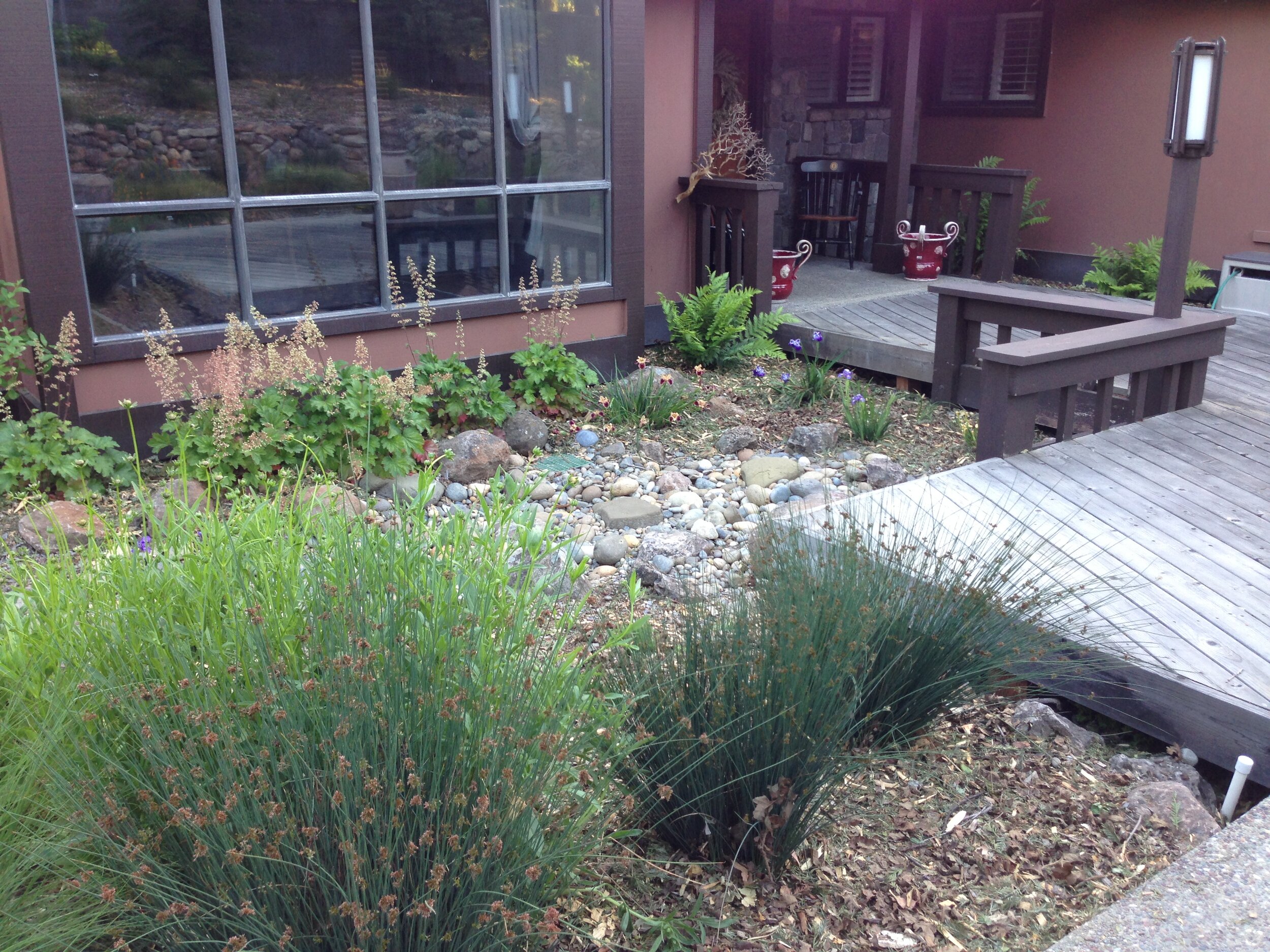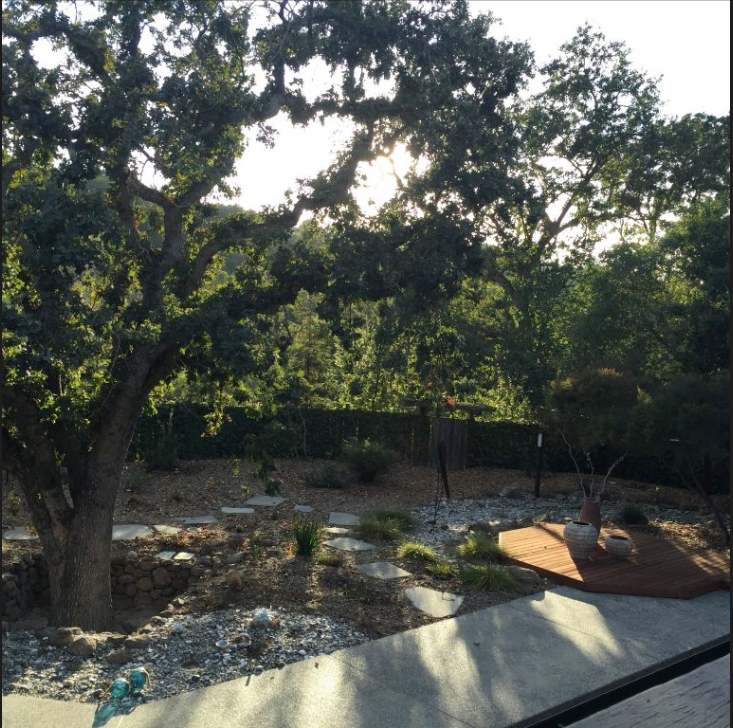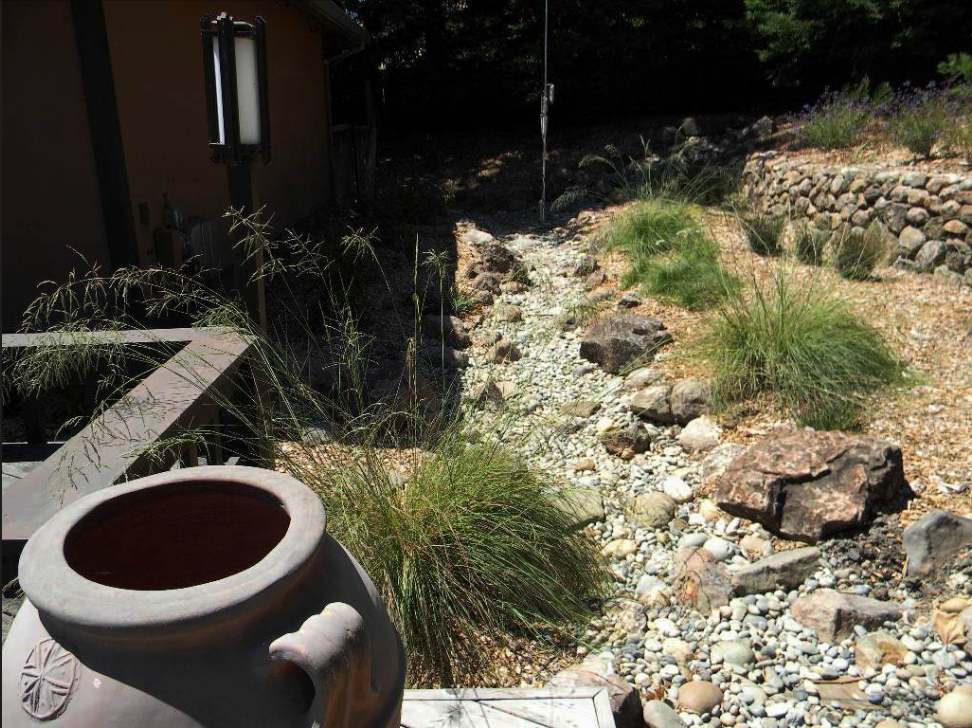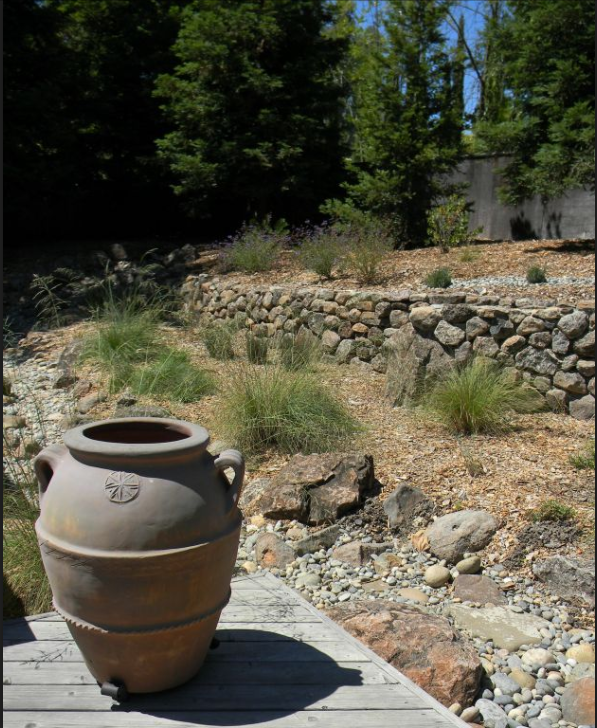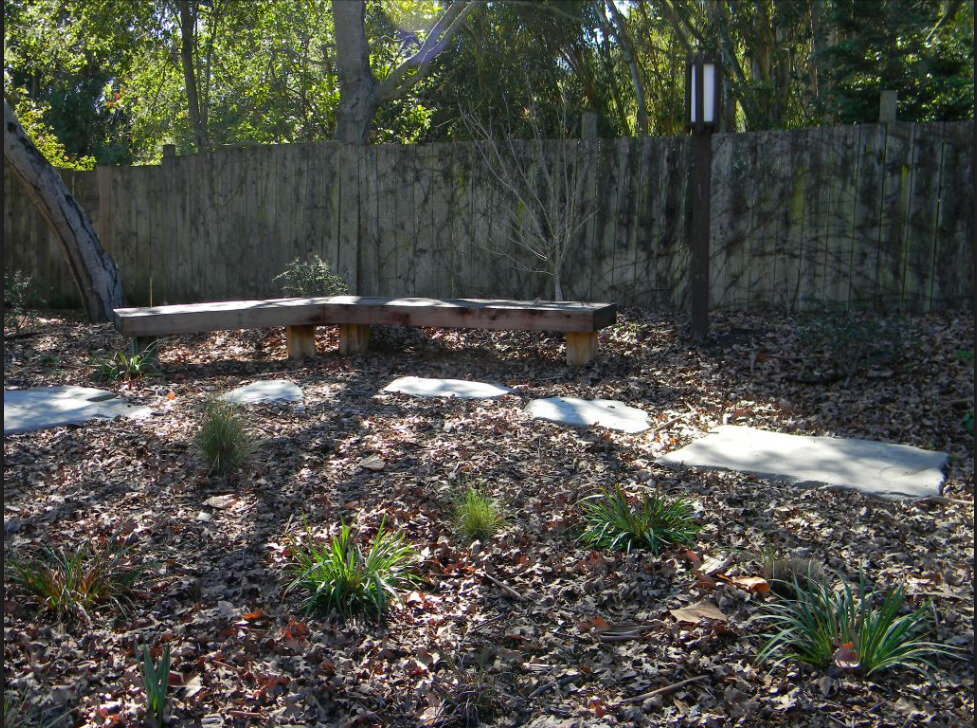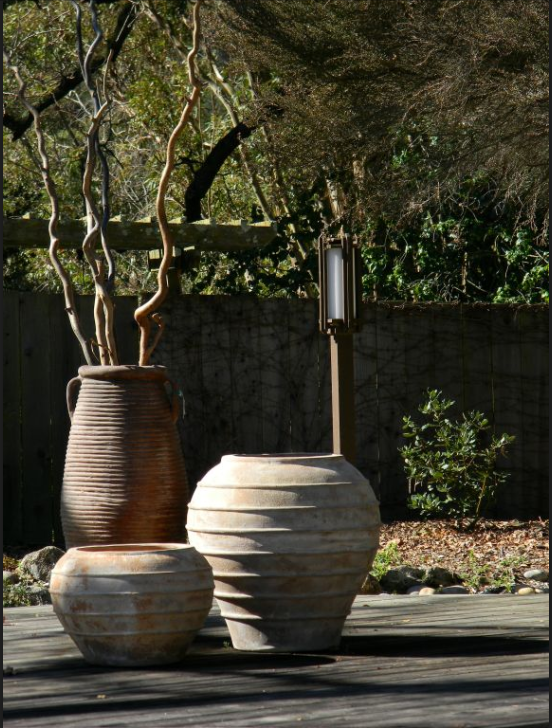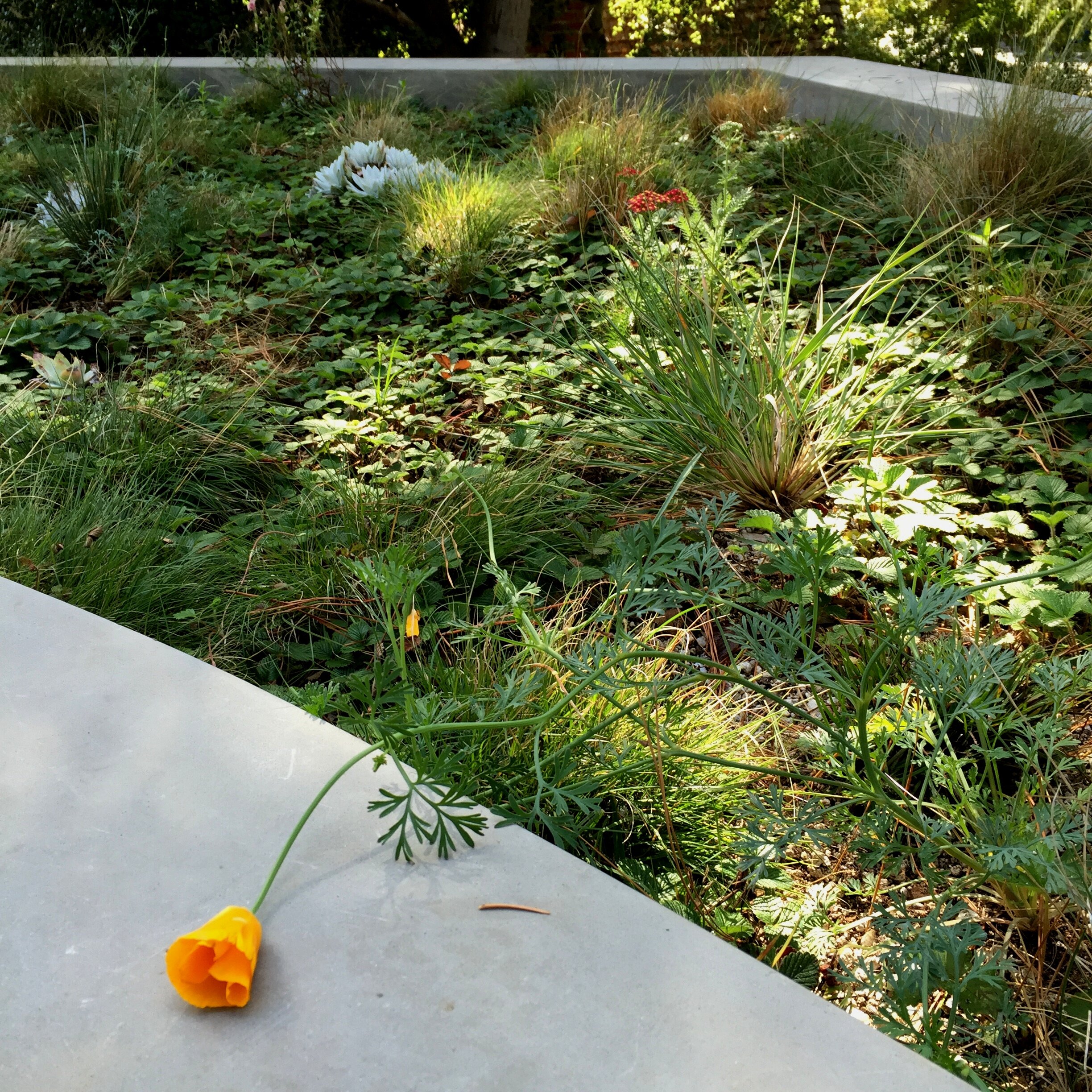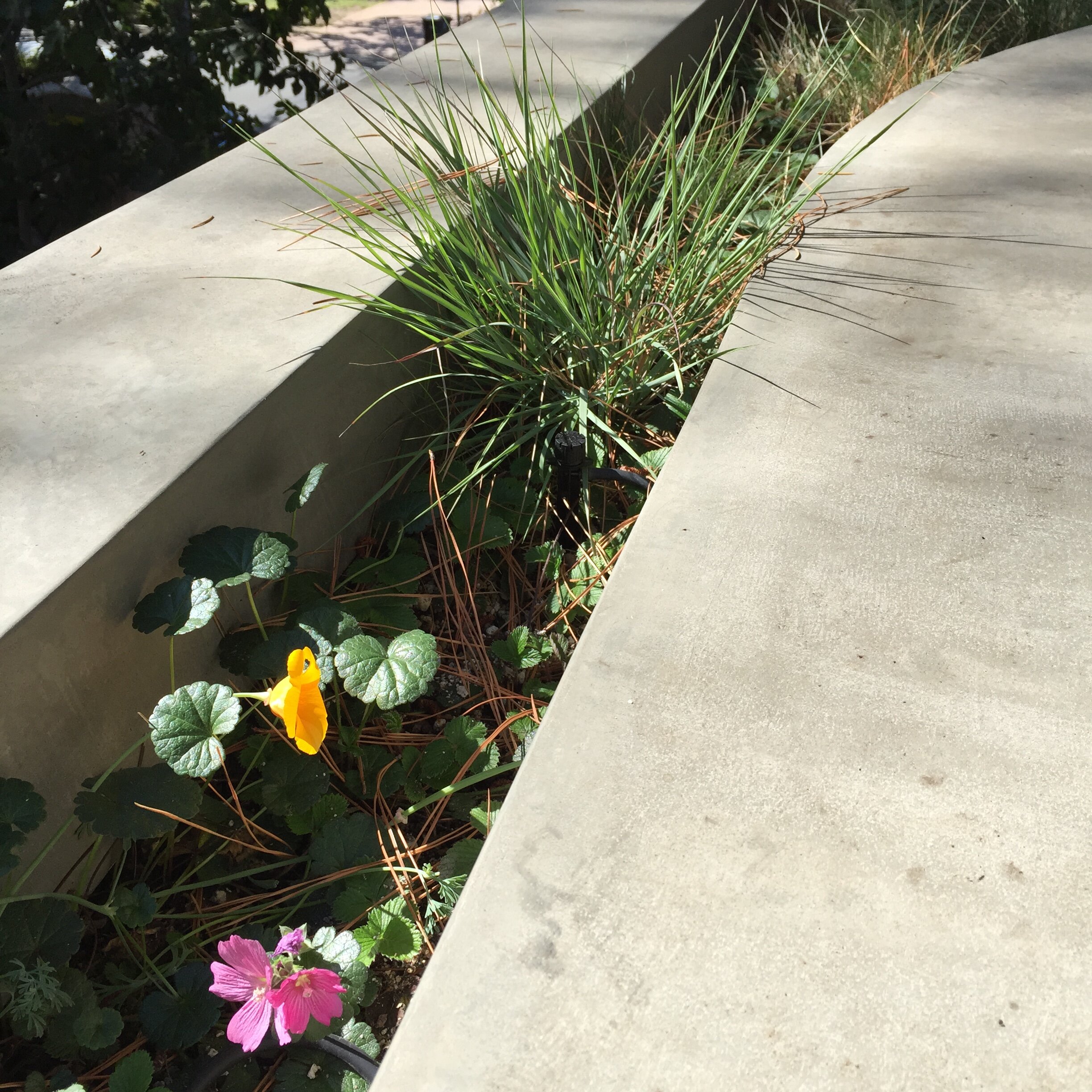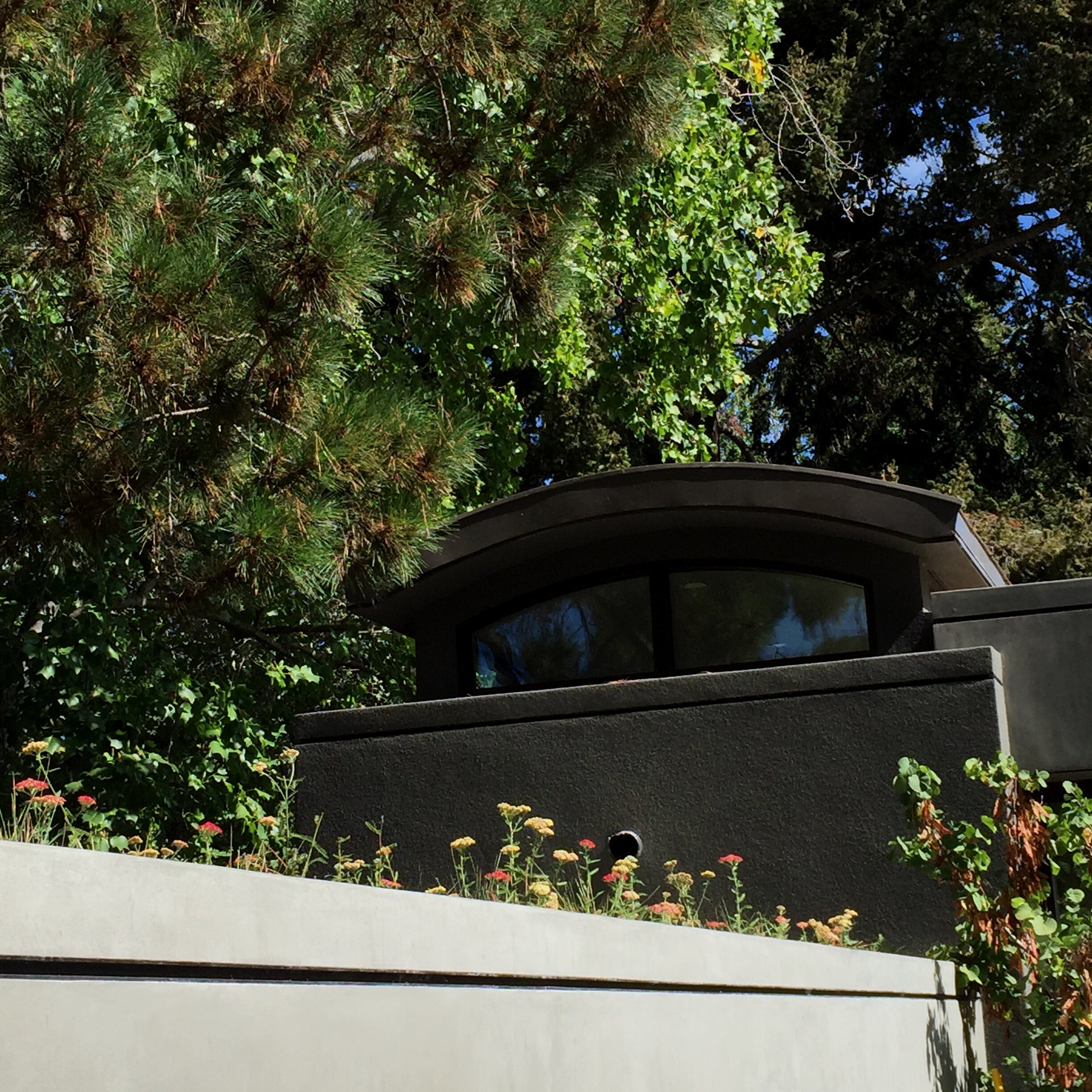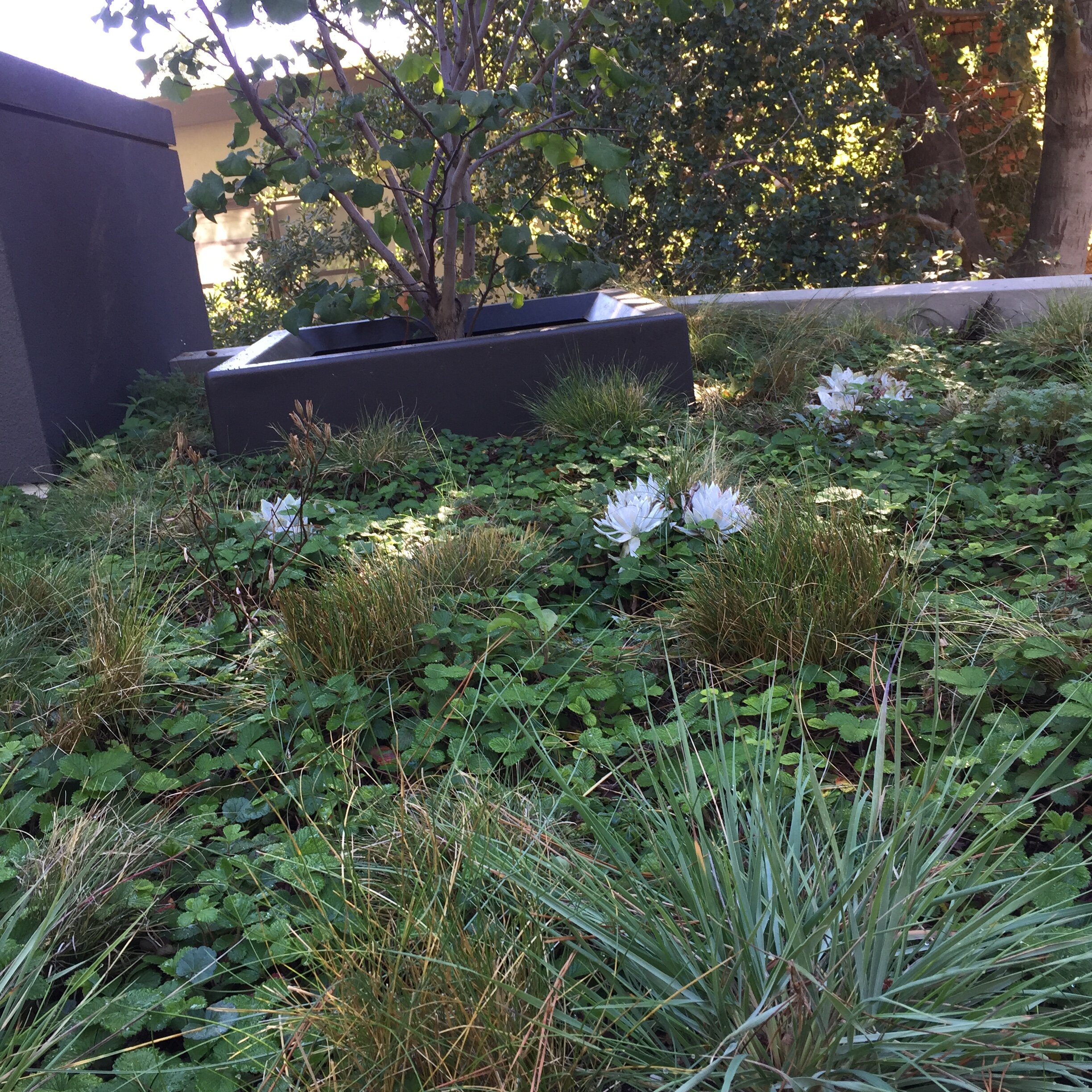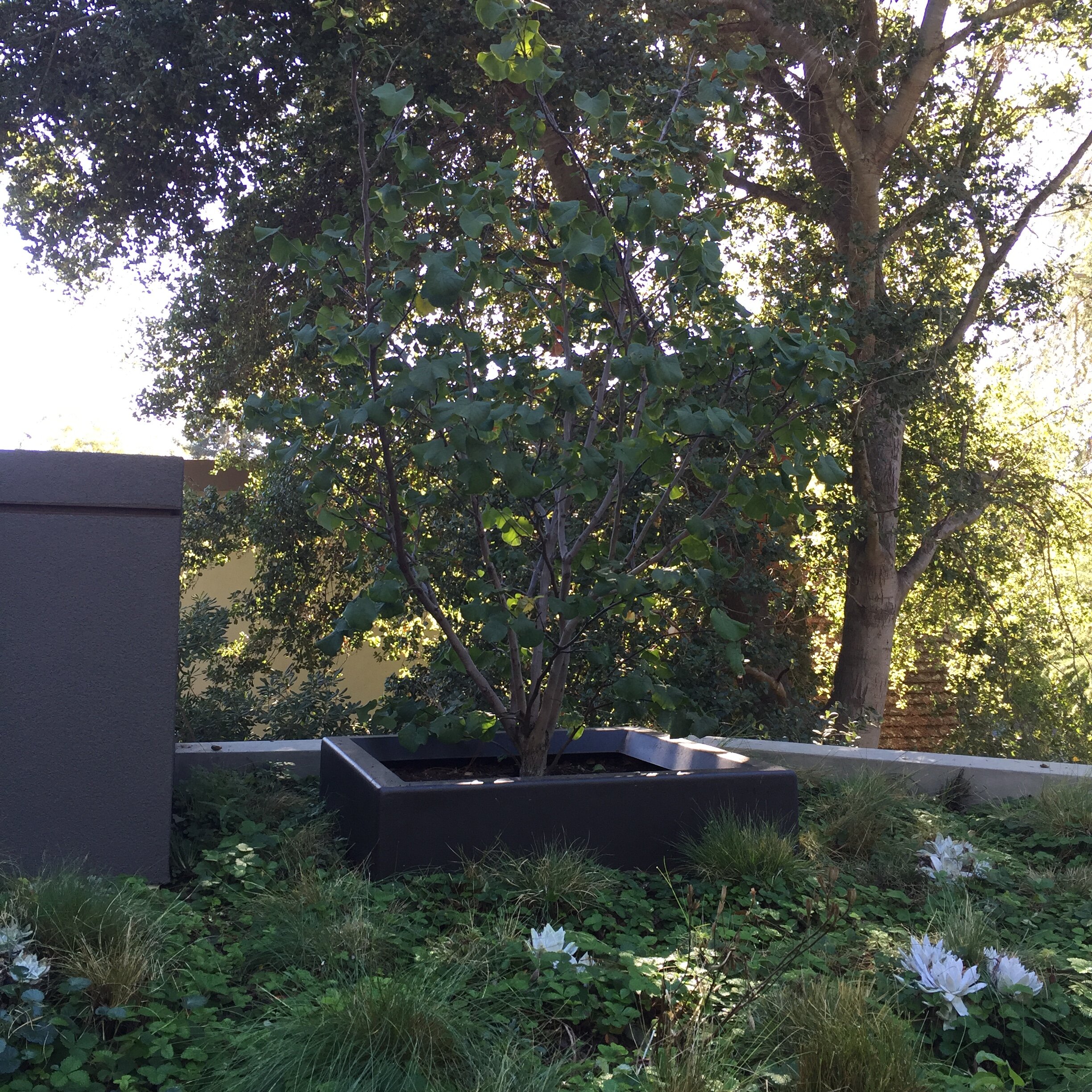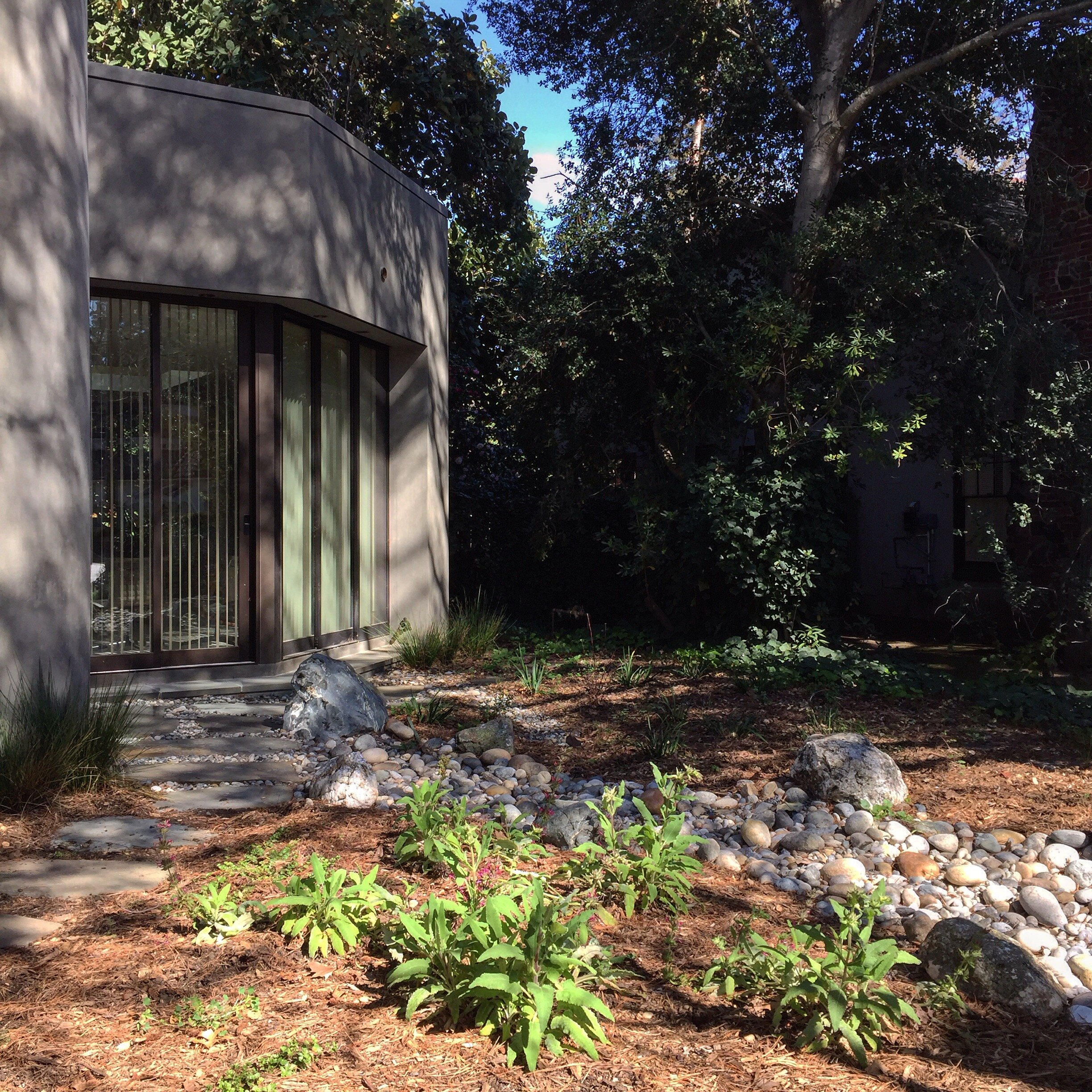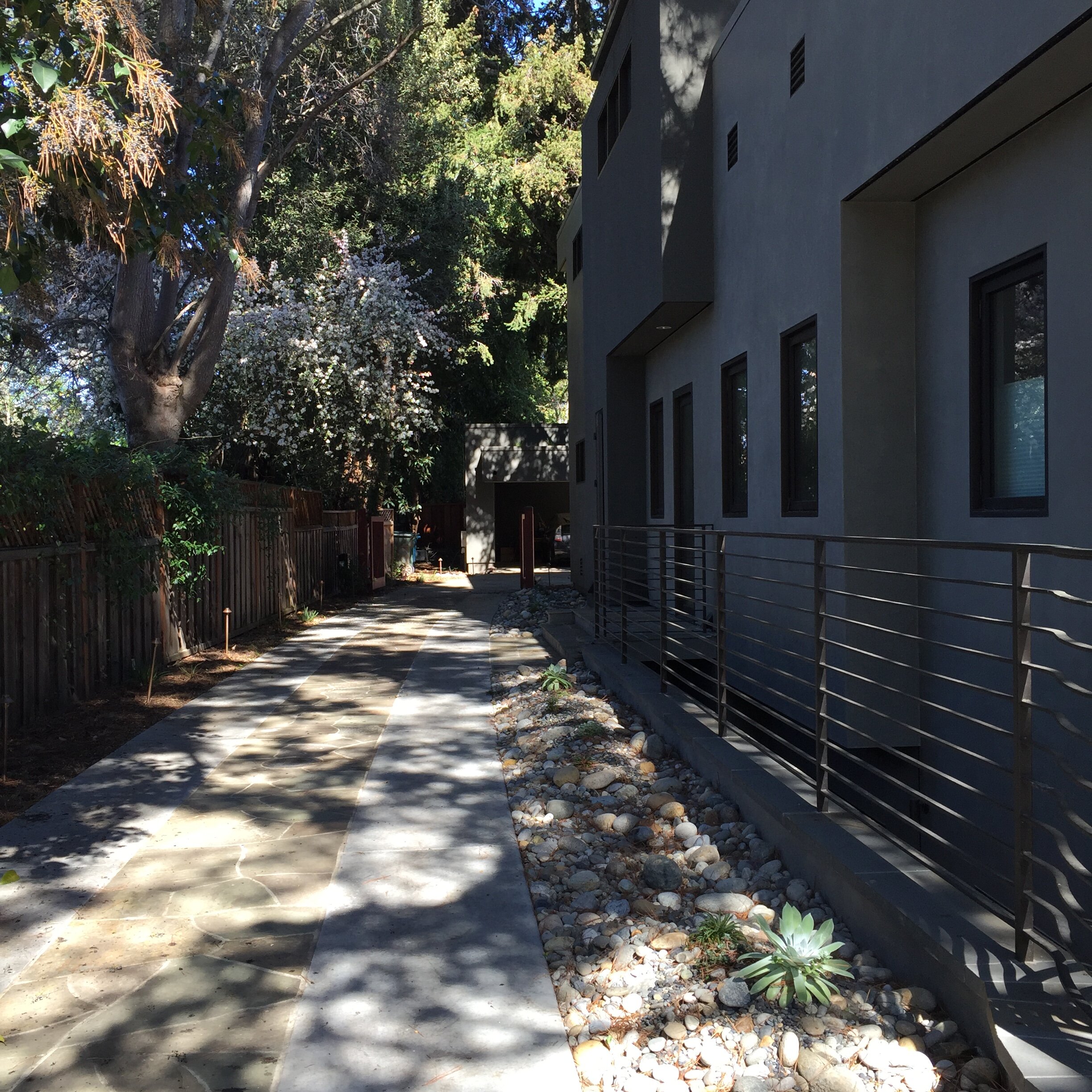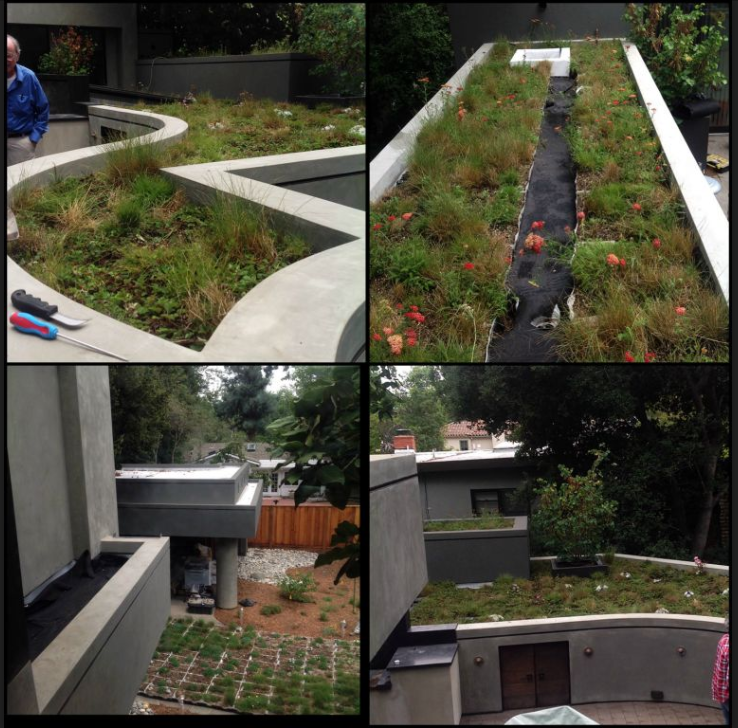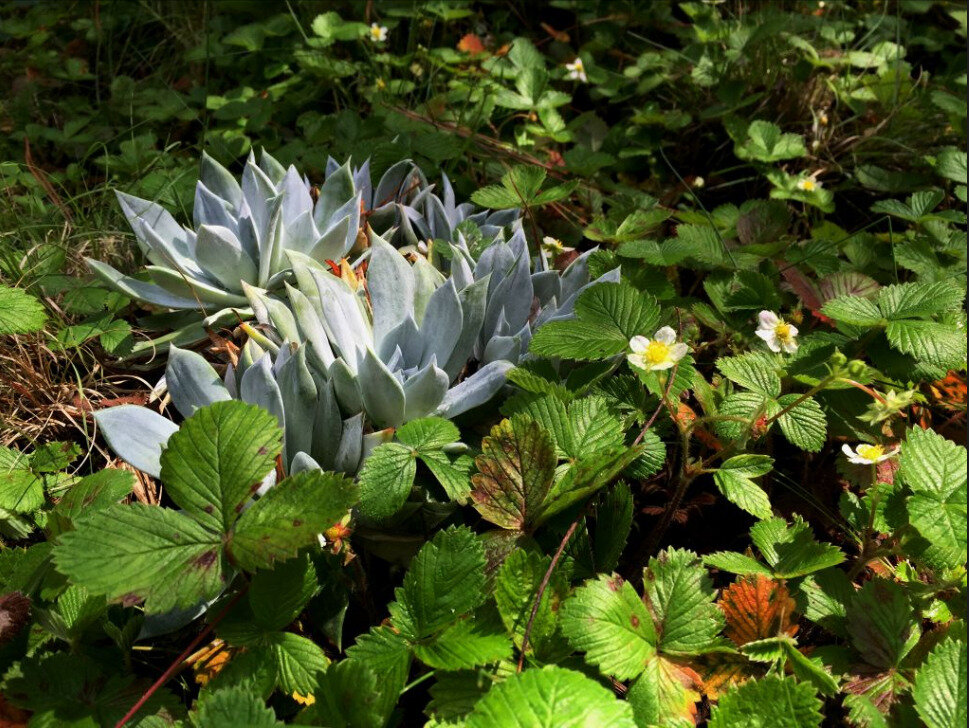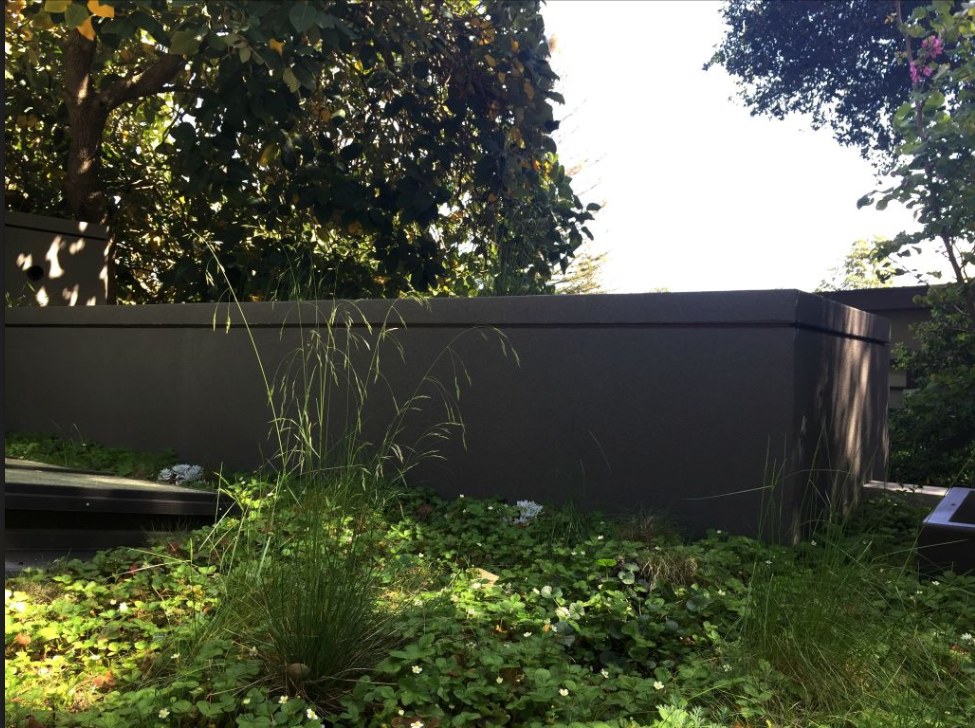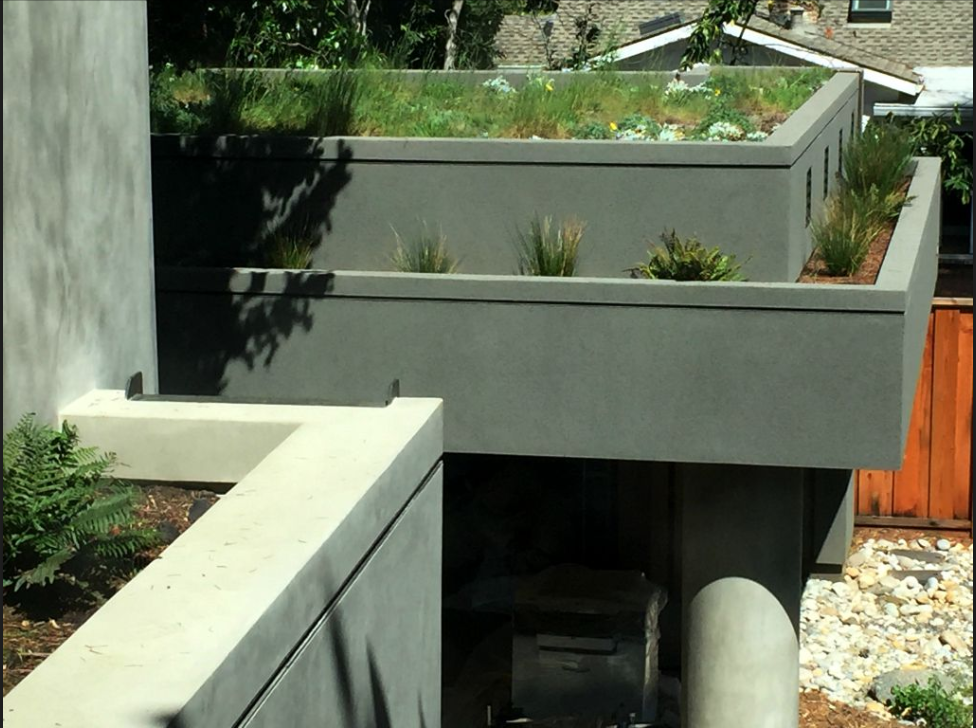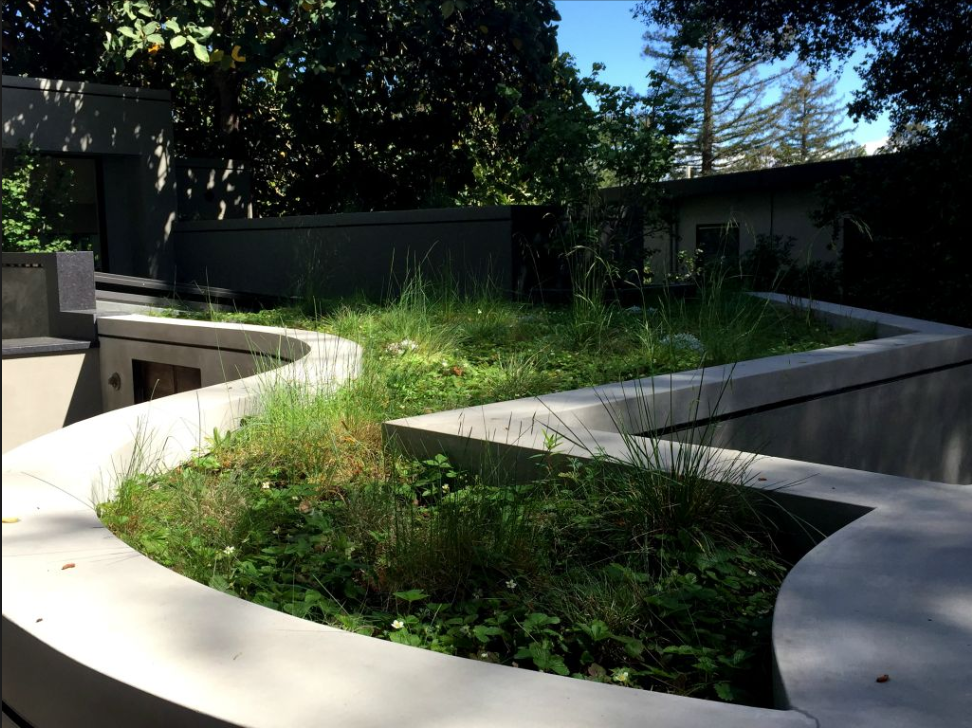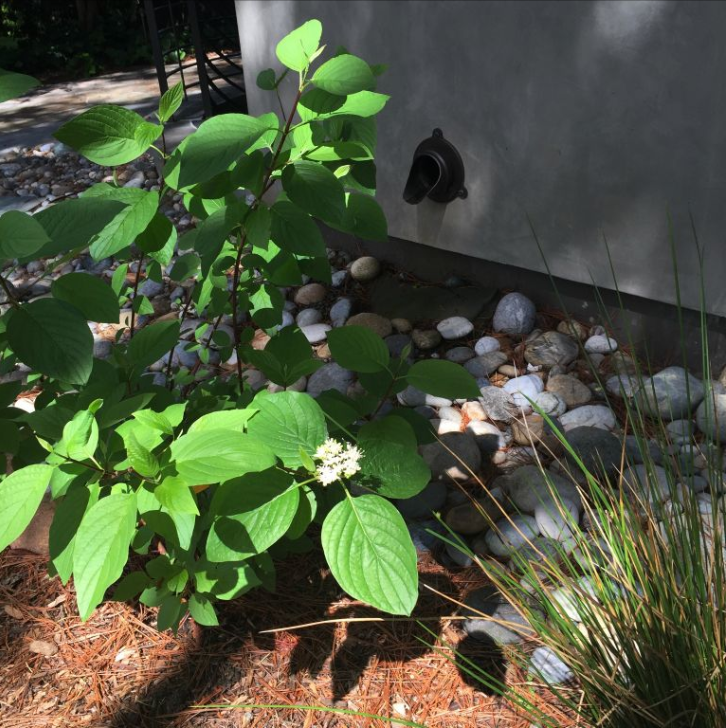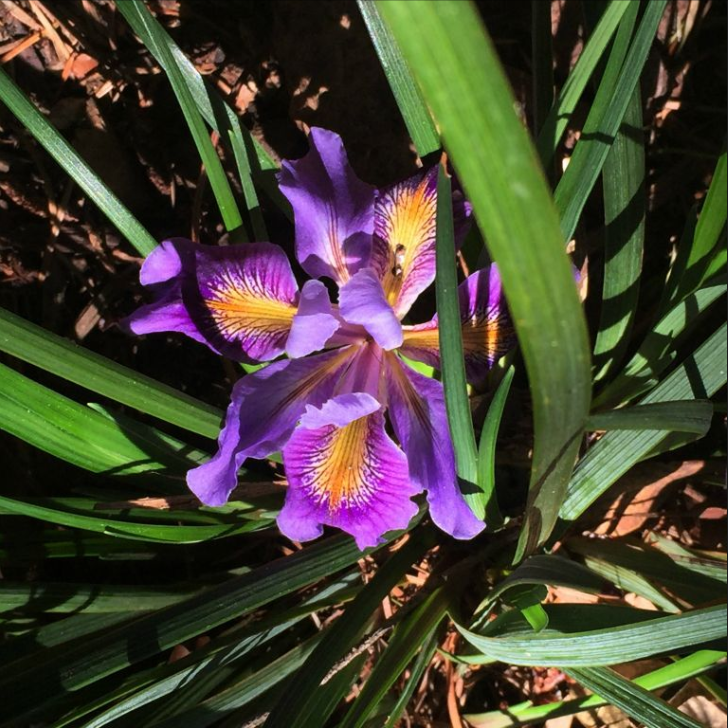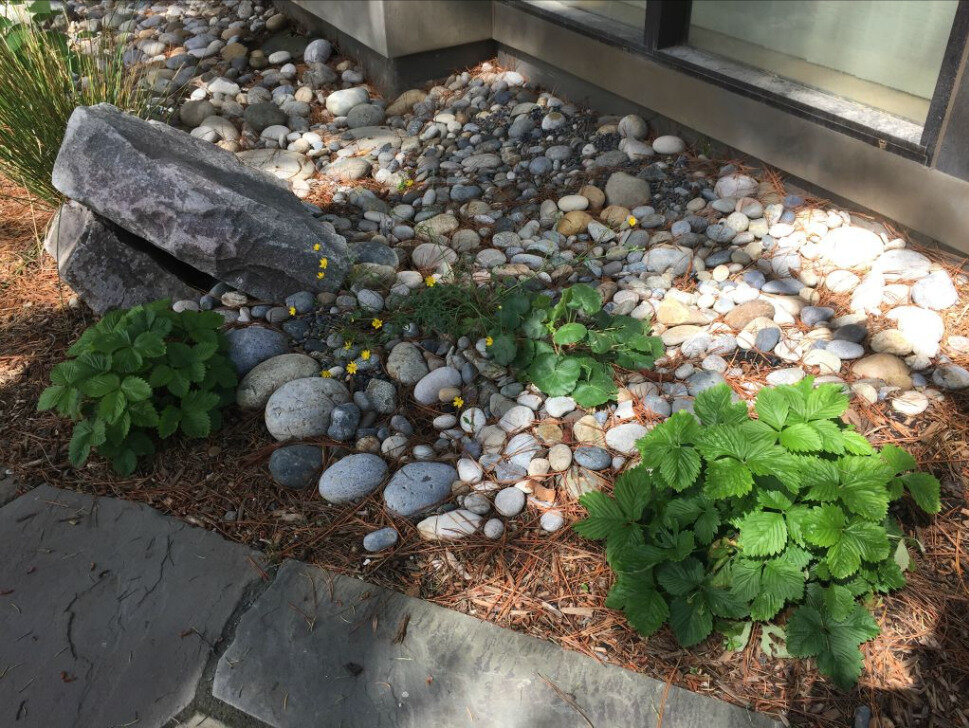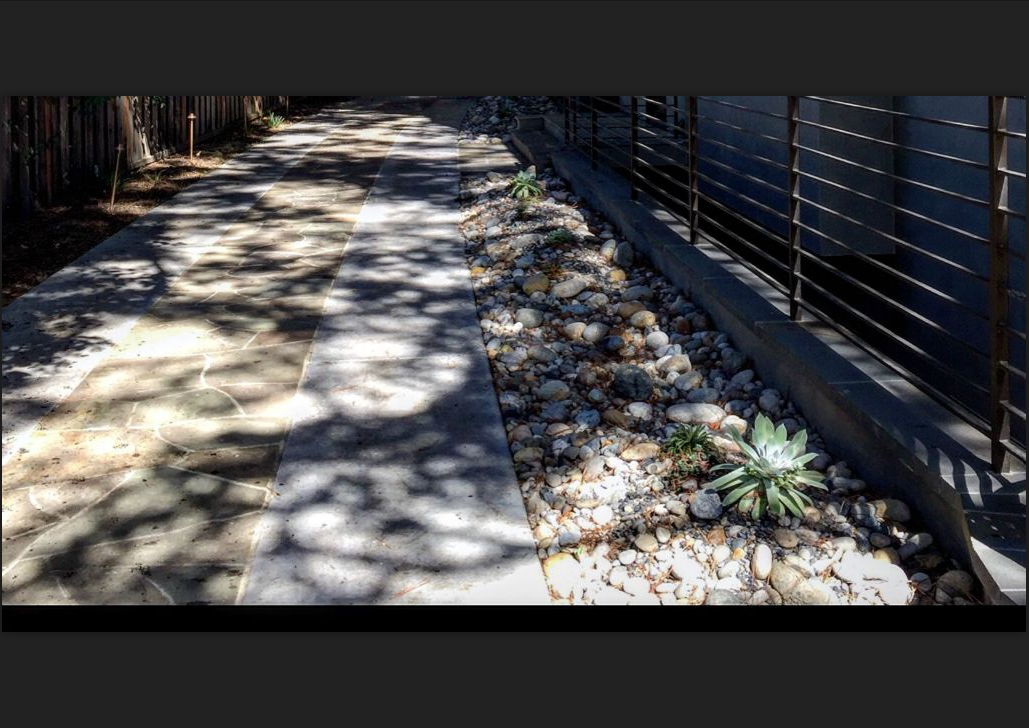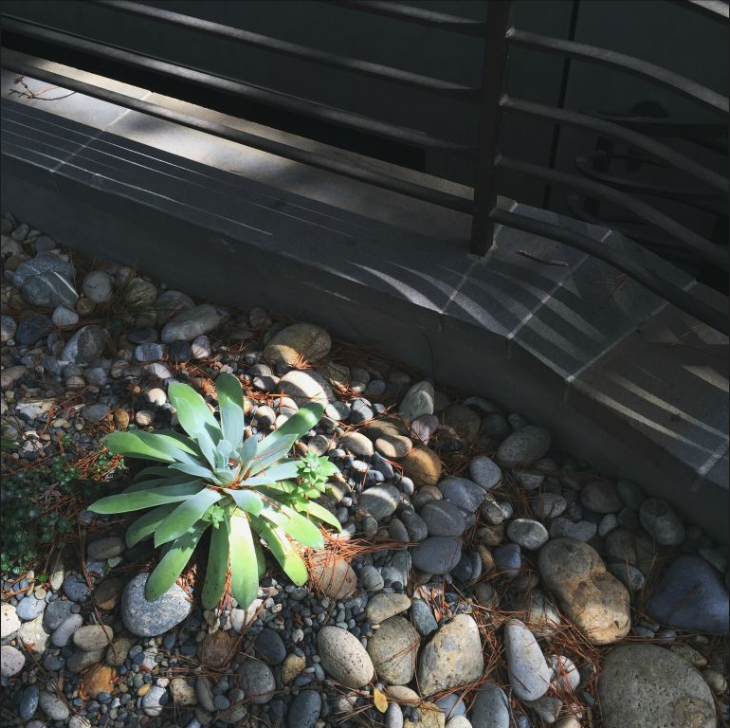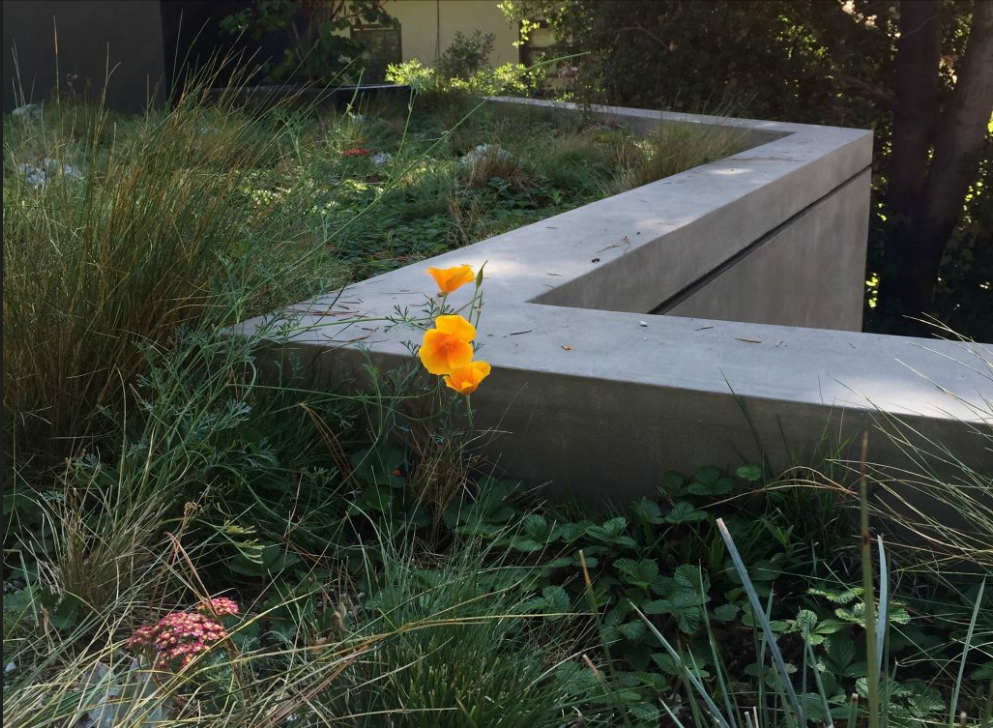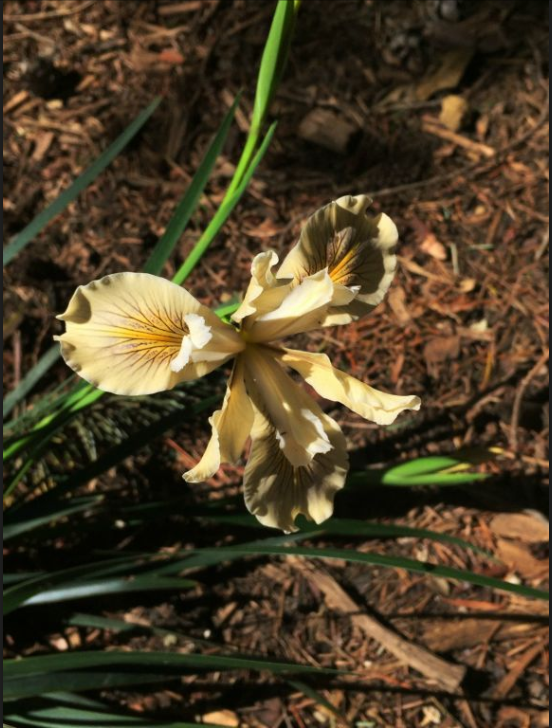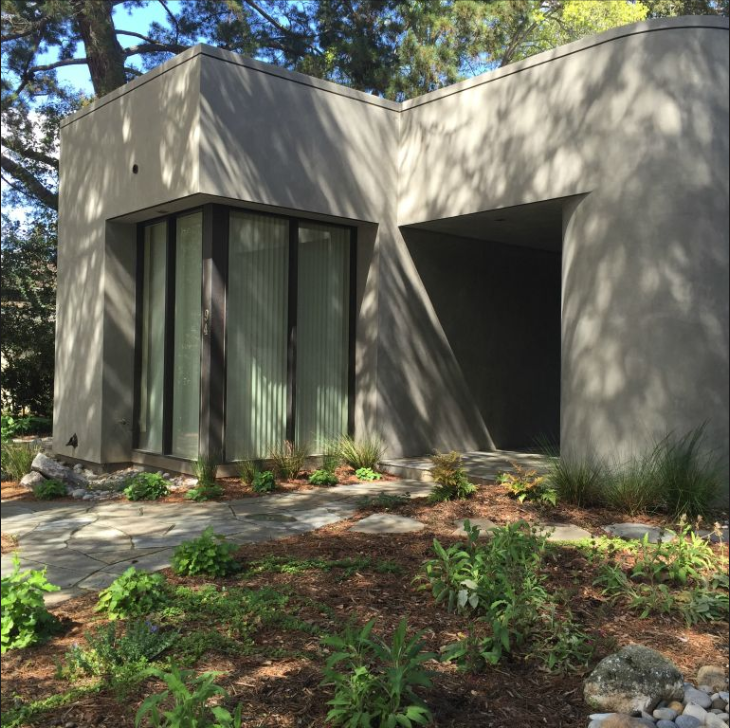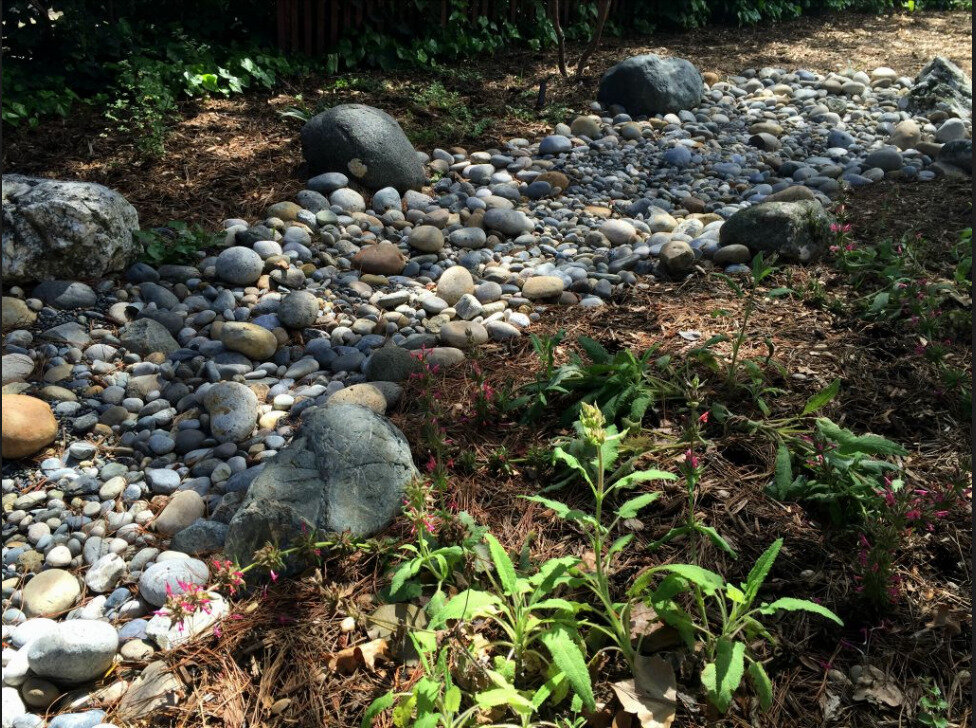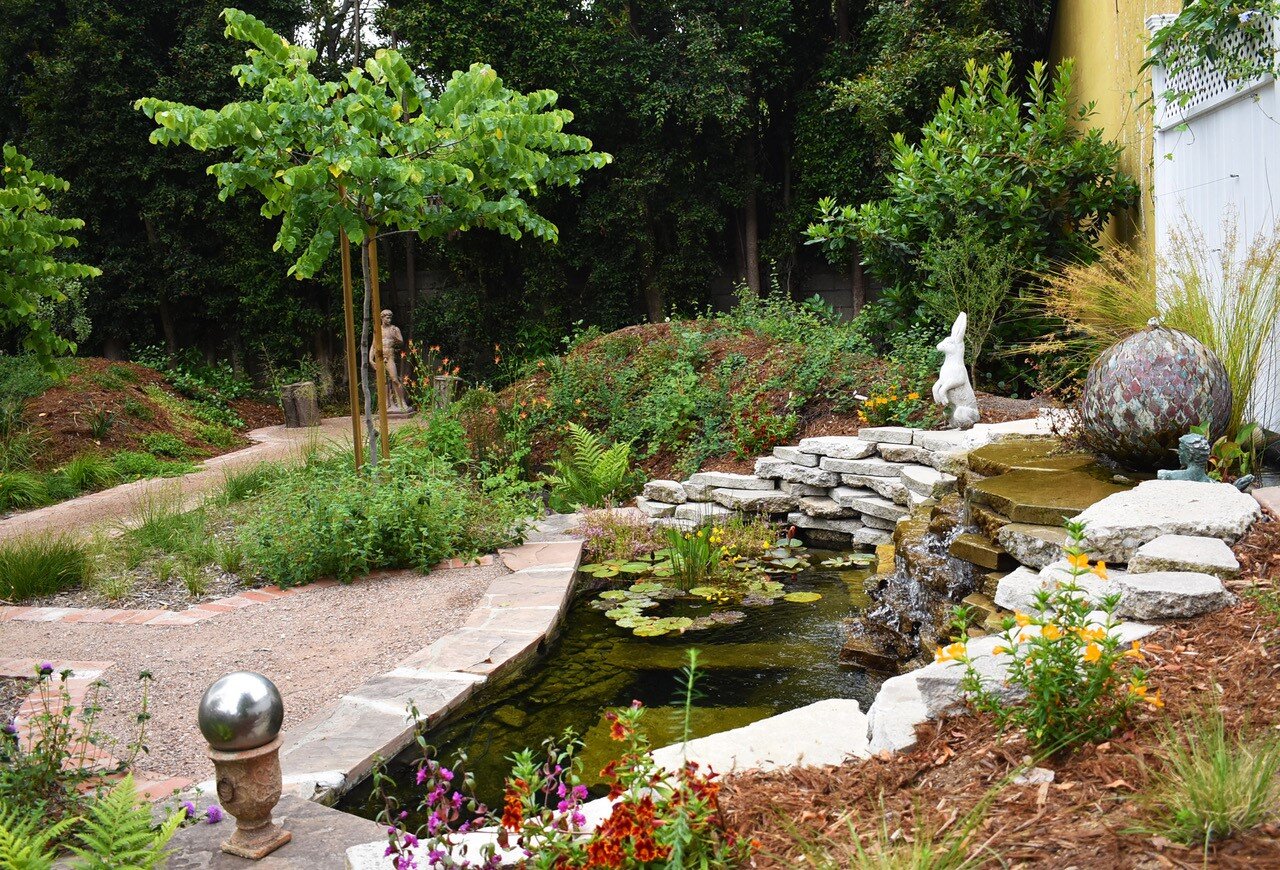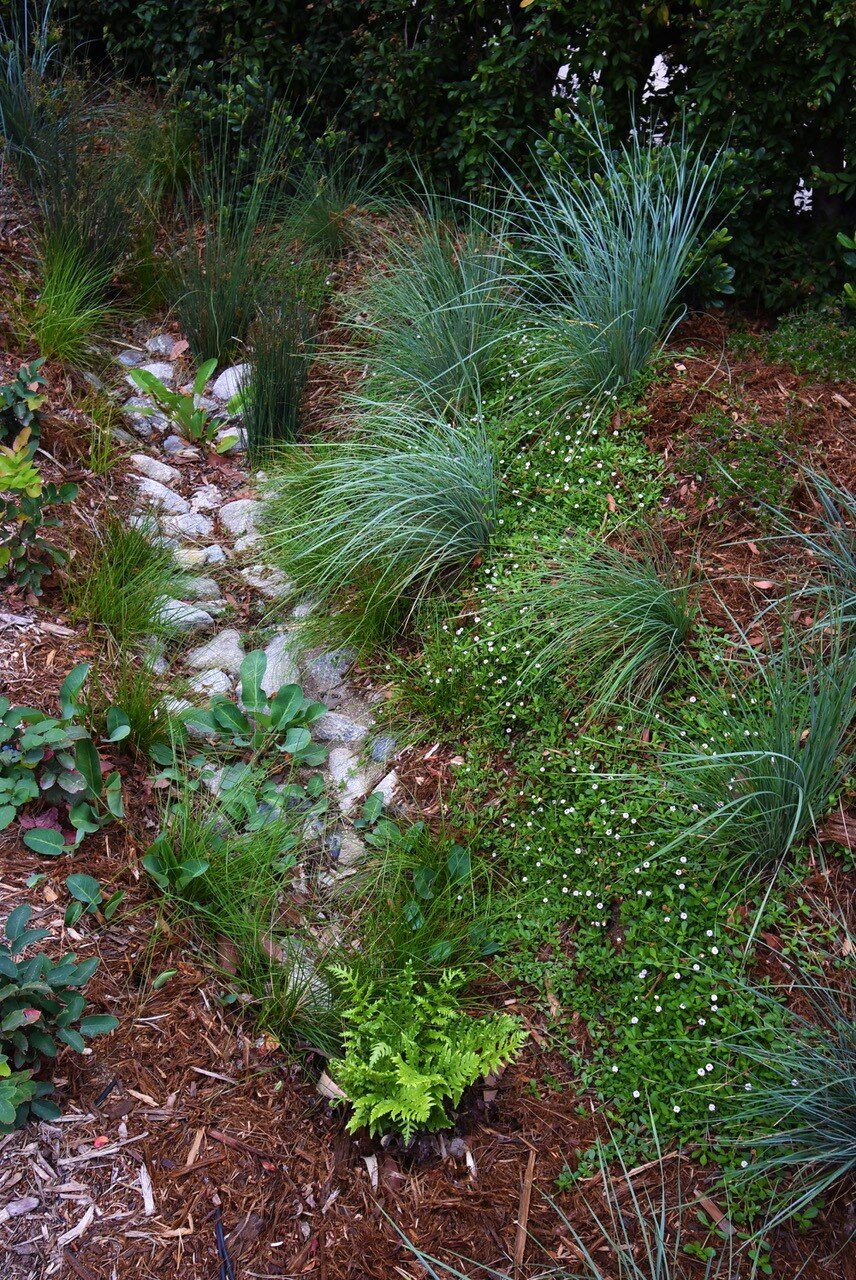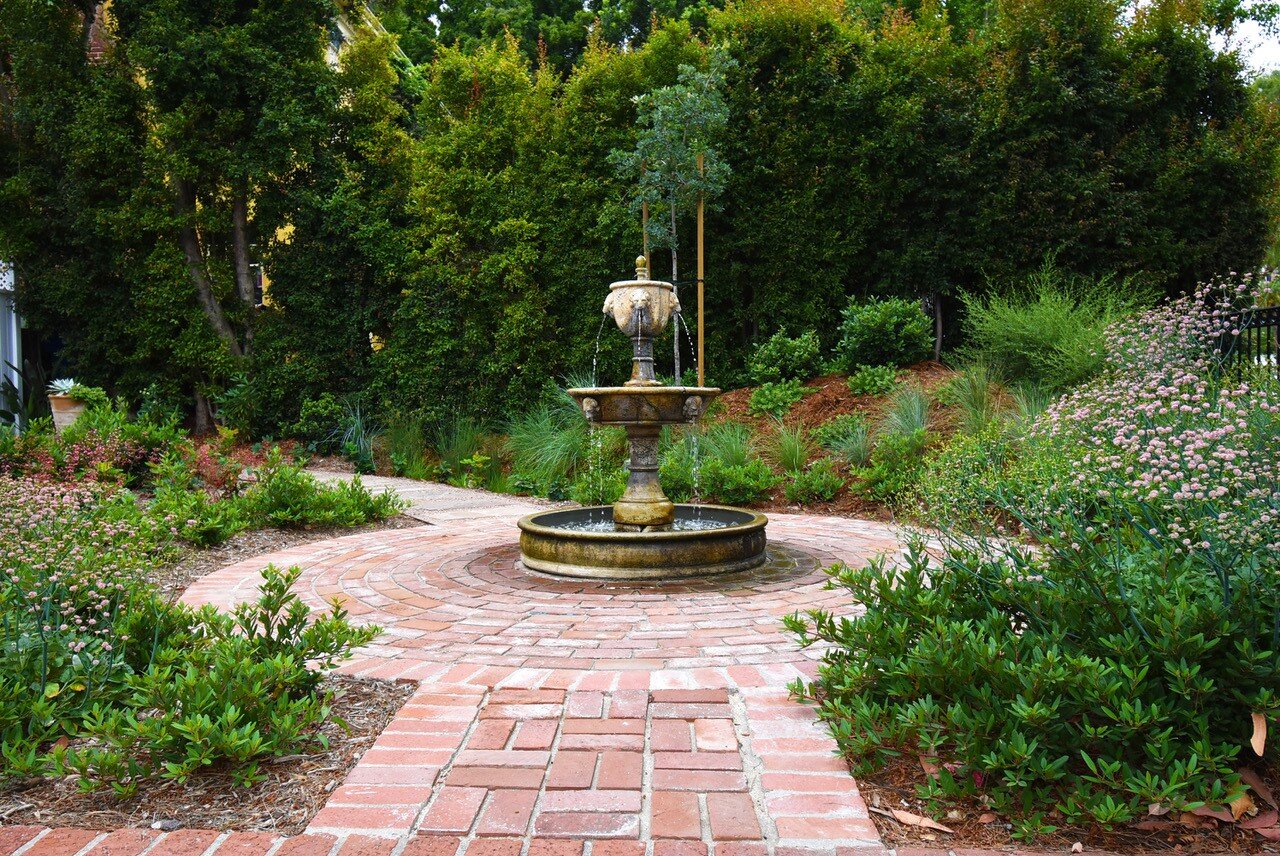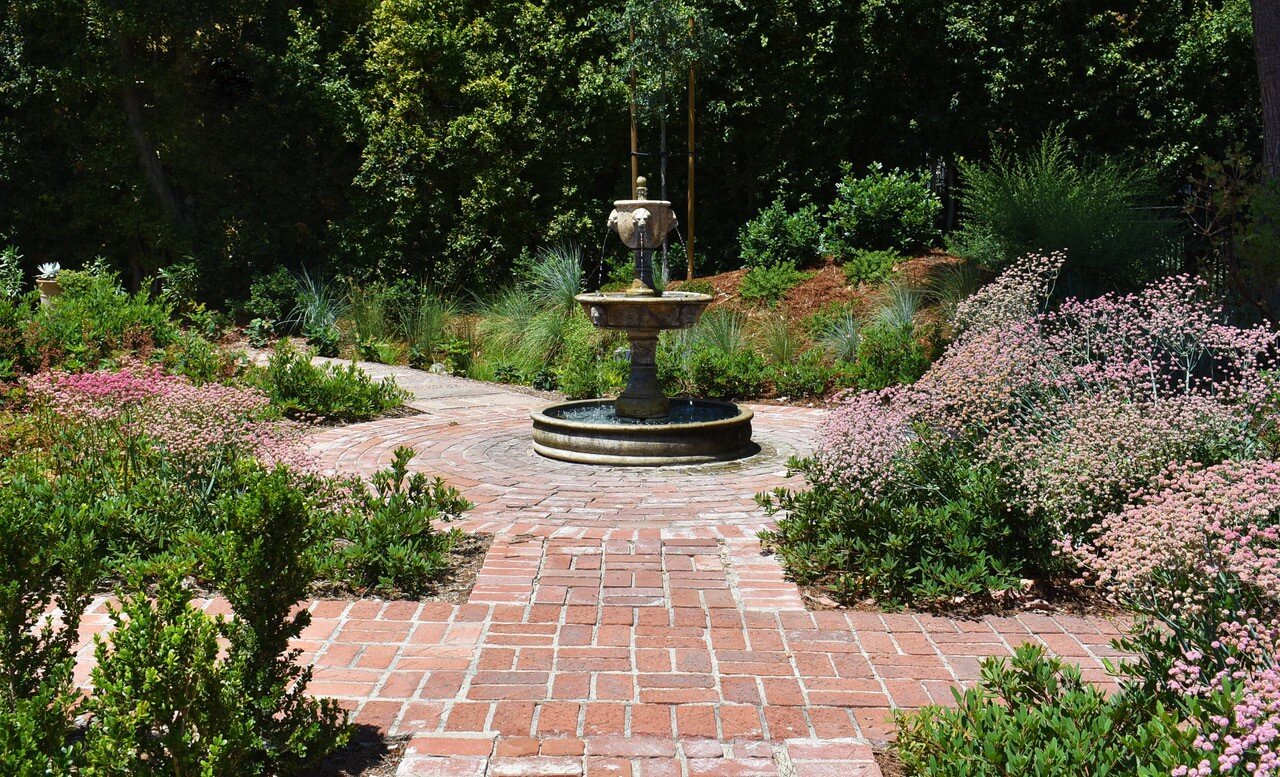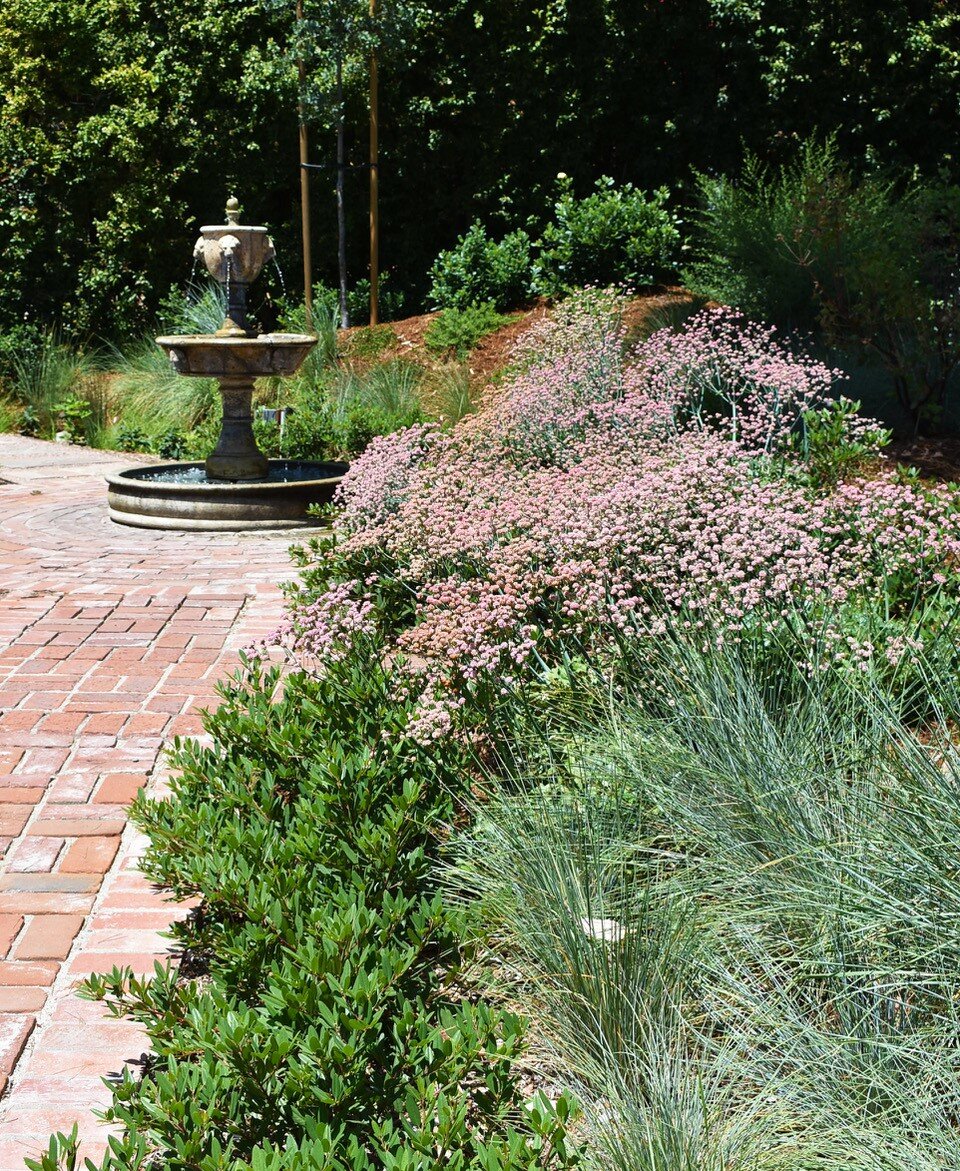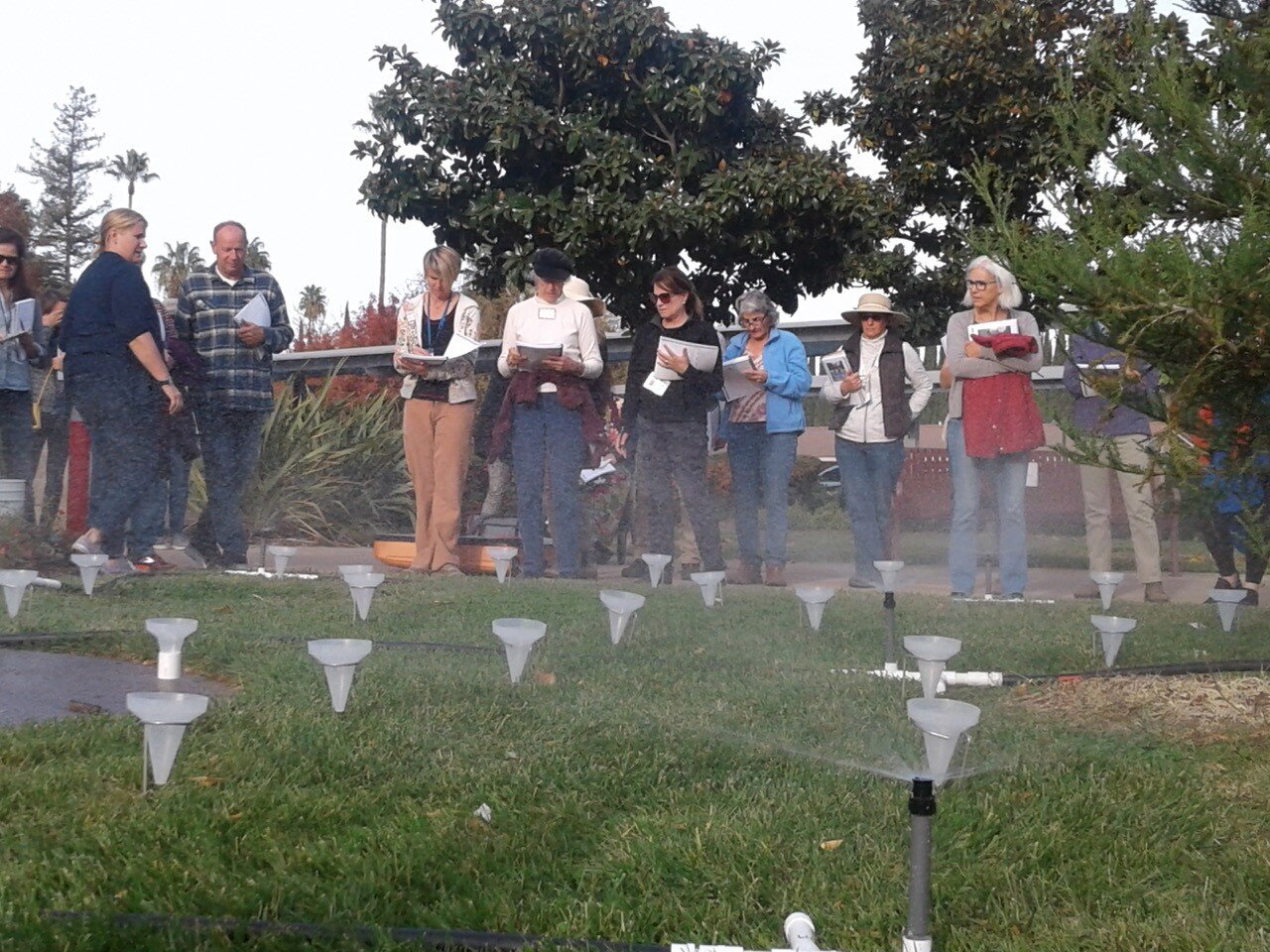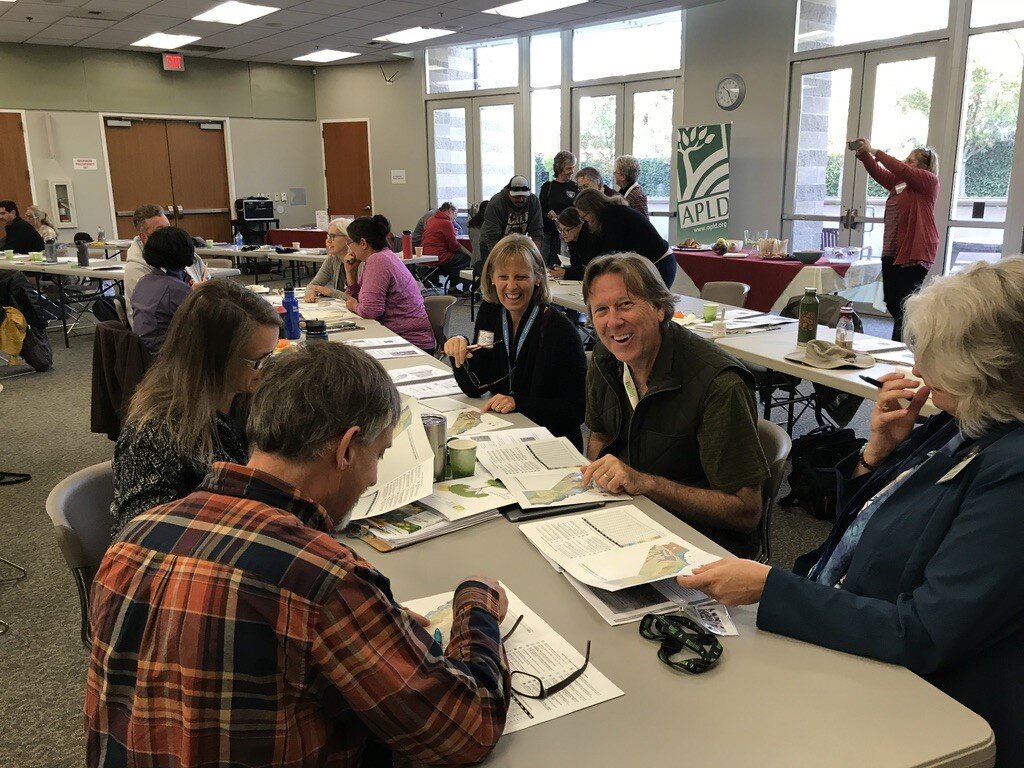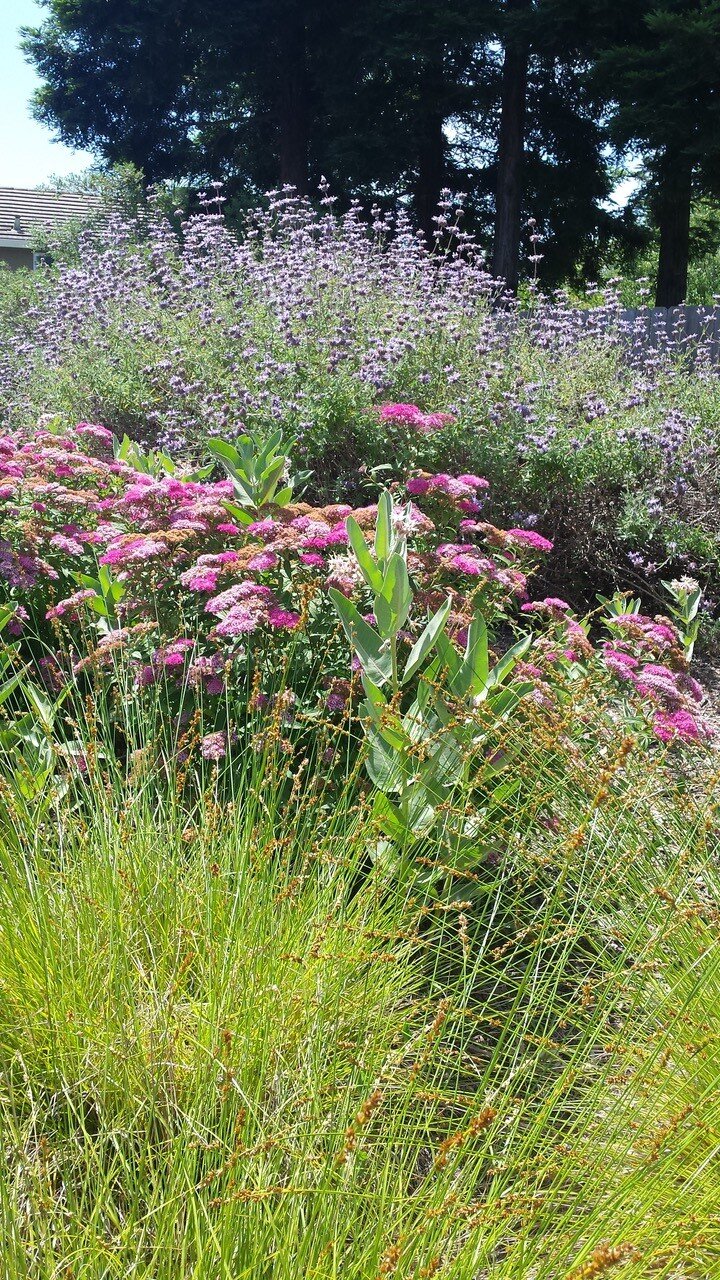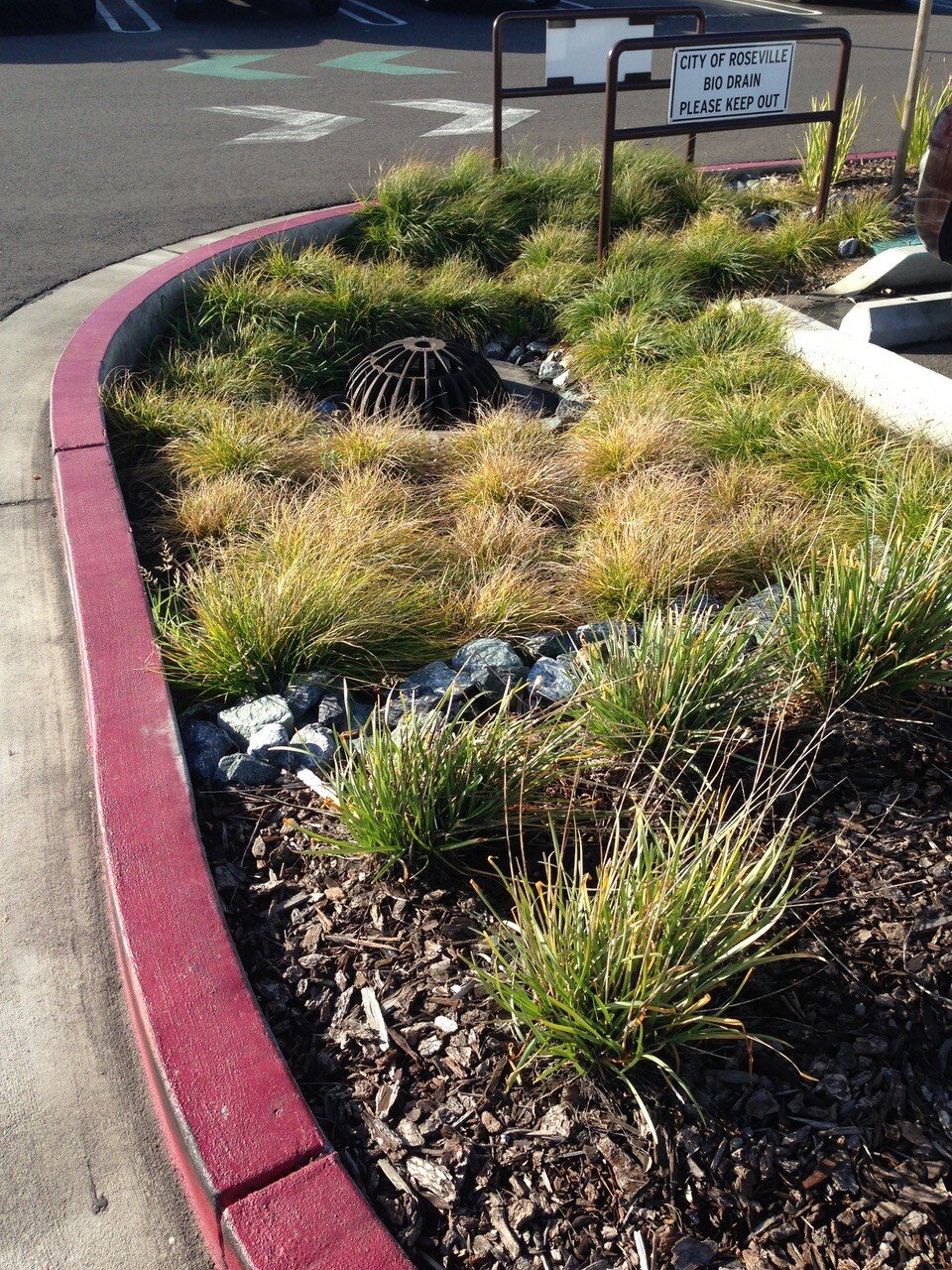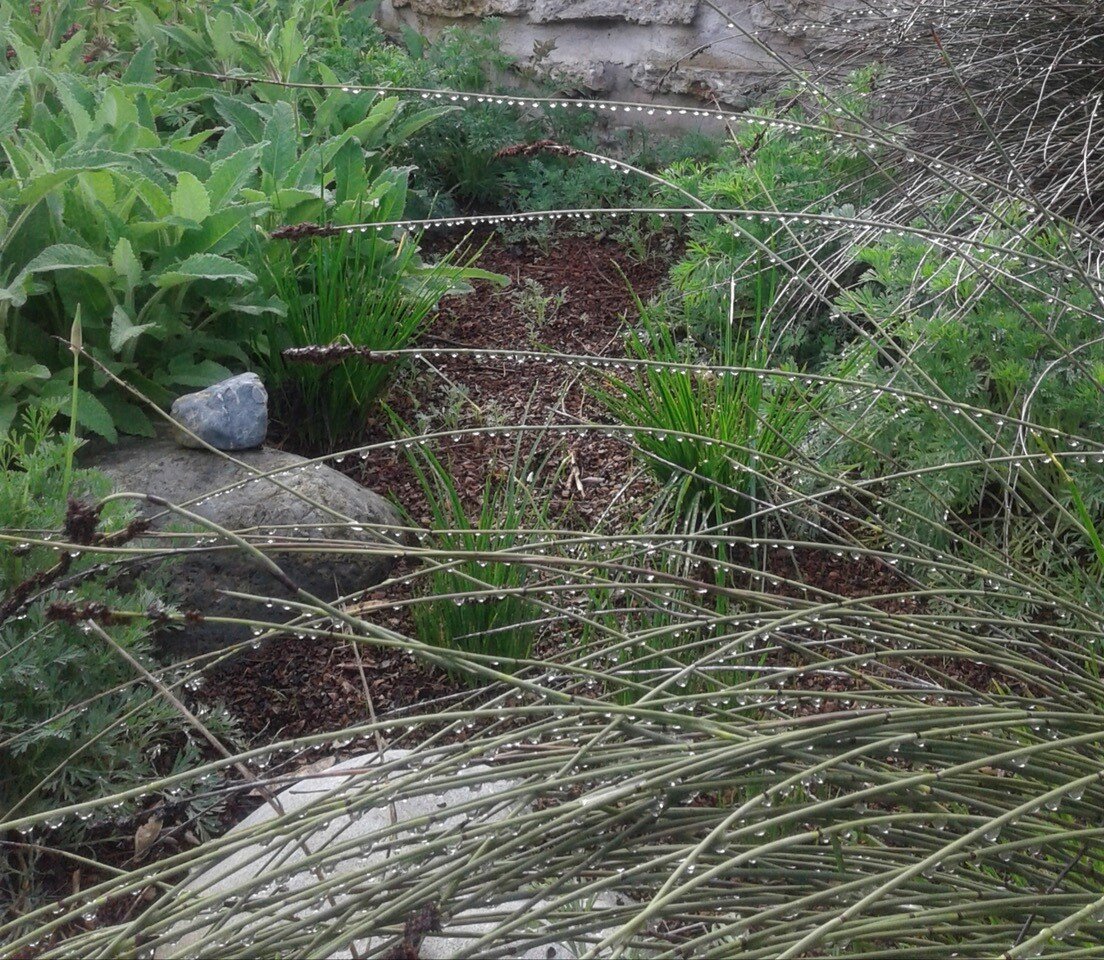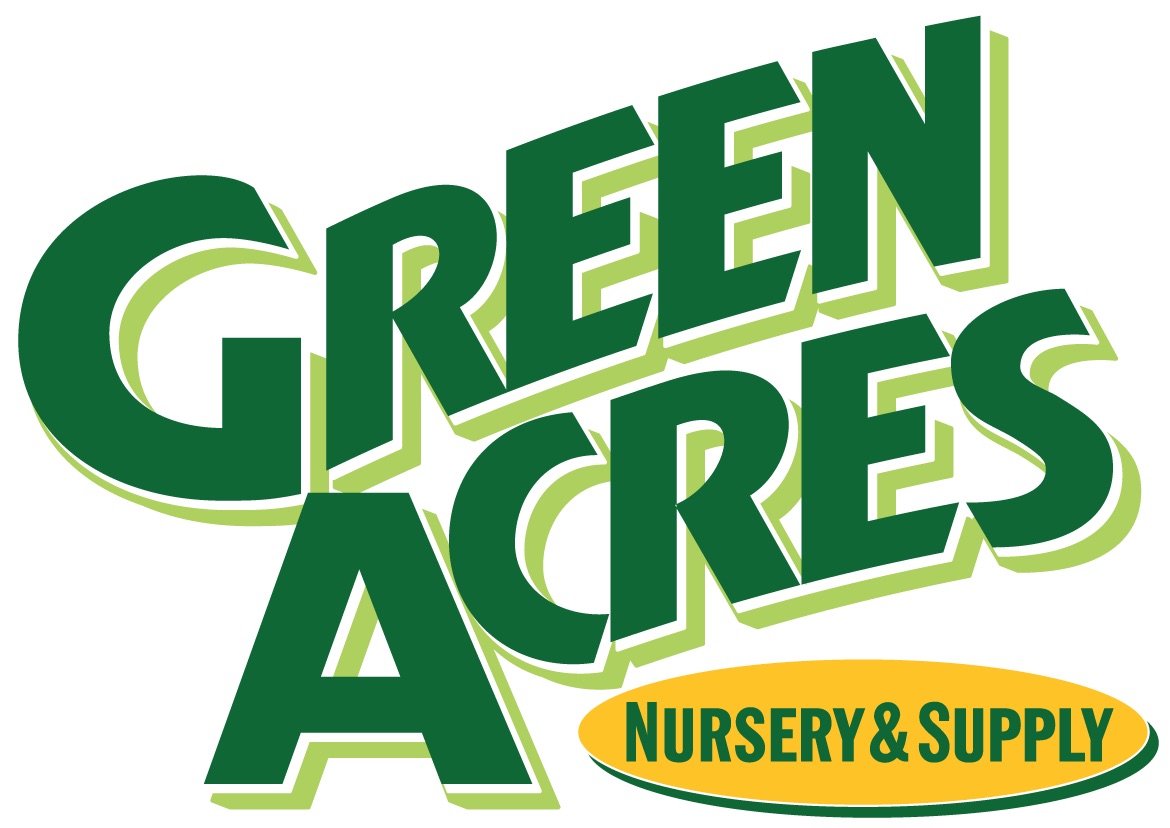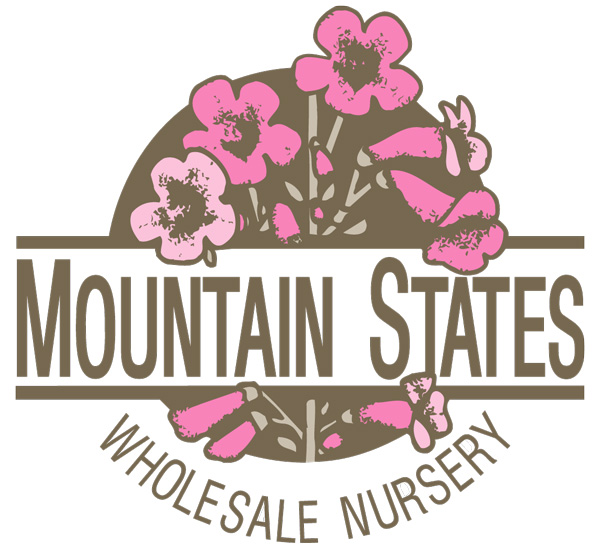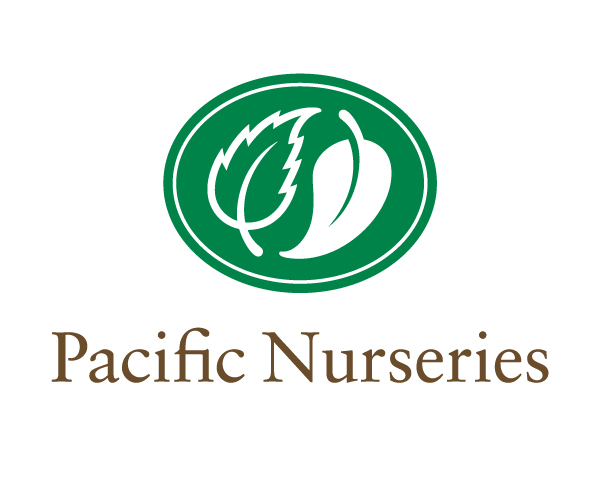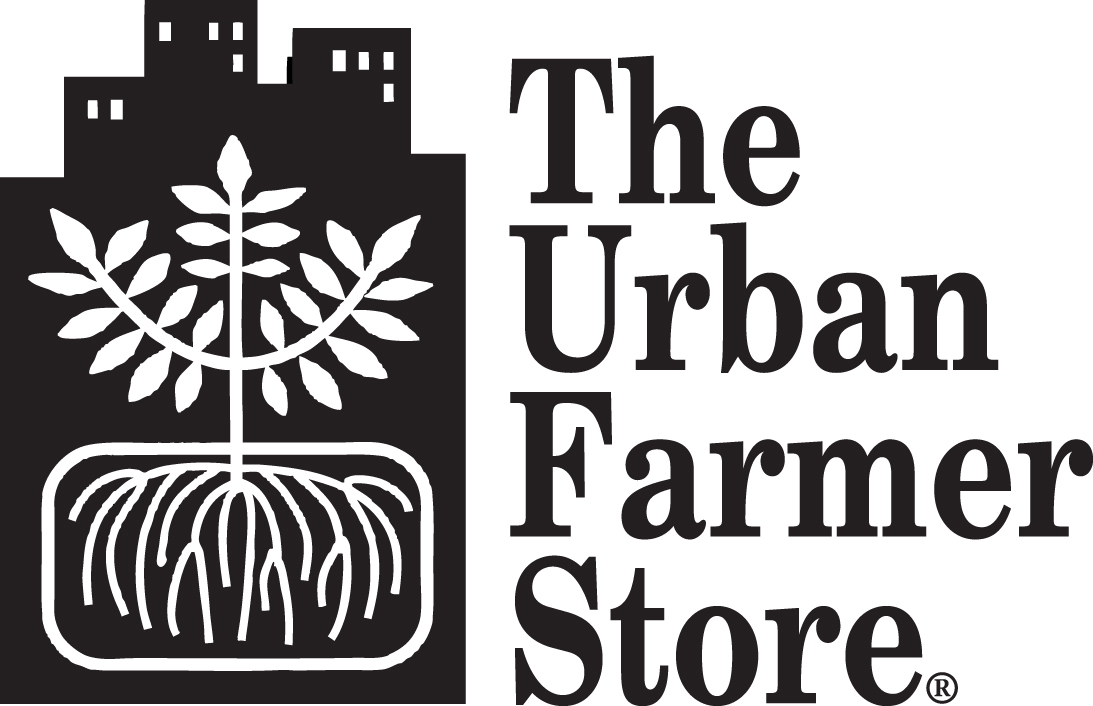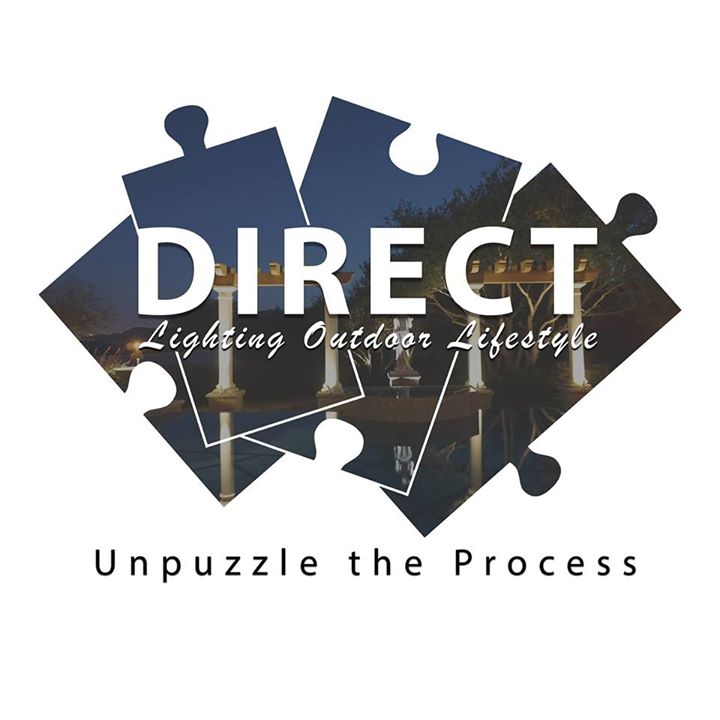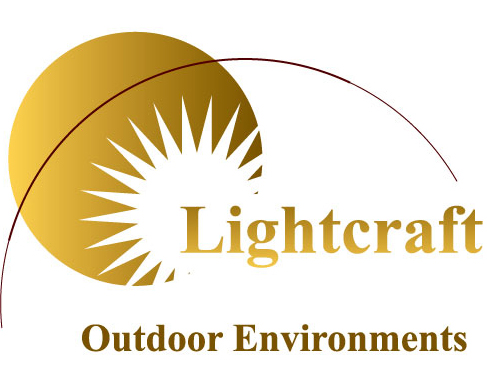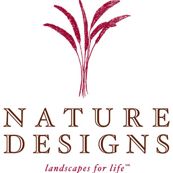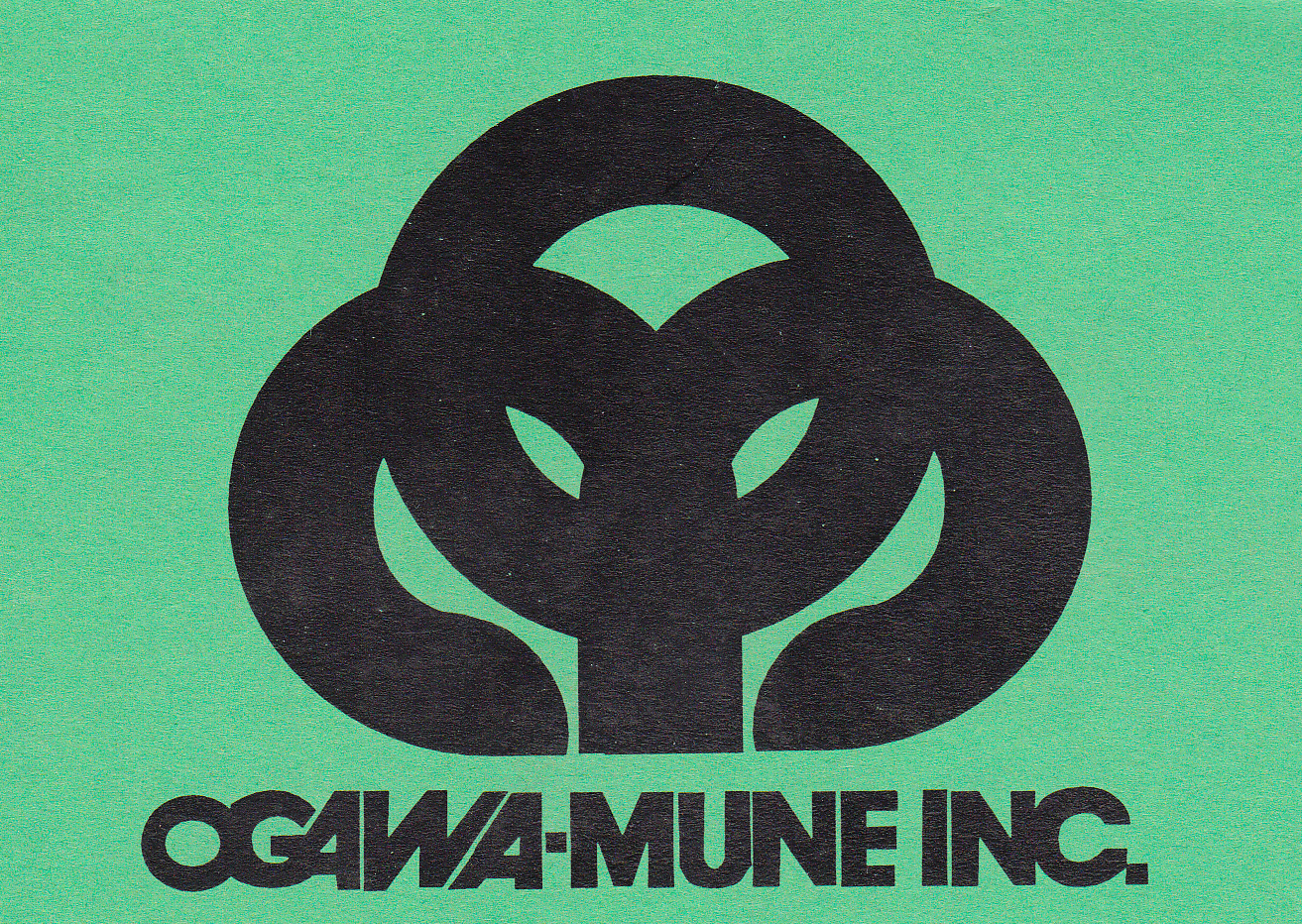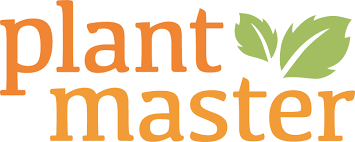FROM THE CHAPTER PRESIDENT
Francesca Corra, APLD
Welcome to a New Year and a New Decade!
Yes, it’s me again. Can you believe that I raised more money than any other candidate to get myself reelected for a third year as your President? And can you believe that I have successfully squashed every attempted coup against me?
OK…so neither of these is even remotely true. The truth is that we need people to step up and get involved in the leadership of APLD. I promise you…it is one of the best things you can do for yourself as a business owner. Please consider joining either the CA board or your district board.
Advocating for the profession of Landscape Design and our right to practice is one of the most important things we do. These are our businesses, our livelihoods. We all have to be proactive. If you have not already renewed your membership, please do so. There is strength in numbers and we are an incredible community.
Your districts have been busy lining up amazing programming for this coming year. Start by coming to one event if you have not already. Allow yourself to receive the gift of coaching, wisdom, strategy, resources and friendships in APLD. Speaking of resources….I am proud to introduce this issue of California Landscape Design dedicated to California Native Plants. Prepare to be inspired and go native!
My wish is for 2020 to be an epic year for all of us. There has never been a better time than right now, the beginning of a new decade, for each of us to attain the abundance we deserve!
Francesca
CONTENTS
Simply scroll down to read the articles.
You may also click on the section titles below.
Letter from the Chapter President
Francesca Corra, APLD
TOOLS AND TIPS:
Why Natives by Katherine Novick
The Mesocosm of Community by Shawn Maestretti and Leigh Adams
PLANT SPOTLIGHT:
Designer Plant Picks: Our Favorite Natives
Meet the Boards
Native Gardens around the State:
1. Andrea Doonan
2. Eileen Kelly
3. Jeannie Fitch
NatureScapes: A Turf-to-Natives Design Program by Jodie Cook
Beauty and the Beast: A Fairytale Design by Shawn Maestretti
Welcome New Members
Photo courtesy of Jude Parkinson Morgan.
TOOLS AND TIPS:
WHY NATIVEs: part one
by Katherine Novick
Native Valley Landscape Design, Napa, CA
When I first started working with plants professionally I was mostly interested in vegetables, that soon gave way to medicinal herbs and then finally to natives. My passion for natives is now eight years strong. I’ve built a business around working with them and spend a lot of my spare time learning about them.
Somehow the allure of natives hasn’t quite hit the mainstream, while it feels like it's growing, it’s often something I have to explain and even defend at times. So understanding its root in my personal story and identifying how its lasting importance to me has expanded with a sense of urgency at times feels necessary.
My method for spreading the good gospel of native plants, while evolving, is to design landscapes with a high percentage if not complete of natives and do so in an alluring way that feels like something we are familiar with, both in the historical sense of garden design and in a deep unconscious connection we have as humans to the beauty and wonder of our surrounding environments.
I think one road block for people when it comes to appreciating the value of a native garden can be found in the deepening distance we have created between us and the natural world. That feeling of other, out there, the divide between our man made manicured safety net (lawn) and the expansive and literal forest of unknown has only increased with time.
With the divide growing, and habitat loss increasing due to a number of factors (development, waste, invasive species, climate change, and more) one option that feels realistic is to bring the natural, habitat supporting environment to us.
As a landscape designer I am not here to condemn our continued push of development into the “wild” (I’ll save that for another space), and I’m not here to suggest that we give up our modern lives and “go back to the land”, I simply want to recommend an alternative to our current predicament* that feels like something we can all accomplish. I call it Residential Restoration, and it is simple. Instead of planting gardens full of exotics, plant them with what has evolved to thrive and support habitat in your local environment. Use your garden, your backyard, your front lawn, as an opportunity to bring some restored balance to the earth. Take advantage of the context, a small scrap of earth where you get to decide what lives and dies and make the choice to invite back in what came before you.
Photos courtesy of Katherine Novick.
With native plants at your doorstep there is an immediate point of connection to the greater ecology of the place you call home. Beyond your small plot of land that connect extends to the watershed you rely on for so many human needs. Planting natives makes a small impact that expands infinitely as neighbor’s are inspired and take your lead and birds, insects, mammals and reptiles rejoice. When you become familiar with native plants that you chose and care for and see throughout the seasons and their individual life cycles, you have the added bonus of being able to identify more vegetation on your next hike and this gets exciting because you may now want to go on those hikes more often to see what is in bloom, how landscape is regenerating after fire, or even to monitor what is changing.
I describe these potential acts because they are exactly what has happened to me. Getting to know native plants by planting them wherever I call home (even if that home is only temporary) has increased my desire to want to know them more, enjoy them, protect them and most certainly celebrate them. It’s deepened my connection to a world that is free and ours to enjoy as long as we continue to protect it. And it’s helped alleviate the stress I experience in our fast paced world by slowing things down, as I take the time to explore and seek out a new species, so I can actually enjoy all the diverse beauty on this planet. For that I am forever grateful to native plants and the journey they have taken me on.
The Mesocosm of Community
by Shawn Maestretti and Leigh Adams
Studio Petrichor (Leigh Adams, Gisela Garay and Shawn Maestretti) with Pasadena Water and Power and the community of Pasadena and beyond. Photo courtesy of Studio Petrichor.
Community….what a powerful word. It’s a feeling, an interaction, a reciprocal relationship, an exchange, protection, survival and most importantly, it’s regenerative. It is regenerative because community nourishes and enriches relationships and living systems. At Studio Petrichor we like to think about how can we take our regenerative practices, designs, and discoveries and allow them to migrate, ripple and connect like mycorrhizal relationships with the intent of benefitting others. How can we do that? Through the platform of our communities.
Transmitting our meaningful work directly to governments, agencies, educational institutions and active organizations is one way to start. But we have also experienced multiple successes by starting in our communities with education, design courses and hands-on workshops.
It is important to us to acknowledge the teachings and leadership of the Green Gardens Group (G3) that have inspired us to take action, not only in our private and commercial projects, but in every action we take. We have also been greatly influenced by the work at the Crescent Farm in the Los Angeles County Arboretum.
Recently, Pasadena Water and Power asked us to share climate awareness, regenerative landscape practices, and the work of the Crescent Farm in their community. The response has been resoundingly positive and we have an upcoming series of programs with the City of Pasadena that we hope to carry into other local cities.
In our home community of Altadena, the engagement and enthusiasm in our hands-on hugelkultur workshops has been most gratifying. Besides seeing our participants go home and begin their own hugels and/or lasagna mulching, we are delighted to have them return to our classes time and time again, accompanied by friends and family, to share in the joy of learning regenerative practices.
We like to think that the Studio Petrichor mascot is Mycorrhizal Fungi. We wish to support, exchange and nourish our communities as we grow and learn together.
Thank you to Pamela Berstler and the Green Gardens Group for inspiring action and the Crescent Farm for encouraging experimentation and new growth.
PLANT SPOTLIGHT:
designer plant picks: our favorite natives
Photo by Soleil Tranquilli.
Frangula (Rhamnus) californica, COFFEEBERRY
I sing praise for the lowly Frangula californica. Never a star, always a wallflower, nevertheless she persists. Coffeeberry is my number one evergreen go-to for foundations, dividers, shade gardens, and (cringe) even hedges. She handles the most inept pruning with grace. She is that perfect 'hidey' shrub that birds seek out 'twixt tree and sky. In Spring at the natives nursery, where is all the buzz? It's Miss Frangula hosting the wild pollination party with her tiny blooms. She's my green girlfriend, and her cousins Mound San Bruno and Eve Case are always welcome in my gardens.
Photo by John Black, APLD.
Epilobium septentrionale ‘Wayne’s Silver’
SILVER CALIFORNIA FUCHSIA
Because California gardens comprise such a range of conditions, my favorite native is a versatile groundcover that can take lawn overspray or drought… oak shade or blazing sun… clay soil or garden loam. It’s also fire-resistant, a hummingbird magnet, and needs no more maintenance than an annual hacking. Plus, it blooms its socks off in autumn while so many of its native neighbors are going dormant! I can only be describing Epilobium, or California Fuchsia. I’m partial to E. septentrionale, especially ‘Wayne’s Silver’, but it’s indistinguishable from E. canum so either will do. I love its cool foliage and hot flowers at the base of a rainbow hued Phormium, or paired with Salvia clevelandii and blue Festuca, or under old oaks with naturalized Narcissus to provide color when the Epilobium finally goes dormant.
Photo by Laurie Schofield.
Salvia clevelandii ‘Winnifred Gilman’, CLEVELAND SAGE
This Salvia is short-lived (5 years more or less) but while it is in its prime it is lovely. Deep blue flowers on wine-red stems set her apart from other cultivars of Salvia clevelandii and last quite a while from late spring well into summer. An on warm summer evenings you will get a whiff of the most delicious wild scent from the fragrant foliage. We use it in full sun combined with other natives or grasses that set off the grey-green leaves. Mature size is about 3’ x 3’. Very low water.
Photo by Laurie Schofield.
Eriogonum arborescens, SANTA CRUZ ISLAND BUCKWHEAT
This Eriogonum will become a large shrub over time. Sporting grey-green leaves and peeling reddish bark, Eriogonum arborescens grows slowly into quite a showstopper. The umbels of flowers start out pinkish and mature to a reddish brown that persist for months. We use it in full sun with Arctostaphylos species and grasses. Mature size can range from 3’-4’ x 4’-6’ in our experience. Very low water. This is such a wonderful plant. We would put one in almost every project if they were more available. Shown here with Leymus ‘Canyon Prince’ and Arctostaphylos ‘Dr. Hurd’.
Photos by Anna Wendorf.
Arctostaphylos manzanita ‘Dr. Hurd’, DR. HURD MAZNANITA
I can't get enough of this beautiful manzanita. It looks great in most settings from contemporary to wild native gardens. Its crisp neat appearance and muted gray green look great in most settings- from contemporary to wild gardens. I love the contrast when set against a dark green Emerald Carpet Manzanita or Coffeeberry, especially when the sun lights it up in the afternoon. An added bonus is the smooth dark red bark which can look sculptural or subdued. I have found Dr. Hurds to be fussy for the first year, but very easy after established.
Photo by Mary Fisher.
Asarum caudatum, WILD GINGER
This is my all-time favorite groundcover for shady spots. The bold texture is often just what is needed in native palettes. You have to look closely, but the maroon flowers in the summer are truly bizarre and wonderful. In this photo I have it tucked under a coast live oak with Adiantum pedatum, Satureja douglasii and Mahonia ‘Soft Caress’.
Photo courtesy of Jude Parkinson Morgan.
MEET THE BOARDS
APLD California Chapter 2020 Board of Directors: These are the volunteers working at the state level, behind the scenes, to ensure that you have the best value for your APLD membership and that your right to practice landscape design in the state of California is protected. We work hard, but are a fun group and are always looking for new volunteers. Do you have skills and are willing to help by taking on just one thing? Please consider serving at the Chapter (state) or District (local) level.
California Chapter President
Francesca Corra, APLD
president@apldca.org
California Chapter Sponsorship Chair
Julie Molinare
sponsorship@apldca.org
California Chapter Treasurer
Martin Carrion Van Rijn
treasurer@apldca.org
California Chapter Secretary
Tina Henricksen
secretary@apldca.org
California Chapter Communications Chair
Laura Kukulski
communications@apldca.org
APLD Bay Area District 2020 Board of Directors: These are the volunteers working at the local level in the greater San Francisco Bay area. If you’ve been thinking about getting more involved with APLD, please contact our president at BAdistrict@apldca.org.
Bay Area District President
Janet Cohen
BAdistrict@apldca.org
Bay Area District Immediate Past Co-President
Janet Enright
Bay Area District Immediate Past Co-President, Current Interim Treasurer
Tina Roushall
Bay Area District President Elect
John Black, APLD
Bay Area District Secretary
Maryanne Quincy, FAPLD
Bay Area District Communications Chair
Laura Kukulski
Bay Area District Membership Chair
Mary Lou Hadley
Bay Area District Membership Chair
Kathleen Olson
Bay Area District Membership Chair
Laurie Schofield
Bay Area District Membership Chair
Laura Ponder
Bay Area District Sponsorship Chair
Anna Wendorf
Bay Area District Programming Chair
Karen Mays
Bay Area District Programming Chair
Patricia St. John, FAPLD
Bay Area District Programming Chair
Bonnie Brock, APLD
Bay Area District Programs Chair
Kim Raftery
Bay Area District Programs Chair
Kelly Kilpatrick
Bay Area District Outreach Chair
Sophia Cunningham
Bay Area District Member At Large
Lee Mangus
APLD Sacramento District 2020 Board of Directors: These are the volunteers working at the local level in the Central Valley. If you’ve been thinking about getting more involved with APLD, this is a great place to start. Please contact our president at SACdistrict@apldca.org with any questions you may have about volunteering. We can especially use help with these positions: secretary, communications and PR, membership, and sponsorship.
Sacramento District Co-President
Marcia Scott
GLAdistrict@apldca.org
Sacramento District Co-President, Membership Chair
Martin Carrion Van Rijn
GLAdistrict@apldca.org
Sacramento District Immediate Past President
Tina Henricksen
Sacramento District Vice President
Soleil Tranquilli
Sacramento District Advocacy & Sustainability Chair
Cheryl Buckwalter
Sacramento District Programs Chair
Gary Kernick
APLD Greater Los Angeles District 2020 Board of Directors: These are the volunteers working at the local level in the greater Los Angeles area. If you’ve been thinking about getting more involved with APLD, this is a great place to start. Please contact our president at GLAdistrict@apldca.org with any questions about volunteering.
Greater LA District President
Debbie Gliksman, APLD
Greater LA District Immediate Past President
Johanna Woollcott
Greater LA District Immediate Past President
Marilee Kuhlmann
Greater LA District Vice President
Leesa Martling
Greater LA District Secretary
Chelsea Sullivan
Greater LA District Treasurer
Jonathan Harnish
Greater LA District Sponsorship Chair
Julie Molinare
Greater LA District Programs Chair, Garden Tour Co-Chair
Arleen Ferrara
Greater LA District Social Media Chair, Community Outreach Chair
Toni Pogue
Greater LA District Membership Chair
Marlene Breene
Greater LA District Member At Large
Jackie Scheidlinger
APLD San Diego District 2020 Board of Directors: These are the volunteers working at the local level in the greater San Diego area. If you’ve been thinking about getting more involved with APLD, please contact our president at SDdistrict@apldca.org with any questions about volunteering.
San Diego District President
Andrea Doonan
SDdistrict@apldca.org
San Diego District Immediate Past President
David Clarke, APLD
San Diego District Secretary, Programs Co-Chair
Lisa Bellora
San Diego District Treasurer
Michelle Langdon
San Diego District Advocacy & Sustainability Chair
Steve Harbour, APLD
San Diego District Communications Chair
Anne-Emilie Gold
San Diego District PR & Membership Co-Chair
Tracey Grillo
San Diego District PR & Membership Co-Chair
Debra O’Leary
San Diego District Sponsorship Chair
Kimberly Alexander
San Diego District Programs Co-Chair
Jackie Seidman
San Diego District Programs Co-Chair
Amelia Lima, FAPLD
San Diego District Programs Co-Chair
Angela Benson
San Diego District Media /Technology Chair
Brad Lefkowits
San Diego District Member at Large
John Beaudry
San Diego District Member at Large
Joel Berlin, APLD
APLD CA Chapter Support Staff: You won’t see them at District events, or even board meetings, but they are the very important, behind-the-scenes folks with special skills to keep APLD CA Chapter up and running smoothly. We so appreciate all they do.
Frank Weaver is our IT wizard. Many of our operations, like sponsorship renewals for instance, are conducted through the website. Frank has proven to be a godsend to us, as he is incredibly responsive, dependable and knowledgeable. When he isn’t sitting in front of a computer, he enjoys adventurous travel with his son who lives overseas.
Maggie J Elias has been in charge of designing and editing our quarterly publication California Landscape Design for the last two years. She is currently earning her master’s degree in advertising and brand responsibility at the University of Oregon.
Amy Ukena has been doing administrative work for the chapter for a few years now. Among other things, she keeps the online calendar current, keeps chapter and district mailing lists current and sends out mailings regarding programs and special messages to our members. She lives in the SF Bay Area and spends evenings as one half of the jazz duo “Hans and Amy”.
Native Gardens around the State
by Andrea Doonan
Andrea Doonan horticulture + design
San Diego, CA
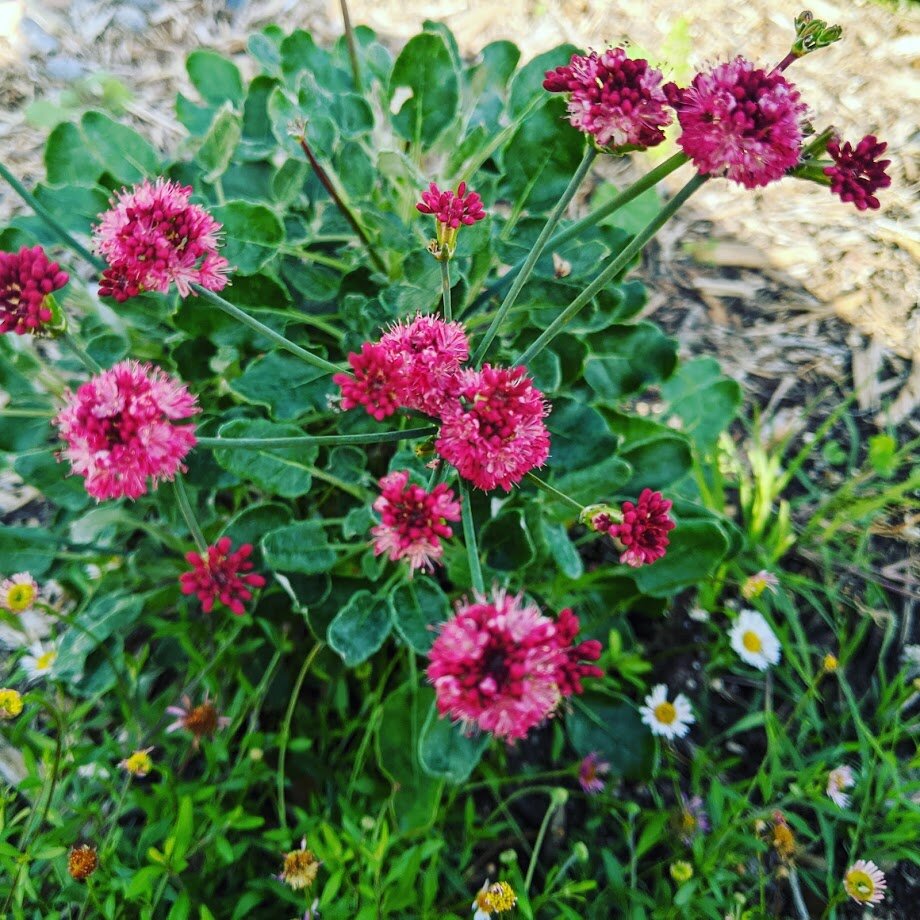
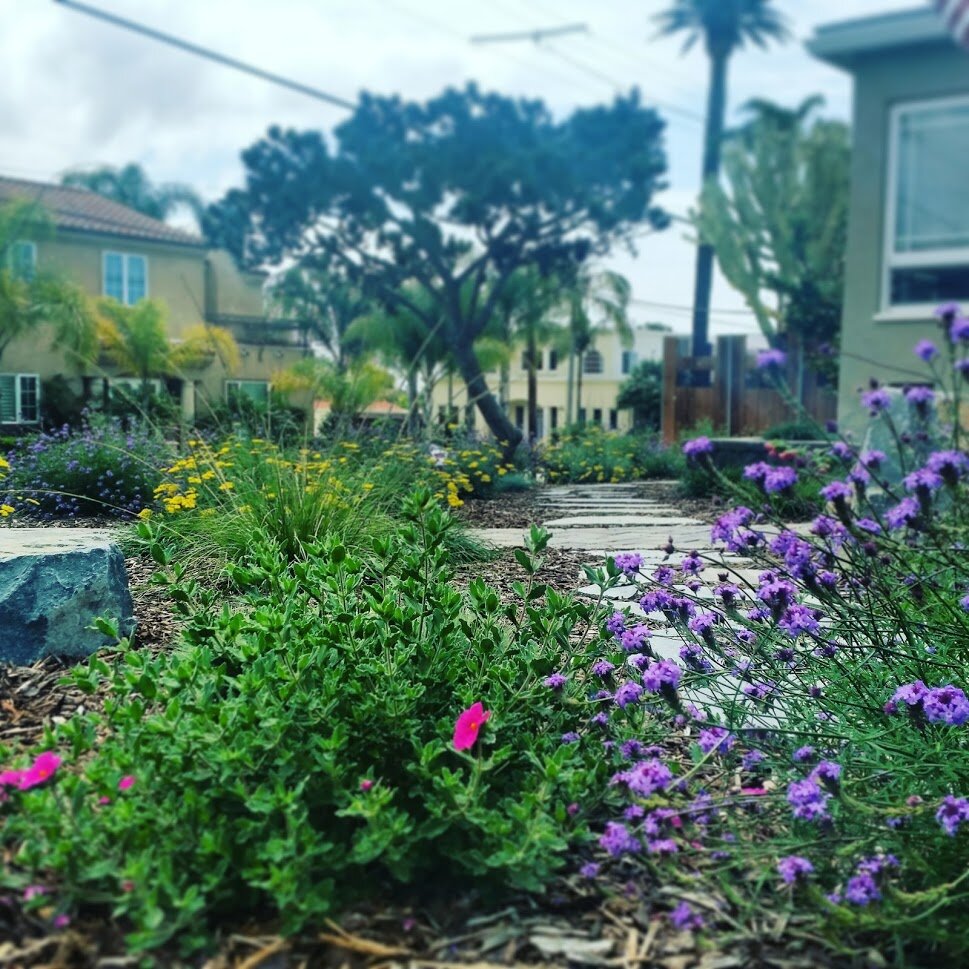

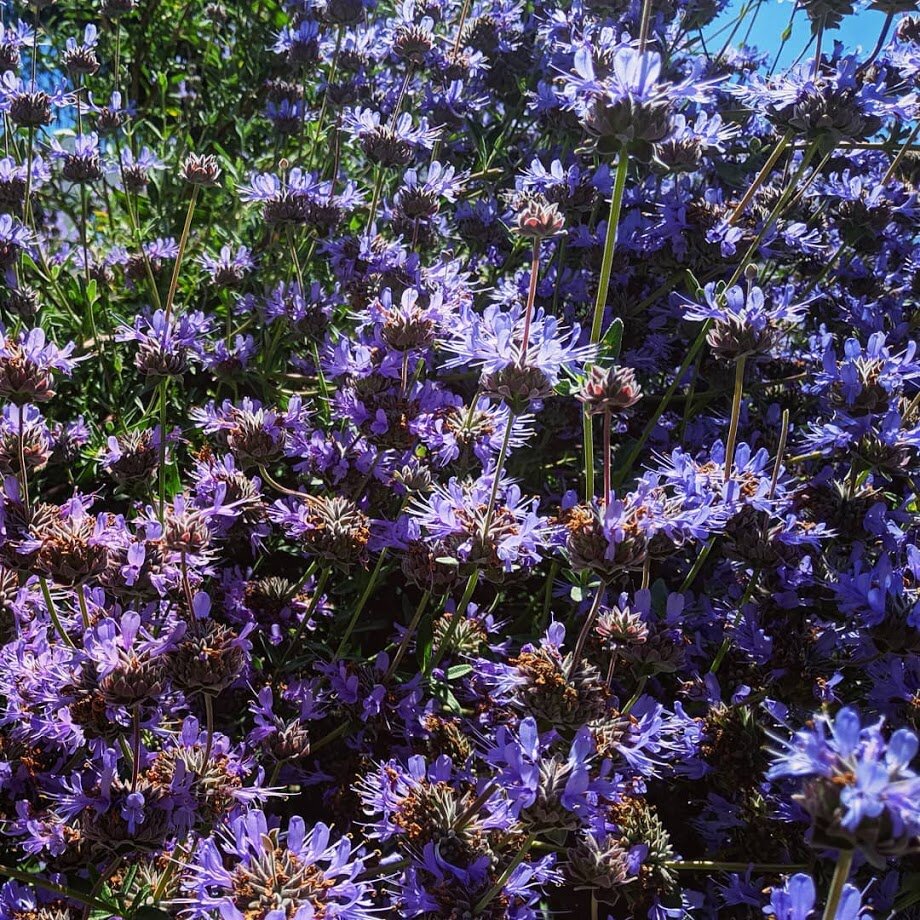
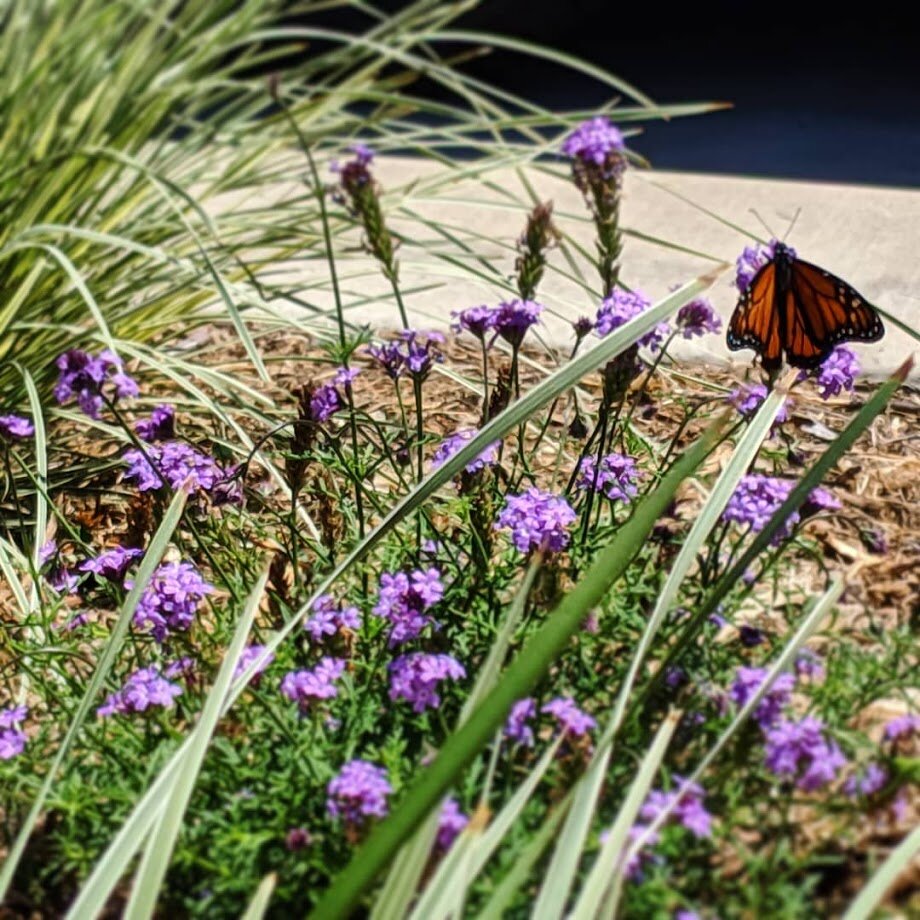
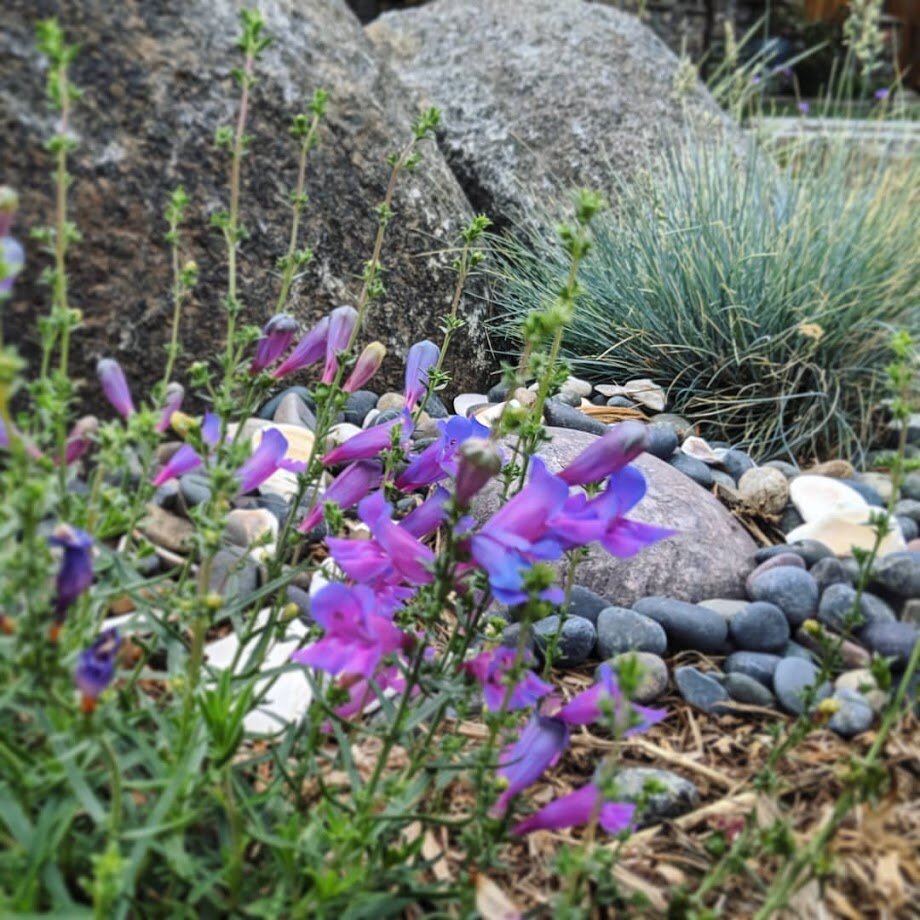
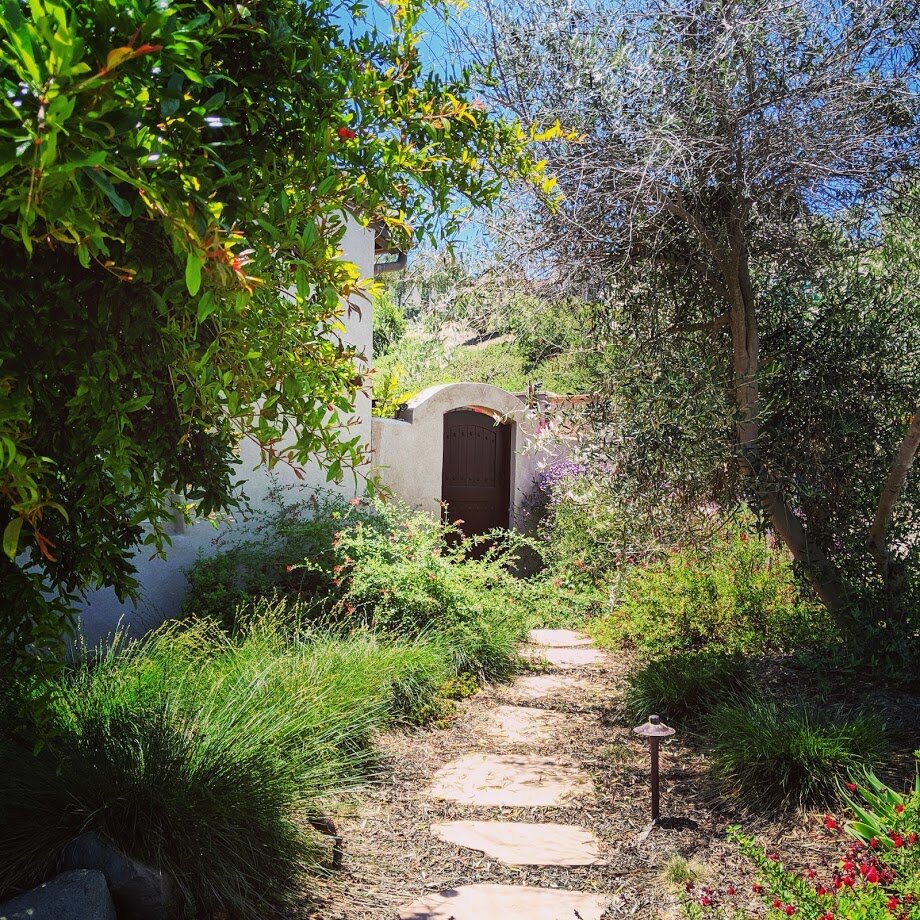
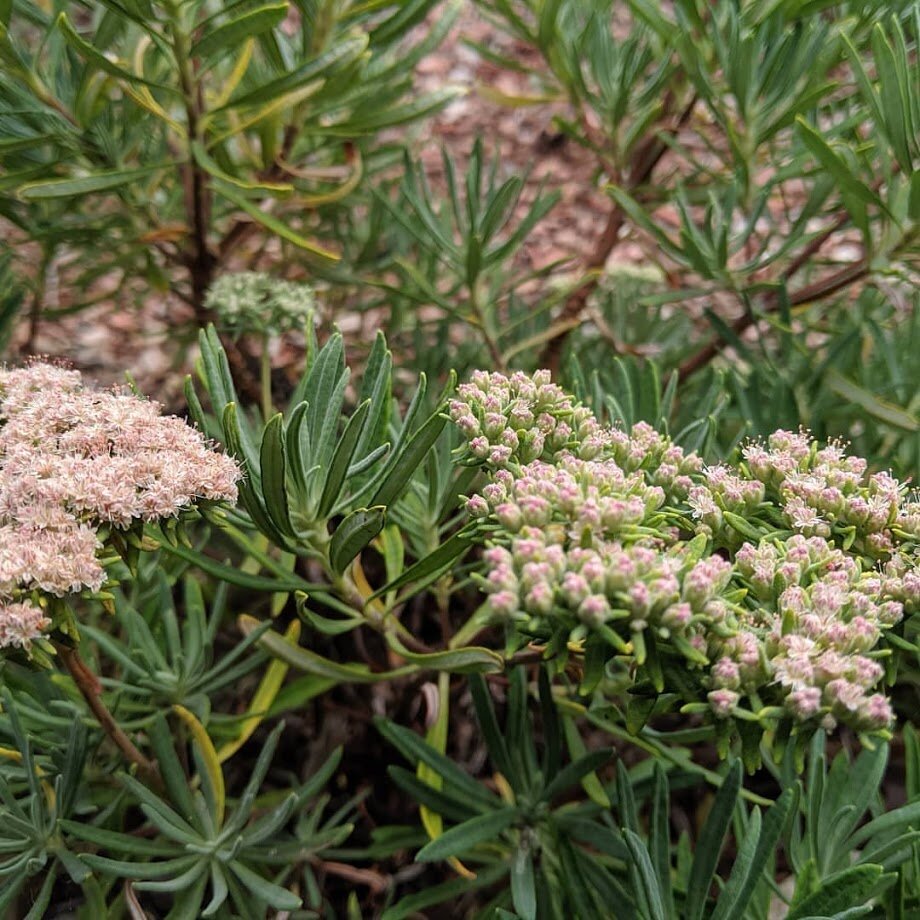

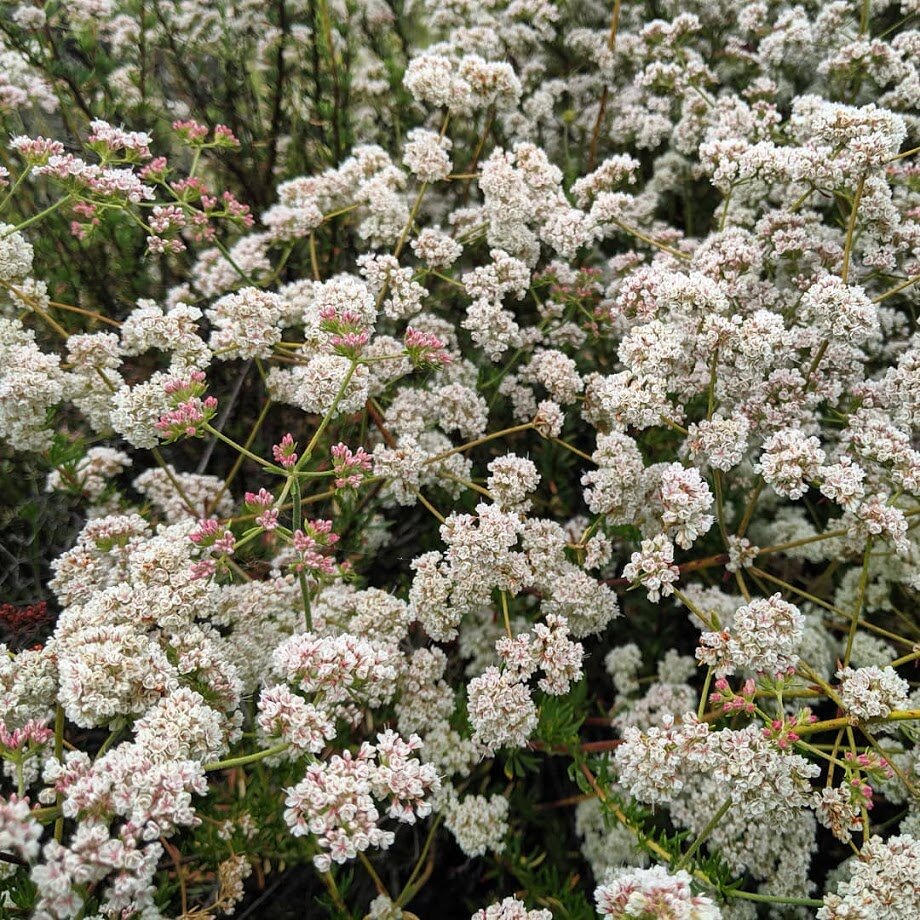
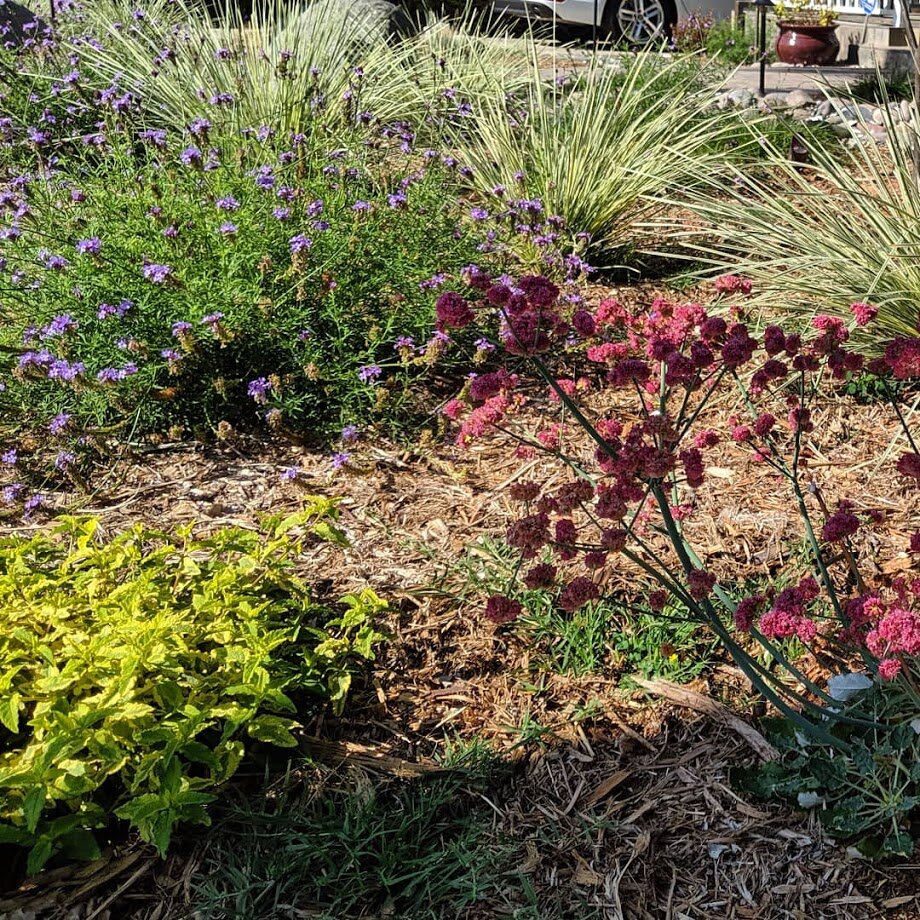
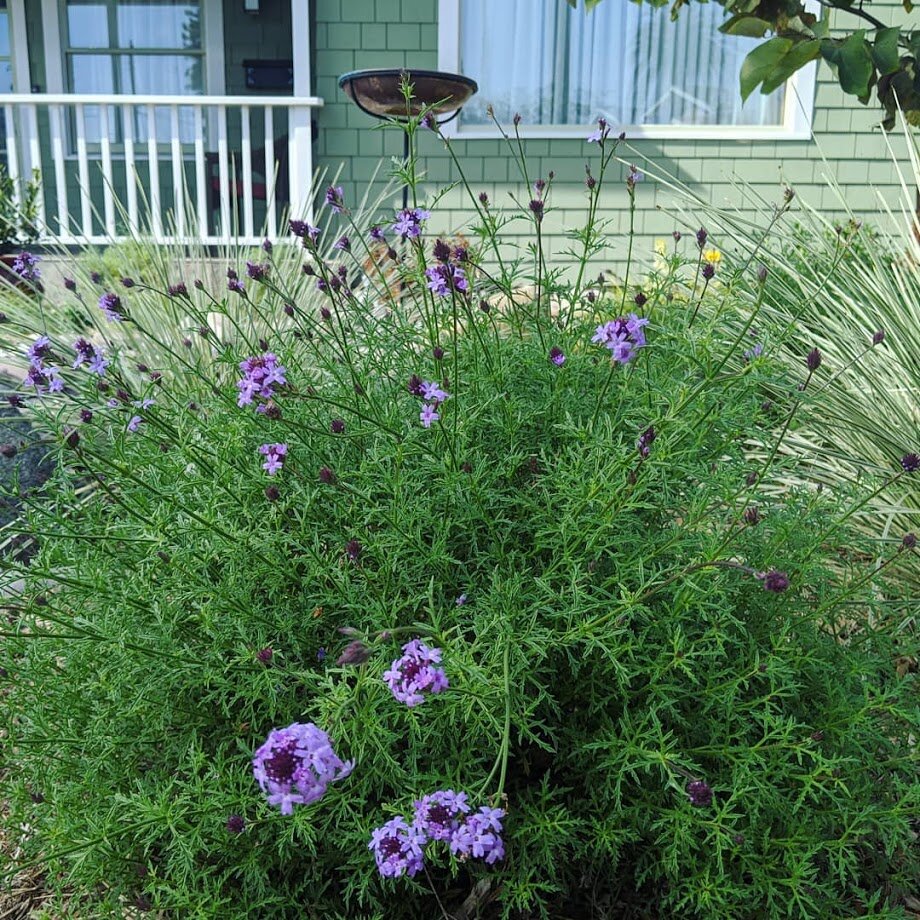
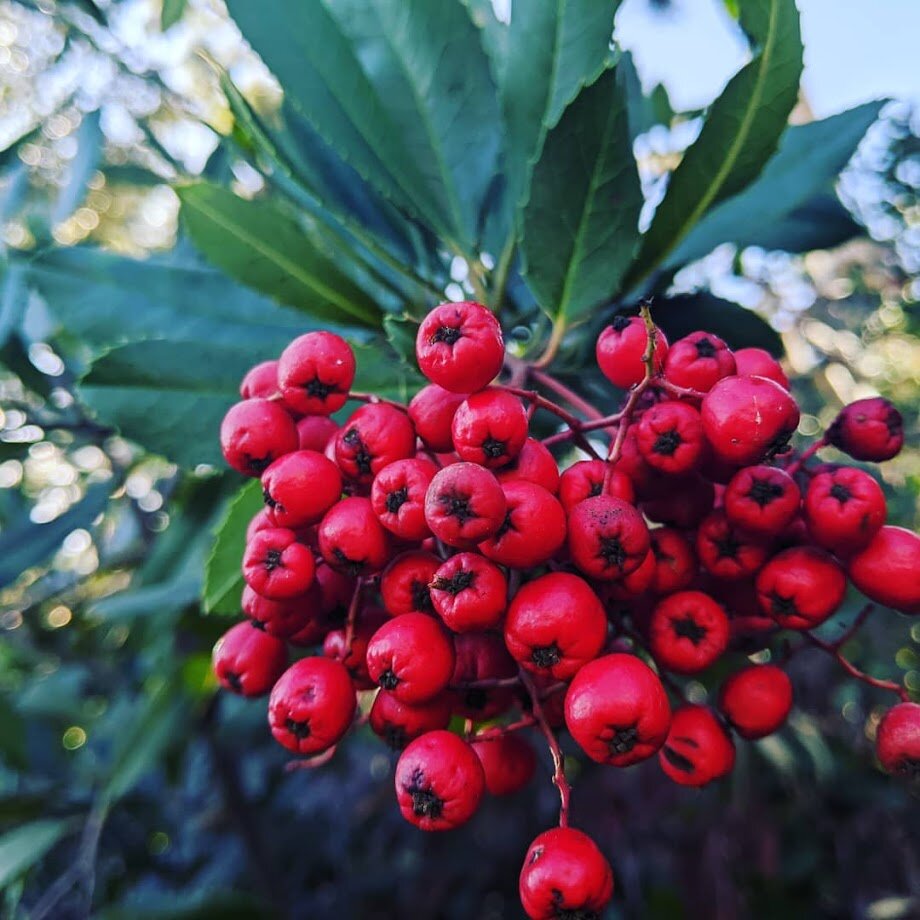
Native and Mediterranean in San Diego
I love to use natives and Mediterranean region plants that play well together- anigozanthos, rockrose and other non native sages are excellent examples of these. As you can see in the images I am a huge fan of the verbena lilacina which seems to never stop blooming and all the pollinators love it just as much as me. I also love Cleveland and white sage, penstemon, our native buckwheats (which do great down here) as well as the lovely toyon which makes such an awesome habitat garden evergreen hedge!
by Eileen Kelly
Dig Your Garden Landscape Design
San Anselmo, CA
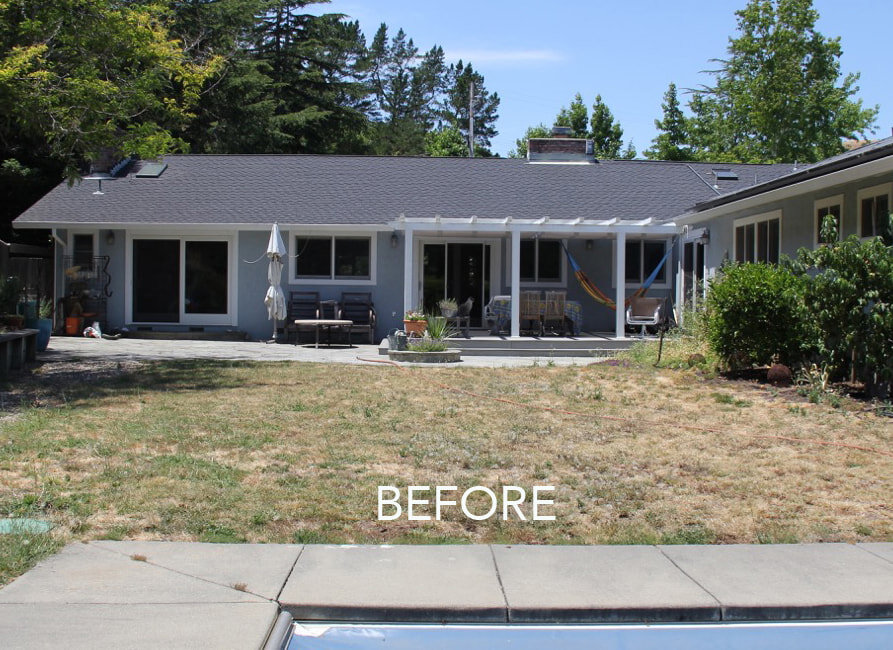
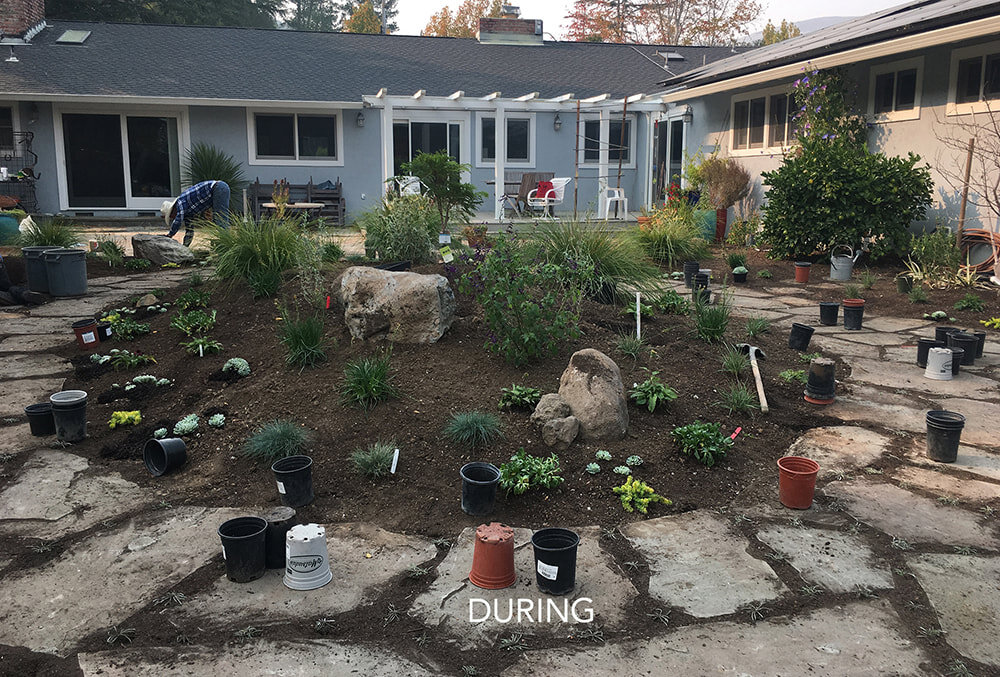
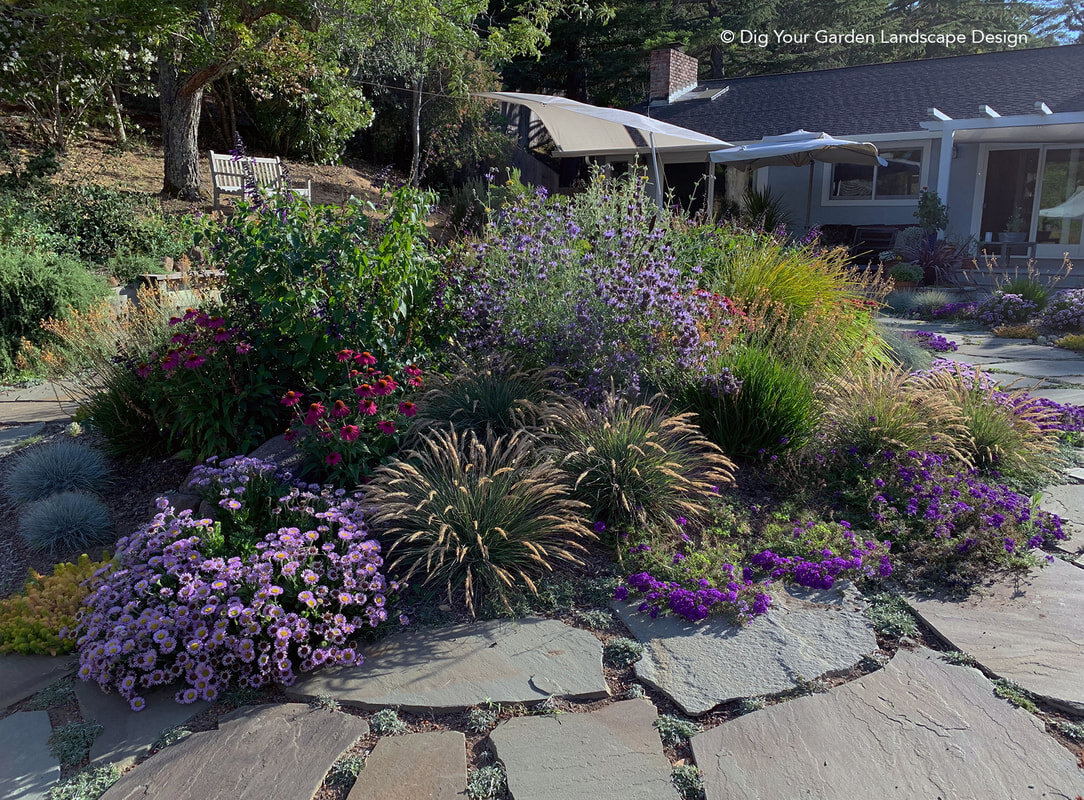
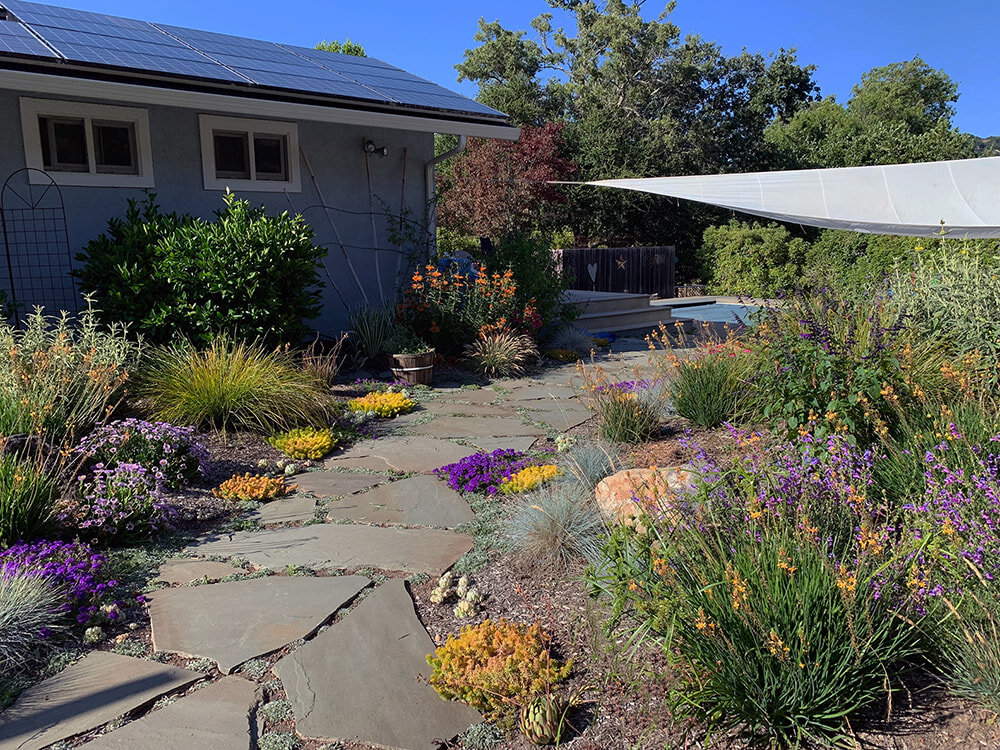
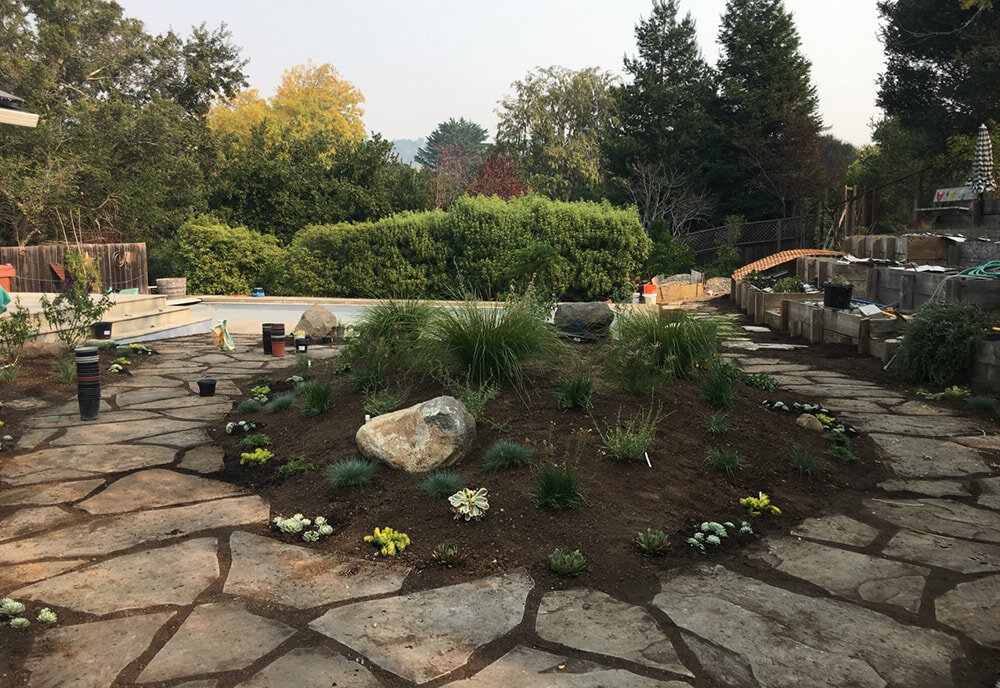
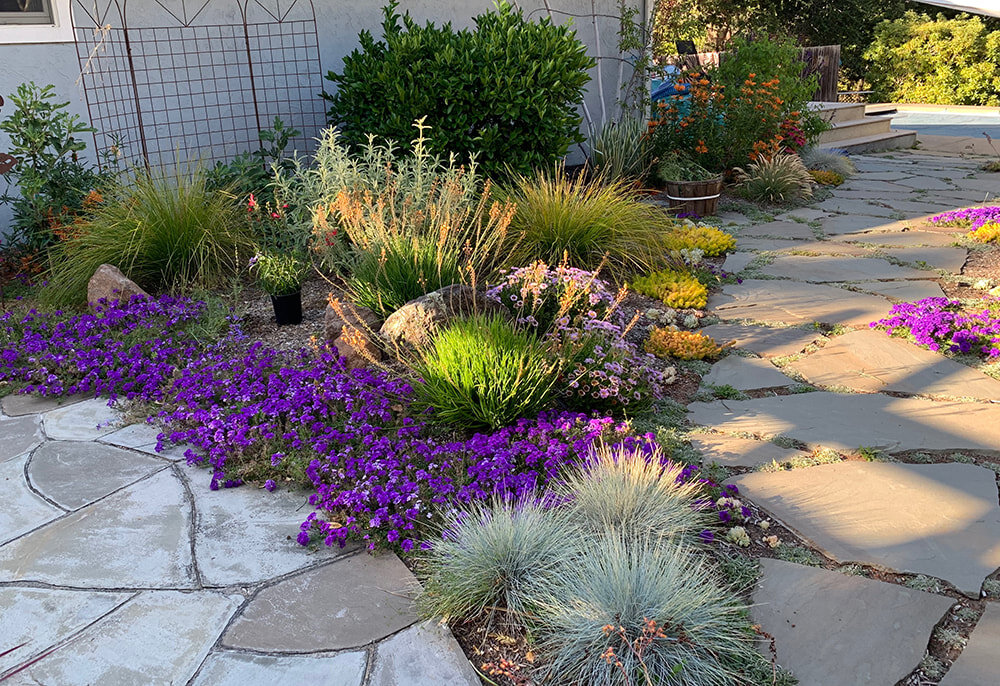

Design Details:
The lawn was replaced with a blue stone pathway and a variety of low-water, low care plants.
A diverse variety of colorful California native shrubs and grasses and plants from other Mediterranean regions create biodiversity and an ecosystem for the birds, the bees and the butterflies.
The plant palette was designed to incorporate plants that bloom and provide interest throughout all seasons for the homeowners to enjoy year-round.
The raised center planting bed and the boulders offer added interest and appeal.
Lawn Replacement in San Anselmo
This landscape has been dramatically transformed into a backyard haven by replacing the water-thirsty lawn with a meandering natural blue stone pathway that circles around a mounted planting bed filled with a variety of colorful plants at various heights. Several California native plants with vibrant flowers, feathery grasses and easy-care, water-wise companion plants from other Mediterranean regions were planted throughout the landscape. Low-growing succulents and ground covers soften the pathway edge and Dymondia margaretae - Silver Carpet was planted in between. On site boulders were repositioned in the planting beds to provide natural focal point, contrast and interest.
by Jeannie Fitch Garden Nest Residential Landscape
Orinda, CA
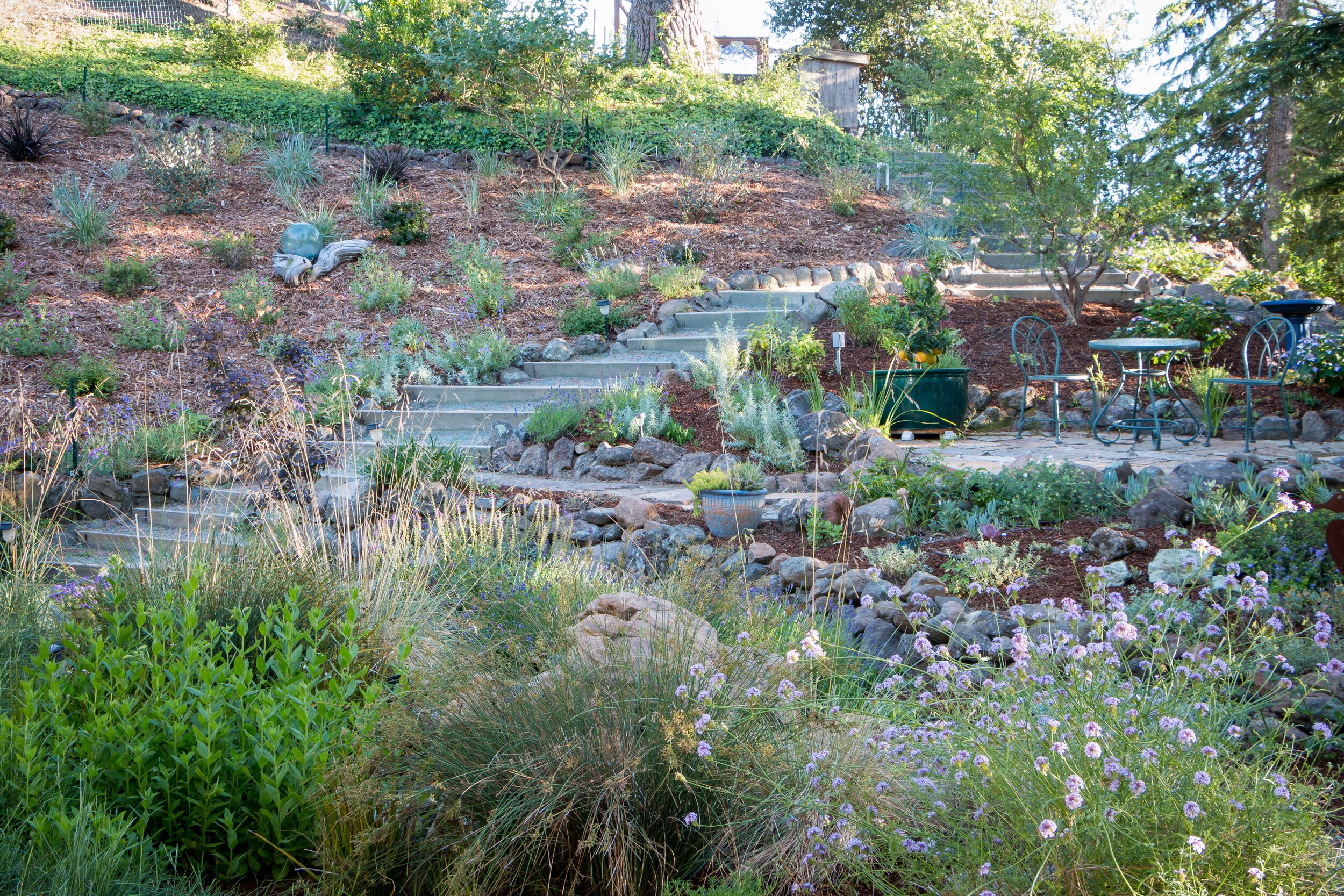
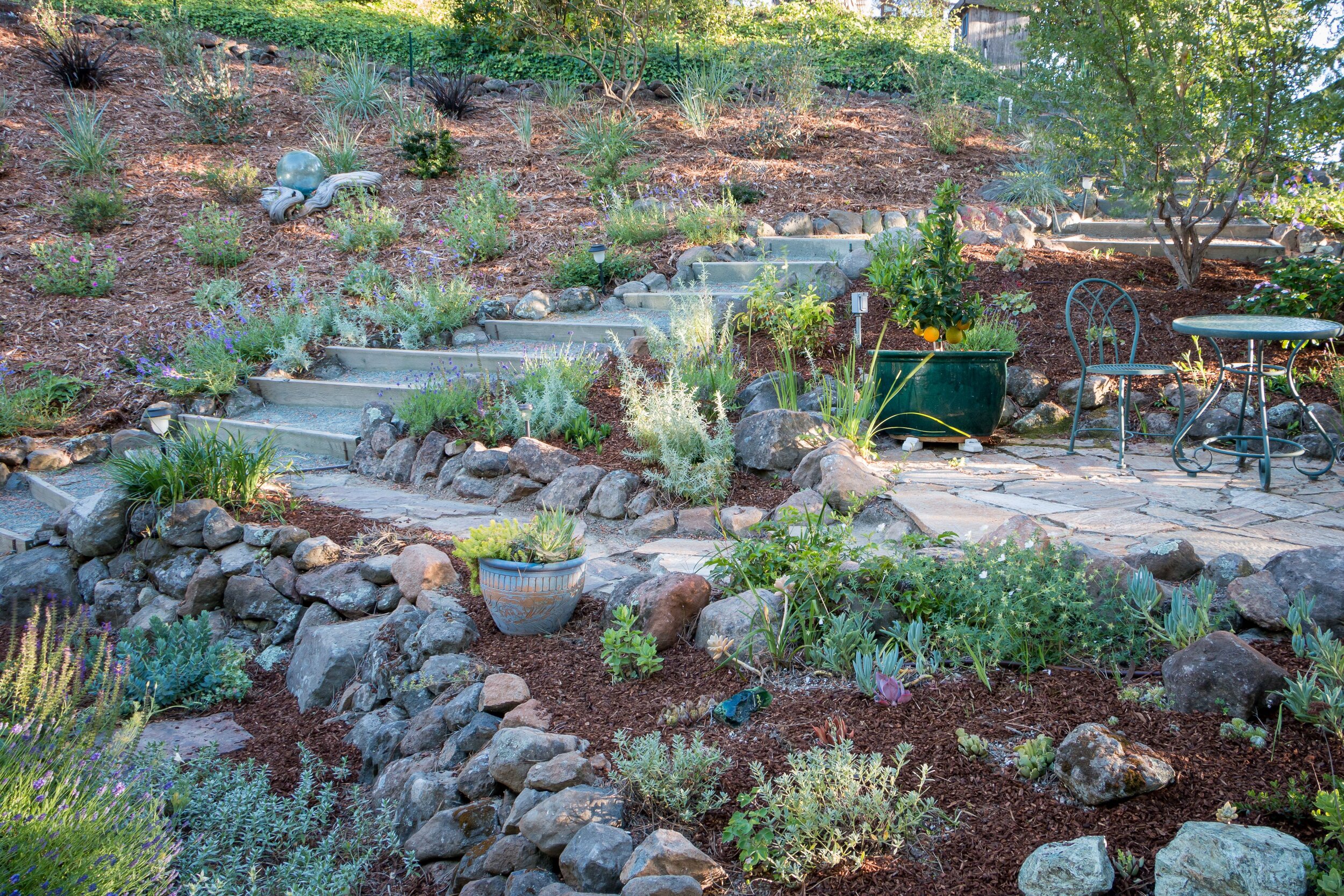
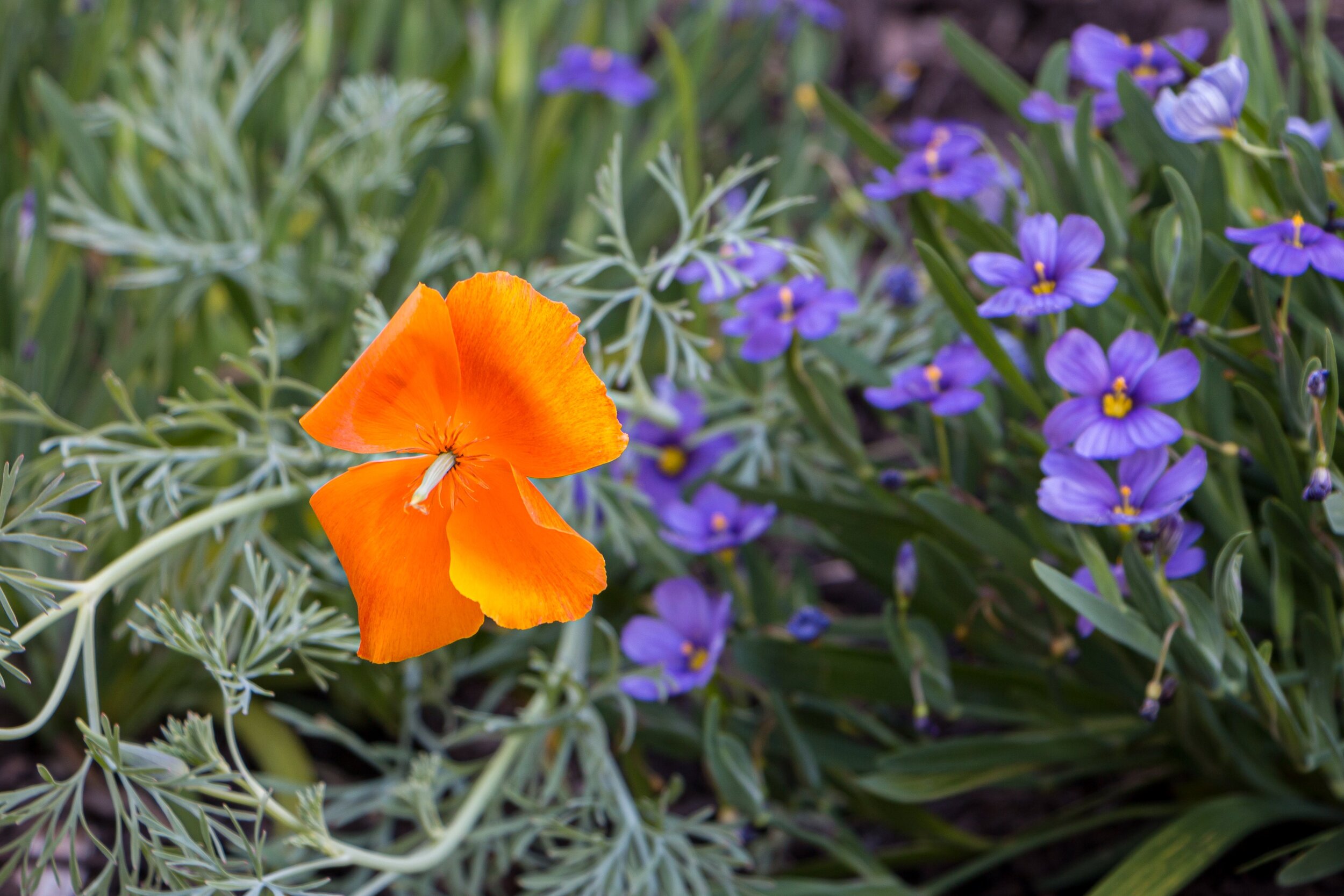

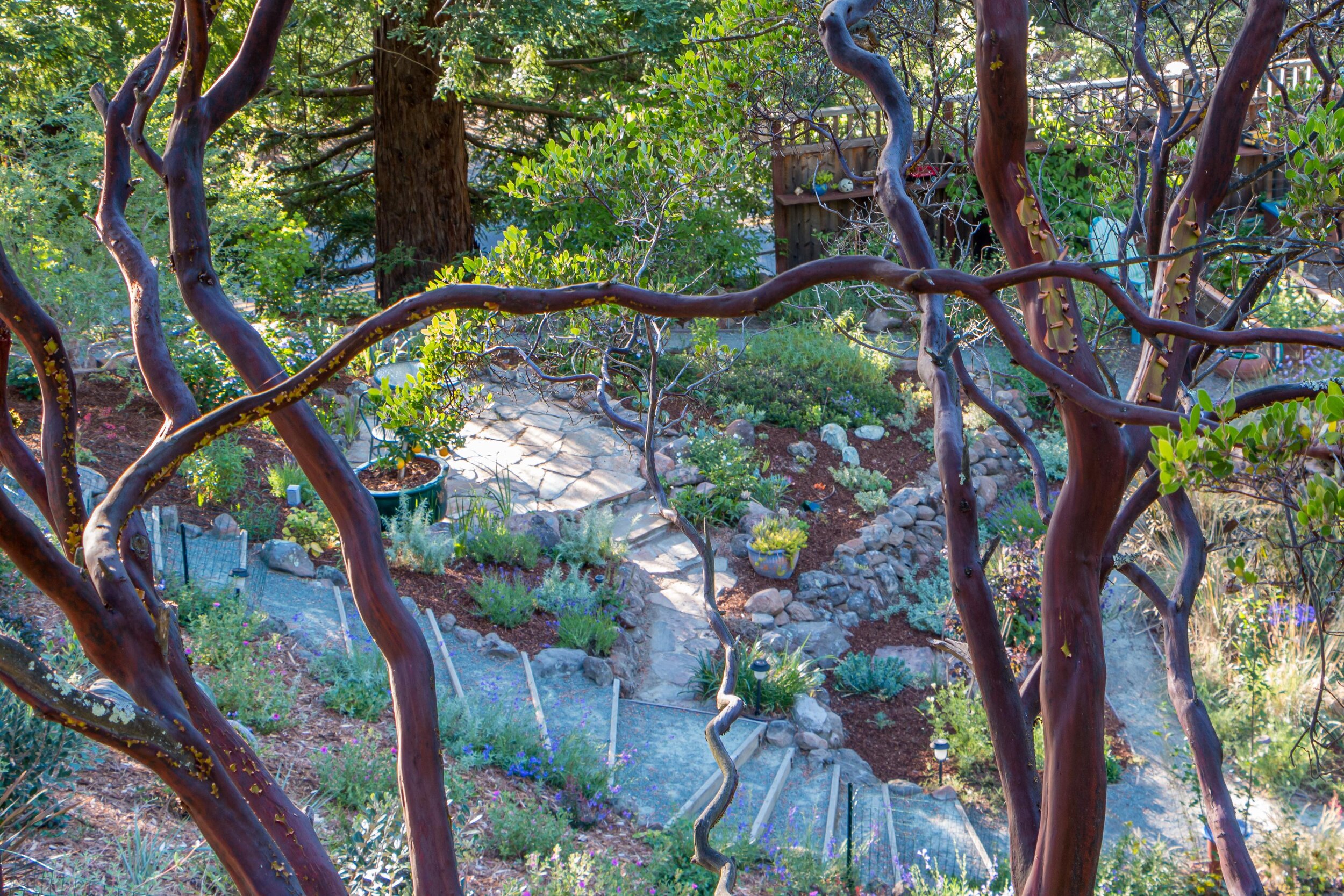
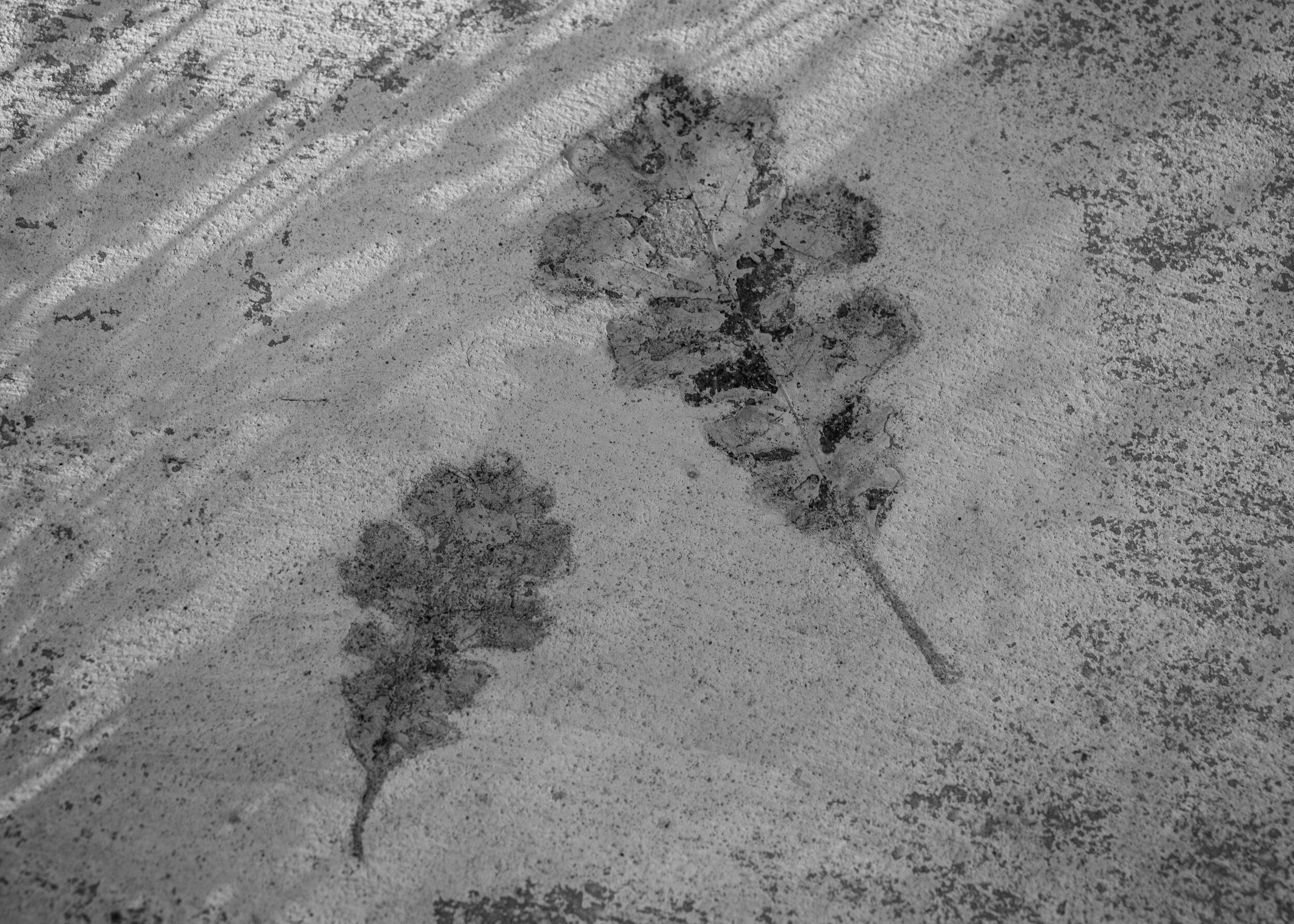
Photos by Jude Parkinson-Morgan.
Native Hillside Garden in Orinda
This quaint cottage garden is perched on a hill under majestic Live Oaks and Monterey Pines of Orinda. The plant palette is a mixture of native Coral Bells, Penstemon, Manzanita and Ceanothus. Spring and summer bring added color of orange Poppies, Blue-eyed grass and orange California Fuchsia.
by Jodie Cook
Jodie Cook Landscape Design
San Clemente, CA
NatureScapes: A Turf-to-Natives Design Program
NatureScape is a turf-to-native garden design program created by APLD member Jodie Cook and Tree of Life Nursery for the Moulton Niguel Water District. This program includes homeowner education as an essential component in addition to the turf conversion. Gardens are based on the watershed approach and all have swales/contouring for rain; many have rain chains and decorative rain barrels, and all are designed with native plants available from our local grower, Tree of Life Nursery.
NatureScapes are usually modest in size, ranging from 250-3000 square feet. Many of these small-garden owners don’t have the information or resources to make this kind of transformation on their own, and may never have gardened before, so we make it easy for them: education, design, plants, installation.
NatureScape has 4 main goals....
1) To give homeowners the opportunity to easily replace their turf with a low-water, ecologically responsible planting design, installed by native plant professionals.
2) To begin to change the gardening culture here in South Orange County from one of ‘hands-off’, yet overly-managed gardens of exotics and lawn to an interactive, lower input one reflective of our region and ecology. This is part of the reason we require front yard installations in our NatureScapes. We will complete a backyard design only if a front yard is included. We want to change the culture, not just install a garden.
3) To educate ‘regular’ homeowners in basic sustainable horticulture principles and to ignite in them a love of gardens, nature, and gardening. With this in mind, the program requires a 3-hour training workshop in ecological landscaping principles, natural watering techniques (swales/rain gardens), and IPM fundamentals before they can qualify for a NatureScape transformation. As part of the transformation, we provide a formal garden coaching session at installation and a post-establishment coaching session 90 days after installation.
4) Another important reason we primarily work with front yards is because they are the source of much non-point-source, dry season pollution in our region. This program has led to additional water district initiatives including a retail nursery education program (because local retail nursery staff are often lacking in information about natives), a yearly garden tour (for community-building), and a maintenance/coaching service for NatureScape gardens. Most NatureScapes are maintained by the homeowners themselves.
Here are a few NatureScape photos:
Garden 1:
BEFORE
AFTER
Garden 2: A typical before/after, except that the lawns usually look much worse. The after is just 3 months old.
BEFORE
after
Garden 3: We also work with homeowners who have larger properties, generous budgets, and are as excited about utilizing natives as we are. This couple are art-collectors and their garden features wonderful antiques we hand-selected from a local dealer who imports art and sculpture. Their property is over 2 acres and is located in San Juan Capistrano. The house was designed by a local architect in the Mission revival style. The garden’s ornamental plant palette is native with food plants such as citrus, pear and apple.
Garden 4: The hand-painted exterior tile colors were chosen to complement the flowers and blue/green foliage of the native plant palette as well as the architecture. The plant palette has some plants that should be utilized more, as they are rare and very beautiful, like the Catalina Silverlace in the photo of the steps at right. This plant is in many NatureScape gardens, too. You’ll see it in the top NatureScape photo.
Garden 5: We also work on ecologically focused homeowner education/demonstration gardens like this one in Laguna Beach, which features a butterfly garden, erosion control demonstration slope, water capture and storage, a swale, interpretive signage, and artwork.
by Shawn Maestretti Shawn Maestretti Garden Architecture, Altadena, CA
Beauty and the Beast: A Fairytale Design
Dream clients, a thoughtful approach, and ethical practices are all ingredients necessary in the recipe for a meaningful project. The positive results are a product of problem-solving, critical thinking, and most importantly, a respect for the land.
Working with native plants can sometimes be hard, and working to restore and heal the earth through landscape design can be even harder. Taking the ecological approach before we embellish a garden may feel counterintuitive to some of us. However, this is where the future of landscape design is headed: a restorative, regenerative direction. Designing with natives is one of the most important practices we can employ, yet it is still just one of the tools in our toolkit.
In 2017, our team was hired to design a native garden for a 1938 Colonial Revival home in Hollywood, CA. From the start, the process was an engaging, creative collaboration with the clients to create a beautiful, sustainable, native habitat. What ended up happening—through the evolution of the design process—was an opportunity to set protocols for all future projects: creatively reuse of most of the materials onsite, incorporate rain gardens and hugelkultur to harvest water, plant the garden with 90% plants indigenous to California, grow food for both human and non-human beings, and change the way many people experience native gardens. We nailed it. Not in a cocky way, but in a “we pulled it off”, very relieved way.
Through our research, we choreographed the spaces and circulation using elements and principles based on well-documented Colonial-Revival designs. These features include axial pathways with focal points, allees of trees, cruciform movement and yes, even parterres. To develop a native plant palette for such formal design, we studied plant communities, testing combinations and consulting with CA native pros like Carol Bornstein. Currently, we are in the process of learning what is working and where we need to make adjustments. Fortunately, most of it is working, beautifully.
Some of the most exciting features in the garden are our hugelkutur berms built from the sick, drought-stressed trees along with all of the demolished plants and green waste from the initial site clearing. Repurposing materials on the project started off to be a bit frustrating and then proved to be just another part of the design puzzle. When working with the existing hardscape materials, the solution was creative saw-cutting—a mosaic-like approach to fitting pieces together and doing our best to keep everything possible onsite—thus bringing carbon-consciousness to the next level for ourselves and our clients.
With tremendous pride, we can announce we have been selected for the Theodore Payne Garden Tour in 2020 where we will be leading tours and discussions. Our hope is to share this work and inspire as many professionals and communities as possible.
by Leesa Martling
Leesa Martling Landscapes
Los Angeles, CA
Ode to Rhamnus californica
Rhamnus californica or Frangula the new name
A native plant an evergreen that deserves a little fame
Leaves elliptic in shape with yellow, red then black berries so handsome
A generous shrub it feeds our native birds and beasts at random
Coffee berry the common name but a brew I wouldn’t make
Instead a tough and shapely form a shrub so strong and quaint
One could build a garden around its strengths and quiet beauty
Such cultivars as Mound San Bruno or Eve Case will surely do their duty
Frangula a sturdy choice indeed you may prune it so as not to grow a tree.
I’m quite confident to plant this shrub in the valley also near the sea
An adaptable native that can thrive in both oak knolls and windy bluffs
It will take in most of our state but without that plaintive huff
“Cali’s can be so tough”……enough!
Photo courtesy of Jude Parkinson Morgan.
Welcome New Members
Please give a warm welcome to these new members of the APLD California Chapter.
Qualified Professional Members
A landscape designer who engages in the practice of landscape design for monetary compensation and contains more than 3 years of professional landscape design experience. Documentation of education and experience is required.
Carley Gethin
Wild Canyon Landscapes
Santa Monica, CA
Professional Members
A landscape designer who engages in the practice of landscape design for monetary compensation and contains more than 3 years of professional landscape design experience. Documentation of education and experience is required.
Don Schneider
Designs by Don
Santa Cruz, CA
James Fahy
Deep Rooted Designs Inc.
San Diego, CA
Emerging Professional Members
An individual who has been practicing landscape design for one to three years and is starting a career in landscape design. Membership requires affirmation of education and experience, but not documentation.
Molly Roy
Everyday Ecology
Sacramento, CA
Allied Members
An individual practicing in a related and/or associated field to landscape design.
Jack Berokoff
Koi-ology Unlimited LLC
La Habra, CA
Katherine Spitz, AIA, ASLA, LEED AP Katherine Spitz Associates, Inc.
Pebble Beach, CA
Student Members
An individual who is actively enrolled, on a full or part‐time basis, in a landscape design, landscape architecture or horticulture program. Membership is limited to five years of membership at this level and proof of enrollment must be submitted.
Steven van Dongen, Santa Cruz, CA
Amy Rouillard, La Mesa, CA
Photo courtesy of Jude Parkinson Morgan.
News and Events from the APLD Bay Area District
Upcoming Events:
APLD Bay Area District Designer Spotlight Series:
APLD 2019 Award Winning Designers Nina Mullen and Linda Middleton
Two award winning APLD designers talk about their work and the projects that won them APLD’s International Design Awards in 2019.'
Tuesday, January 14, 2020 from 3-5PM
At the Veterans Memorial Center, 3780 Mt. Diablo Blvd., Lafayette
More Info Here
APLD Bay Area District Business Series:
The Business of Landscape Design: Demystifying Online Marketing
A panel of Bay Area landscape designers will discuss why and how to use online marketing channels such as Facebook, Instagram, Twitter, Pinterest, Houzz, Yelp, and more to showcase your work and grow your business.
Wednesday, February 5, 2020, from 3-5PM
At the Gamble Garden, 1431 Waverley Street, Palo Alto
More Info Here
APLD Bay Area District Speaker Series:
Designer Pollinator Plants with Janet Sluis
Janet Sluis, horticulturist, program developer, and curator for Sunset Western Garden Collection will share her favorite plants for beneficial insects in the Bay Area.
Wednesday, March 4, 2020, 3-5PM
At the Veterans Memorial Center, 3780 Mt. Diablo Blvd., Lafayette
More Info Here
APLD Bay Area District Special Event:
APLD Everything-But-The-Plants Vendor Fair
Vendors from all over CA come together to share their favorite products & services for landscape designers.
Wednesday, March 25, 2020, 1-5 PM
At Mitchell Park Community Center, 3700 Middlefield Road, Palo Alto
More Info Here
APLD Bay Area District Speaker Series:
Landscape Lighting for Designers with Mark Natale
Come and learn about all the techniques that landscape designers need to know for professional landscape lighting design.
Wednesday, April 1, 2020, 3-5PM
At the Gamble Garden, 1431 Waverley Street, Palo Alto
More Info Here
APLD Bay Area District Author Series:
Private Gardens of Santa Barbara with Margie Grace, APLD
APLD award winning designer Margie Grace, APLD will talk about her new book Private Gardens of Santa Barbara.
Wednesday, May 6, 2020, 3-5PM
At the Veterans Memorial Center, 3780 Mt. Diablo Blvd., Lafayette
More Info Here
APLD Bay Area District Author Series:
Japanese Design Concepts in Today’s California Gardens with Lisa Paramore
Japanese garden design is alive and well, but current realities mean adaptations are necessary. How can we best incorporate Japanese design elements into contemporary spaces? Lisa will discuss various approaches to Japanese garden design, and the factors that are changing the way we create Japanese gardens. Some of these factors include a retiring workforce of skilled Japanese gardeners, changes in the availability of traditional plants, and California’s water-use restrictions on new gardens.
Wednesday, June 3, 2020, 3-5PM
At the Gamble Garden, 1431 Waverley Street, Palo Alto
More Info Here
APLD Bay Area District Special Event:
The 4th Annual APLD Bay Area Designer Plant Fair
If you are a plant geek, you’ll want to be at this event! The last three APLD Designer Plant Fairs were a huge success, with over 100 attendees, more than a dozen growers and nurseries presenting new plants, and so many give-a-ways! This year the space will again be twice as large, with even more growers and nurseries, more food & drink and more time to soak it all in! Browse and mingle with the vendors & other landscape professionals, enjoy refreshments and learn details about the plants during a presentation session with the vendors... each followed by a raffling of plants!!
Wednesday, August 12, 2020, 2-7 PM
At the Veterans Memorial Center, 3780 Mt. Diablo Blvd., Lafayette
More Info Here
APLD Bay Area District Author Series:
Gardening in Summer-Dry Climates with photographer Saxon Holt
Join us for a talk with renowned garden photographer Saxon Holt as he discusses his new book Gardening in Summer-Dry Climates which takes on the issues facing garden designers who work in areas with summer drought. Inspiring photos by Saxon showcase gardens that remain lush even with restricted summer water. The book includes discussions on topography and climate, as well as the threat of wildfire. With an A-Z index of recommended plants and their cultural conditions, this book will be an excellent reference for anyone designing gardens in Mediterranean climates.
Wednesday, October 7, 2020, 3-5PM
At the Veterans Memorial Center, 3780 Mt. Diablo Blvd., Lafayette
More Info Here
An Event from the APLD Greater Los Angeles District
FRUITSTITUTE, FRUIT TREES FOR THE SOCIAL LANDSCAPE
Saturday, January 18, 2020, 10 AM-12 PM
More Info Here
News and Events from the Sacramento District
Update & What’s Next?: Watershed Wise Landscape Professional (WWLP) Training
APLD CA and its members are ardently embracing the principles of the Watershed Approach to Landscapes. Here’s an update on what we’ve accomplished so far and what’s next. In 2018, the California Watershed Approach to Landscape Design handbook was published and put into the hands of our members.
Next, a successful US EPA WaterSense labeled certification training session, taught by Pamela Berstler of the Green Gardens Group (G3), took place in West Sacramento on November 7 & 8, 2019. Forty-seven APLD CA members and professionals who design, install, maintain, and manage landscapes attended this intense training.
We learned so much about soil health and how we can create and maintain life-filled soils. We stepped through a multitude of equations to determine plant water requirements, irrigation scheduling, irrigation system auditing, water budgeting, rainwater harvesting and more! Once we wrapped our heads around all those acronyms (TLA, PAW, MAD, IWR, ETo, DPWR, DU, TIRT – to name a few!), participants really enjoyed the small- and whole-group exercises!
In addition to the APLD California Chapter’s generous support and that of our fabulous Sponsors, this WWLP training was made possible thanks to contributions by the City of West Sacramento, City of Roseville Environmental Utilities, Regional Water Authority’s Water Efficiency Program, and the California Water Efficiency Partnership – A Chapter of the Alliance for Water Efficiency.
So you may be asking, What’s Next?
Show the Flow Tour
An Educational Tour to Demonstrate the Watershed Approach to Landscaping & Stewardship in Action
Saturday, March 21, 2020
The Sacramento District is planning this mid-March 2020 tour. This is not your typical “landscape tour”. The Show the Flow is an educational exploration of public, commercial, and private landscapes where professionals and subject matter experts will tell the story of each landscape and the best practices used for designing and building resilient landscapes that sequester water and conserve resources. Thanks to the Chapter’s support, a video documentary will be produced as an ongoing educational tool.
Tour Objectives: Raise awareness, educate, and motivate professionals, suppliers, maintainers, and policy makers to take action and become watershed stewards. From the tiniest bungalow, to native grass bioswales with ancient Valley Oaks, to the Regional Sanitation’s Bufferlands restoration sites, each watershed is interconnected.
Stay tuned for more information about the March 2020 Show the Flow Tour because watershed stewardship is the responsibility of everyone who touches and impacts landscapes.
News & Events from the San Diego District
by Andrea Doonan,
APLD San Diego District President 2020
Greetings APLD CA! I’m super excited to be taking the reigns of the SD district in 2020. Our board a wonderful group of motivated people I’ve gotten to know over the past couple years and I am honored to be part of this network of amazing designers. I’m looking forward to connecting with more of you this year and beyond.
We have a lot in store for this winter. Right now we are focusing on our big two day symposium this February: Sharpen Your Vision 20/20, link here. The first day will take place at our very own San Diego Botanical Garden with an excellent line up of speakers plus a docent led tour of the garden; the second day will be permaculture focused tours including a farm to table brunch at Coastal Roots Farm. Our special events team Lisa Bellora and Angela Benson have been doing an amazing job organizing this event and we’d love to see you there! We’re also putting on a special workshop at Balboa Park’s Japanese Friendship Garden on stone composition. Lastly, I’m especially excited to join Greater LA back in Palm Springs for Modernism Week again this February. If you haven’t been, I recommend putting it on your list. So much fun to be in all the buzz of talks and tours at the mecca of mid-century modern architecture and design. It’s a blast.
APLD SAN DIEGO DISTRICT PRESENTS
JAPANESE STONE COMPOSITION:
The Secrets in Stones
This APLD workshop will focus on the traditional Japanese setting of stones with the aim of creating compositions that can be incorporated into many styles of gardens. Emphasis will include principles of composition and techniques for placement as well as hands-on exercises in the classroom using design boxes and small stones.
Saturday, January 11, 2020 from 8:30 AM to 3:00 PM
at the Japanese Friendship Garden
2215 Pan American Road East, San Diego, CA 92101
More Info Here
APLD SAN DIEGO DISTRICT PRESENTS
Sharpen Your Vision 20/20: keep the environment in focus!
This is a 2-day event to be held on Saturday, February 22 at the San Diego Botanic Garden in Encinitas, and on Sunday, February 23 at various locations in North San Diego County.
The conference will showcase expert speakers, a garden tour of the renowned San Diego Botanic Garden, a farm-to-table brunch, and tours of local permaculture and food farms. This event is curated for landscape designers, contractors, green industry professionals, and garden enthusiasts.
Saturday and Sunday, February 22–23, 2020
San Diego Botanic Garden
230 Quail Gardens Drive, Encinitas, CA 92024
More Info Here
Welcome New Members
Please give a warm welcome to these new members of the APLD California Chapter.
Qualified Professional Members
An individual who is a landscape designer and has more than three years of professional landscape design experience. Membership requires documentation of education and experience.
Carola Fiore
Crear Landscape Design, San Diego, CA
Srvidya Krishnan
Fill Good Horticulture, LLC, Diamond Bar, CA
Emerging Professional Members
An individual who has been practicing landscape design for one to three years and is starting a career in landscape design. Membership requires affirmation of education and experience, but not documentation.
Chelsea Chan
David Thorne Landscape Architect, Inc, Oakland, CA
Kelly LeVoir
Encinal Nursery, Alameda, CA
Olga Dobrowolska
Artistic Garden Designs, Cotati, CA
David Meirik
MD Landscapes, Santa Rosa, CA
Student Members
An individual who is actively enrolled, on a full or part‐time basis, in a landscape design, landscape architecture or horticulture program. Membership is limited to five years of membership at this level and proof of enrollment must be submitted.
David Cruz Martinez, Oceanside, CA
Jennifer Bromme, Pacifica, CA
Karly Silicani, Walnut Creek, CA
Kirby Baldacci, Oakland, CA
Photo courtesy of Jude Parkinson Morgan.
APLD California Chapter
Sponsors
Through sponsorship of APLD California Chapter, these industry leaders declare their support for best practices, educational programs and events, and the highest standards in landscape design. From veteran materials suppliers to producers of cutting-edge landscape products, these companies have committed to connecting with professional landscape designers and our clients.
The APLD CA Chapter 2020 Sponsorship Drive has begun
and we would like to welcome two brand new sponsors!
our newest Platinum Level Sponsor:
At Humboldt Redwood, we grow more redwood than we harvest annually while practicing wildlife habitat conservation that provides clean air, fresh water, and natural habitats for plants and animals.
We are working to cultivate a lasting legacy of environmentally responsible forestry. Our commitment is to the environment first and foremost. With great care and effort, sustainable redwood is produced for your projects.
Redwood is a favorite material among architects, designers, builders, and other specifiers because of its natural strength, beauty, and overall performance characteristics as a sustainable building material. Humboldt Redwood is pleased to provide the following redwood architectural information resources for building professionals to learn more about application details, technical and engineering data, as well as AIA courses that provide insight into specifying redwood as a sustainable building product.
Find out more about this great vendor at https://www.getredwood.com/
our newest GOLD Level Sponsor:
Bamboo Sourcery received the Environmental Business Alliance’s Best Practices Award of 2010 in recognition of our efforts to reduce our environmental footprint, while enabling us to save money at the same time. Over the years we have initiated a number of water and energy conservation efforts, as well as waste reduction efforts, and it is wonderful to receive recognition for them.
Here is a partial list of our environmental efforts:
In late 2006 we installed a large PV solar system that powers our sizable irrigation system and 3 households on the property. It saves us approx. $7,000 per year, and it paid for itself in 8 years! You can see our solar system up the hill and directly above the main greenhouses.
We hand water our entire 7.5 acre farm. Hand watering, though labor intensive, is by far the most water-efficient irrigation system due to our variable and uniquely steep terrain.
We reuse and recycle plastic nursery pots and rarely purchase them new. We buy used nursery pots from local landscapers and continue to reuse them as long as possible. This reduces the amount of petrochemicals used in our operation and takes a large number of pots out of the waste stream.
We make it a priority to buy locally whenever we can, and to buy post-consumer recycled materials whenever possible. All of our root barriers are made of 100% post-consumer recycled polyethylene.
Bamboo Sourcery uses no pesticides or herbicides. When necessary, we spray very dilute laundry detergent for aphids and mites, and we pull and mow weeds as needed.
In addition, bamboo itself has many environmental benefits. Bamboo is very effective at removing excess nitrogen, metals and other toxic substances from soils and water. Bamboo also produces 35% more oxygen and consumes 4 times more carbon dioxide than a forest of young trees. So planting bamboo, in addition to growing a beautiful plant for privacy screens and garden highlights, can actually help slow global warming!
Learn more about our NEW GOLD SPONSOR at http://bamboosourcery.com/
Bay Scenery specializes in delivering high-quality landscape construction services in and around Silicon Valley. Through the acquisition of well-known companies such as Harris Landscaping Company, we have cultivated a reputation for excellence in landscape construction for over 30 years.
OUR GOLD SPONSORS:
Simply click on a logo below to visit the website of one of our sponsors.
OUR SILVER SPONSORS:
OUR BRONZE SPONSORS:
Please contact Julie Molinare at sponsorship@apldca.org
Photo courtesy of Jude Parkinson Morgan.
Opportunities and Events
APLD or APLD Sponsor events in BOLD.
JANUARY
New Directions in the American Landscape (NDAL) Annual Symposium
Pennsylvania
January 9-10, 2020
Japanese Stone Composition: The Secrets in Stones
An APLD San Diego District workshop with Ken Siers
January 11, 2020
Gardening with Proteaceae Workshop
Ruth Bancroft Garden
January 11, 2020
APLD Award Winning Designers: Nina Mullen & Linda Middleton
An APLD Bay Area District presentation in Lafayette
January 14, 2020
Ecological Landscape Alliance Webinar: Reconnecting Water, Soils and Vegetation: Green Infrastructure in the Urban Environment
January 15, 2020
Ecological Landscape Alliance Webinar: The Role of Landscape in Our Global Environmental Crisis
January 20, 2020
A Tale of Two Floras with Evan Meyer for the CA Horticultural Society
San Francisco, CA
January 20, 2020
Qualified Water Efficient Landscaper Training (QWEL) Training
Santa Rosa, CA
January 23, 24, 31 & February 7, 2020
Northern California Home & Landscape Expo
Sacramento, CA
January 24-26, 2020
FEBRUARY
The Business of Landscape Design: Demystifying Online Marketing
An APLD Bay Area District presentation in Palo Alto.
February 5, 2020
APLD Webinar: Climate Reality – Designing Regenerative Landscapes with Shawn Maestretti
February 5, 2020
Adapting to Rising Sea Levels Using Nature’s Jurisdictions, a Lecture with Julie Beagle
UC Berkeley
February 12, 2020
Tomato Mastery: Best Practices for Productivity and Healthy Plants with Cynthia Sandberg for Western Hort
Los Altos, CA
February 12, 2020
Modernism Week
Palm Springs, CA
February 13-23, 2020
Qualified Water Efficient Landscaper Training (QWEL) Training
Fountain Valley, CA
February 13 & 27, 2020
Sharpen Your Vision – Keep the Environment in Focus
A two-day APLD San Diego District event
February 22-23, 2020
Garden Conservancy Speaker Series: Aaron Bertelsen, Lessons from Great Dixter
Los Angeles: February 23, 2020
San Francisco: February 25, 2020
Ecological Planting Revolution: Can Landscape Architecture meet the needs of a world in crisis, a Lecture with Thomas Rainer
UC Berkeley, CA
February 26, 2020
Nor Cal Landscape & Nursery Show
San Mateo, CA
February 27, 2020
MARCH
Designer Pollinator Plants with Janet Sluis. An APLD Bay Area District Speaker Series
Lafayette, CA
March 4, 2020
Garden Conservancy Speaker Series: Alexandre de Vogue
Woodside, CA
March 8, 2020
Garden iPhoneography Workshop
Ruth Bancroft Garden
March 7, 2020
Build It and They Will Come: Creating a Native Garden Buzzing with Pollinators, a lecture with Juanita Salisbury for Western Hort
Los Altos, CA
March 11, 2020
Firescaping Workshop
Ruth Bancroft Garden
March 14, 2020
Ecological Landscape Alliance Webinar: Protecting Pollinators
March 23, 2020
APLD Bay Area EVERYTHING But-the-Plants VENDOR FAIR
Palo Alto, CA
March 25, 2020
APRIL
Landscape Lighting for Designers. An APLD Bay Area District presentation
Palo Alto, CA
April 1, 2020
Pacific Horticulture tour ‘Mystique of Morocco’
April 3-15, 2020
The Shape of the Land: Aesthetics and Utility Symposium
UC Berkeley, CA
April 7-8, 2020
Designing with Palms with Jason Dewees for Western Hort
Los Altos, CA
April 8, 2020
National Watershed & Stormwater Conference
Austin, TX
April 14-17, 2020
Vectorworks Design Summit
San Diego, CA
April 22-24, 2020
MAY
Private Gardens of Santa Barbara, An APLD Bay Area District Author Series with Margie Grace
Lafayette, CA
May 6, 2020
Dry Gardens: High Style for Low Water Gardens with Daniel Nolan for Western Hort
Los Altos, CA
May 13, 2020
Pacific Horticulture tour ‘The Sikkim & Darjeeling Himalayas’
May 16-30, 2020
San Diego Botanic Garden Palm, Cycad, Bamboo and Tropical Plant Sale
May 30, 2020
JUNE
Japanese Design Concepts in Today’s CA Gardens, An APLD Bay Area District Author Series with Lisa Paramore
Palo Alto, CA
June 3, 2020
Garden Masters: The Art of Outdoor Living with Scott Shrader
Beverly Hills, CA
June 22, 2020
Pacific Horticulture tour ‘Botanical Alaska 2020’
June 25-July 5, 2020
Contributors to Winter 2020 Edition:
Leigh Adams
John Black, APLD
Jodie Cook
Francesca Corra, APLD
Peigi Duvall, FAPLD
Andrea Doonan
Mary Fisher, FAPLD
Jeannie Fitch
Mary Lou Hadley
Content Coordinator: Mary Fisher, FAPLD
Design and Content Editor: Maggie J Elias
Call for Submissions
We invite your participation in the California Landscape Design magazine Spring 2020 edition with a theme of "Garden Allies: wildlife/habitat/beneficials, etc.". Please send your story ideas to newsletter@apldca.org before February 1, 2020.






























































